When to visit Venice

May 15, 2023 • 4 min read
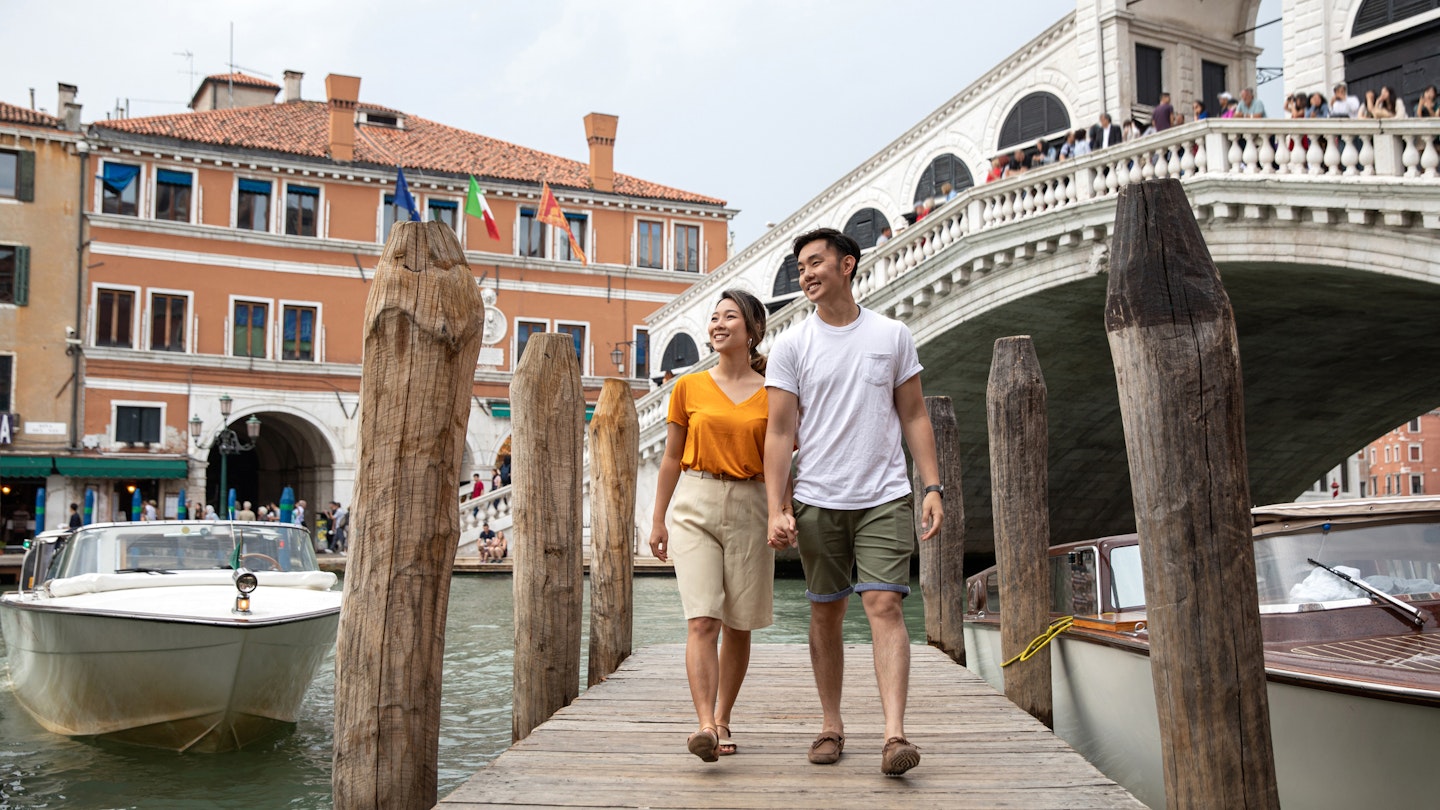
Find the perfect time for your visit to Venice with our guide to events in the city through the year © LeoPatrizi / Getty Images
There isn't a true low season in Venice . Not really.
The Serenissima is so unique and so famous that the desire to see it with one’s own eyes knows no seasonal limit. Every time of the year has its pros and cons – as well as different activities and events to enjoy up and down the canals – but there isn’t really a bad time to visit.
From festivals like Carnevale to the quieter winter months, we pick through the best times to visit Venice.
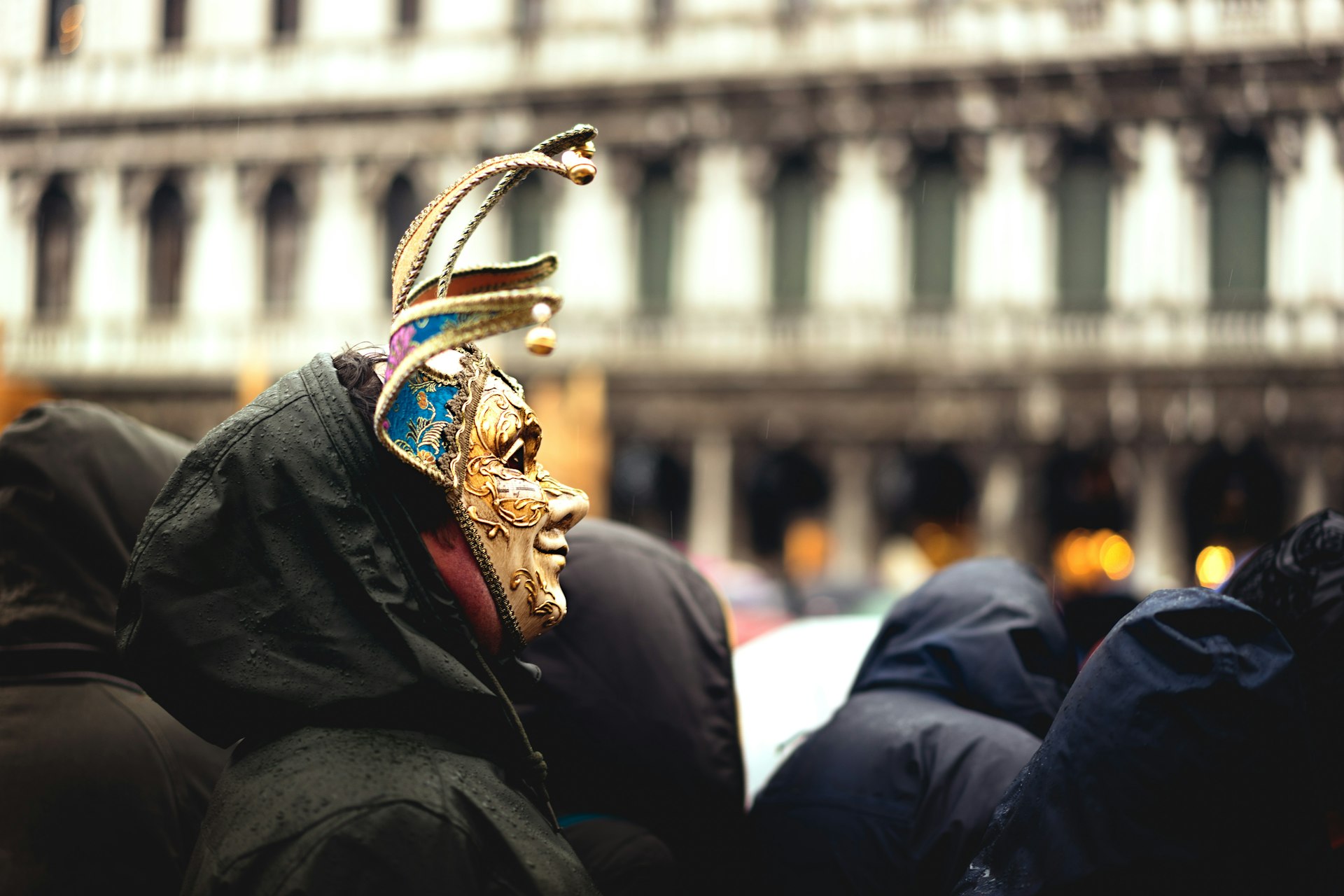

May to October hosts the best Venetian festivals
This is when Venice is at its best: with nice weather and sun lasting long past 8pm. The closer to summer it gets, the more tourist numbers and prices rise but the best free things to do in Venice can help you keep within your budget. At the height of summer, the weather crosses the threshold from nice to stiflingly hot – something to be aware of if you’re planning to explore the city on foot . The crowds arrive for Carnevale (held on Shrove Tuesday) in spring too.
May is almost summer, and the whole city is alive with the knowledge that the warmest months are fast approaching. Events begin to pop up and gather crowds – the chief among all being the Biennale, which has been celebrating visual arts since 1895. June is the start of high season and tourists begin to pour in, especially once schools officially close down for summer break around the middle of the month. If the main tourist spots get too much, consider seeking out one of Venice's less-trafficked neighborhoods .
Even though the weather will begin to feel stifling in July, Venice is still bustling – get yourself a good spot among the other visitors for the Festa del Redentore (third Sunday of July) fireworks. If the crowds really get too much, consider a day trip outside the city . A good way to deal with the sun beating down on your head is to make the most of it while lying down at one of the many beaches of the Lagoon, both in and around Venice .
September is one of the best months of the year – the heat dwindles, but the weather is still great, and it makes for an excellent set-up to enjoy the last moments of the warm season. Then, come October, fall has arrived. There are some good days, but it’s also when the possibility of acqua alta looms on the horizon. Pack rain boots just in case.
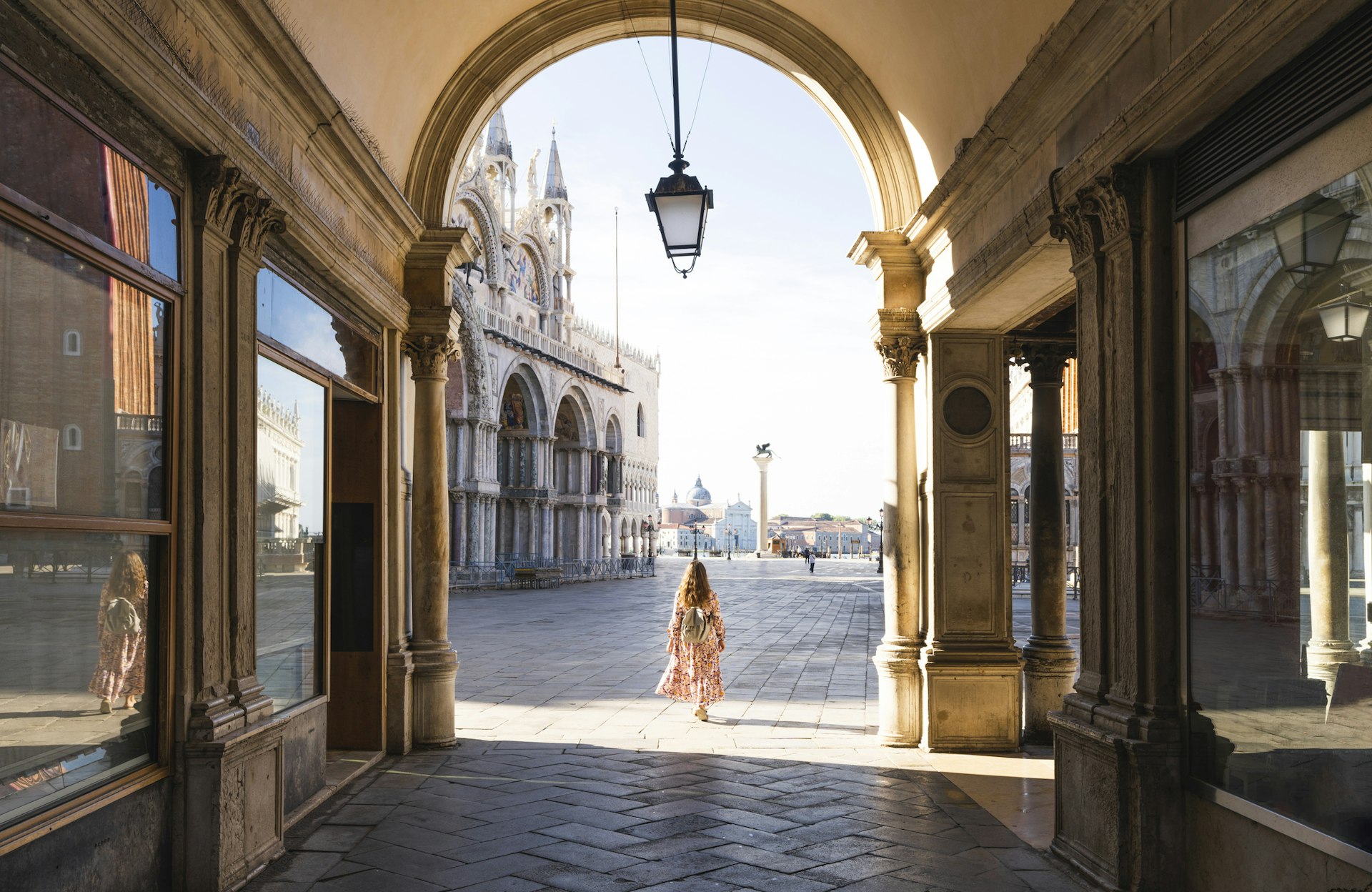
Go in March to April for cooler weather
If you thought the city emptied out after the revelries of the Carnevale, think again. With days getting longer and the weather getting warmer, people are again out and about on the bridges and canals. The spring months are the best choice if you want to do plenty of exploration without too much sun beating down on your head (and don’t mind getting caught in the occasional rain shower).
April is the true start of the spring season. Centuries-old celebrations like St Mark’s Day make for quite the photogenic stay. A trip around Easter time will also ensure you see your fair share of the best Venice has to offer , as the days of the Holy Week are always dotted with celebrations and ceremonies – but keep in mind that schools close in Italy for Easter, and there might be a lot of tourists coming in for a weekend trip.
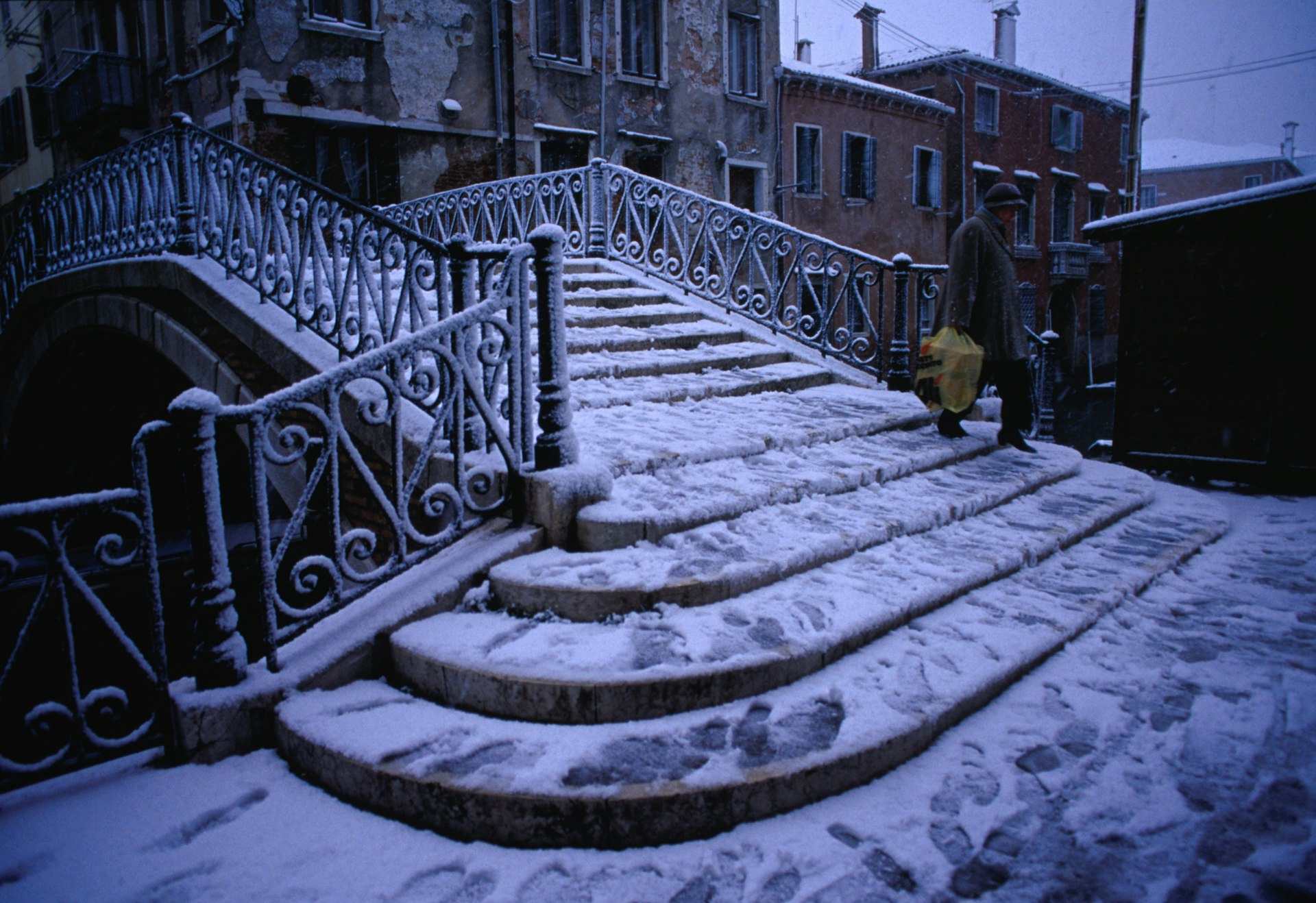
November to February is the best time for budget travelers
With the exceptions of Christmas and New Year’s Eve, the colder months are as empty as they can be in a city like Venice – with school and work in full swing, tourist numbers are much lower than they are in June and July.
A lack of travelers doesn’t mean the city is less lively. The Festa della Madonna della Salute brings the lagoon alive in late November, where stalls line the canals and a candlelit procession crosses a bridge of boats to reach the Salute.
Over Christmas the area around the Rialto Bridge glimmers with lights and markets, but it is in January for the Regata delle Befane – the boat race where participants dress as witches – that visitors will want to find a viewing spot on the infamous Ponte di Rialto.
The costumes continue at the world-famous Carnevale, a riot of color and concealment, the February coming together is the final throes of winter before the mask slips and spring in the city begins to unfurl.
This article was first published Oct 4, 2021 and updated May 15, 2023.
Explore related stories
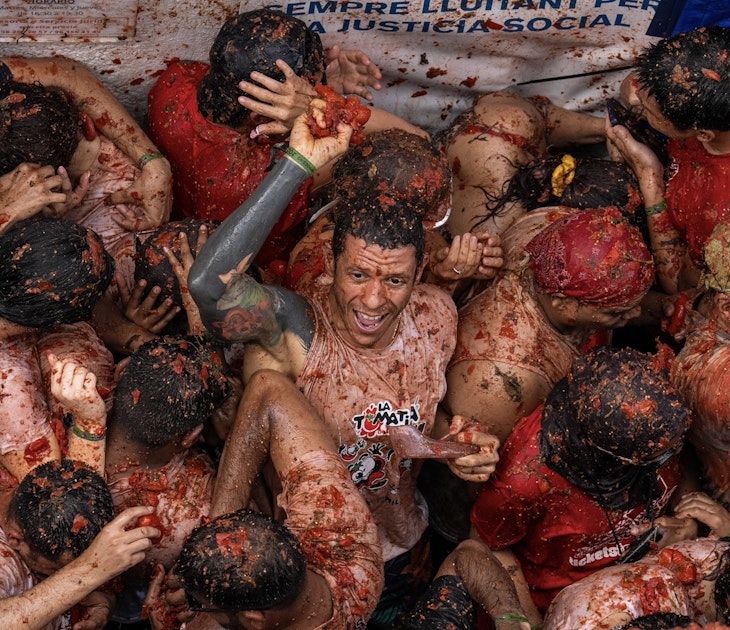
Festivals & Events
May 3, 2024 • 6 min read
Here’s everything you need to know about the tomato-throwing extravaganza that takes place every August in Spain.
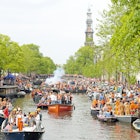
May 2, 2024 • 5 min read
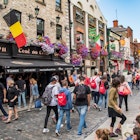
Apr 14, 2024 • 6 min read
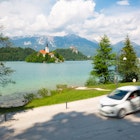
May 4, 2024 • 6 min read

May 4, 2024 • 16 min read
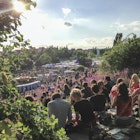
May 4, 2024 • 5 min read

May 4, 2024 • 4 min read
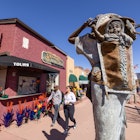
May 4, 2024 • 8 min read

May 4, 2024 • 17 min read

Touropia Travel
Discover the World
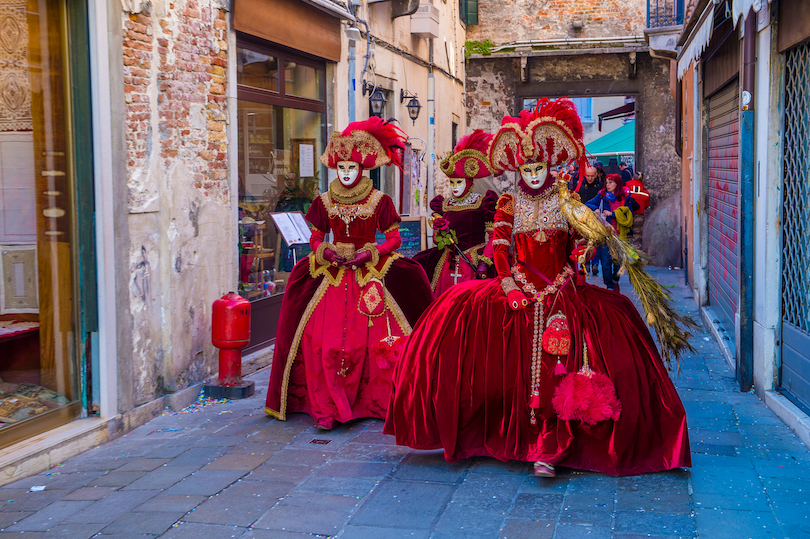
Best Time to Visit Venice: Month-by-Month Guide
By Alex Schultz · Last updated on April 3, 2024
While it is one of the most beautiful, romantic cities in the world, Venice’s huge crowds and high prices can sometimes make visiting a little less special. What’s going on in the city and its weather also has a massive impact on people’s experience exploring La Serenissima.
As it is a must-see destination for many, Venice is often inundated with visitors – just like its streets and squares in winter when they often flood. While the canals, bridges, churches and palaces always look incredible, there are, of course, quieter, calmer times to visit. Summer now is almost too full with its scorching heat also making walking around uncomfortable.
To help you plan your trip, let’s take a look month-by-month at what to expect in the Queen of the Adriatic in terms of its climate, crowds and cultural events.
What’s the Weather Like in Venice?
Lying in Northeastern Italy in the Veneto region, Venice is built atop 118 islands in a lagoon, adjoining the Adriatic Sea. As it is surrounded by water, it is not uncommon for everywhere to flood for a few hours at high tide during the winter months. This is known as acqua alta.
Apart from this phenomenon, the city sees regular rainfall throughout the year, each month averaging between 9 and 13 days. While its winters are cold, grey and foggy, summers are hot and humid. Temperatures in July and August average around 27 to 28°C (80 to 82°F) with their highs often being unbearable.
With ample sunshine, lots of hours of daylight and warm temperatures, spring and autumn are perhaps more comfortable weatherwise. They are not as good though for sunbathing or swimming at the Lido.
Best months to visit Venice

Although July and August are the most popular months to visit due to the summer holidays, the high heat, humidity and crowds can make exploring the city unpleasant. Its main sights, squares and museums are all packed with hotel rates and airfares being more expensive.
As they are a bit calmer and cheaper but the weather is still good, both spring and autumn are great times to visit. There is still a very vibrant feel about town with numerous festivals also taking place.
Other high points of the year include both Christmastime and carnival. Around these hugely important events, thousands of people pour in, come to celebrate and partake in all the fun festivities.
Venice in January
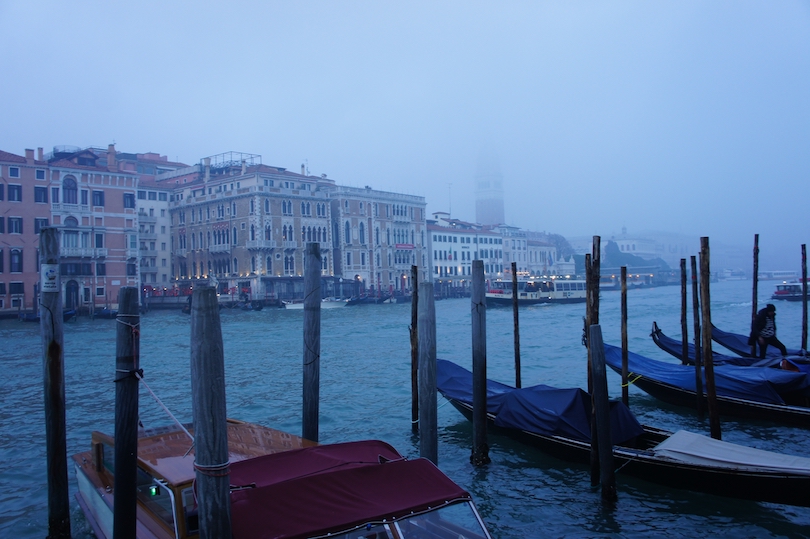
As it lies in between Christmas and carnival and is cold, foggy and grey, January is the least popular month to visit Venice. If you don’t mind the weather, exploring the almost deserted city can be very atmospheric in the gloom. At times, you may have to make your way about raised walkways if the acqua alta floods its lower areas.
Besides benefiting from the cheaper hotel prices, there are no crowds in the alleys or at any of its attractions. Some may have reduced opening hours, however. Aside from a couple of Christmas markets that are still around the first week, there is the Feast of the Epiphany to attend. Bonfires and concerts are held while a rowing regatta races along the Grand Canal.
Venice in February

February in Venice is all about one thing: its world-famous carnival. For two weeks, colourful costume-clad partygoers wearing masks amble about the city with opulent balls, boat parades and street fairs all taking place. Prices shoot up around this time as millions of people come to enjoy the unforgettable event.
As temperatures hover around 9°C (48°F), you’ll have to wrap up warm when exploring the Floating City. While it is the driest month, the bora winds create quite a chill, coming off the cold canals. At Campo San Polo, you can even ice skate if you like! Apart from carnival, February is the off-season so there are fewer crowds and prices are cheaper.
Venice in March
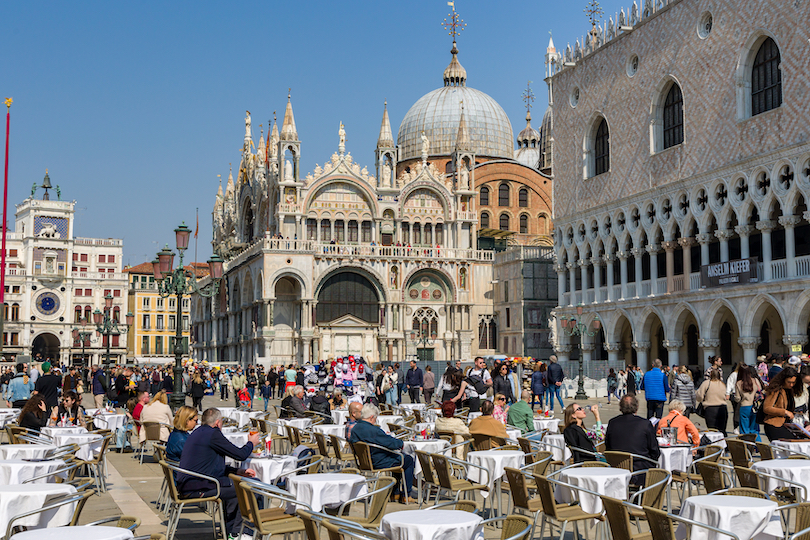
As the weather starts to improve, tourists slowly start to trickle back to Venice. March is the last quiet, more affordable month before the city is overrun at Easter and in summer. With a bit more sunshine and warmth to its days, spring can be a wonderful time to visit. You’ll still need to layer up though with many sights also still closing earlier.
Other than making the most of the shorter lines and relaxed atmosphere, it’s not a bad idea to take trips to popular places like Lake Garda and Verona before they get too busy. You can also hop on a vaporetto to Murano or Burano and enjoy gondola rides about its canals. After this, the region’s boats, trains and city centers are much more crowded.
Venice in April
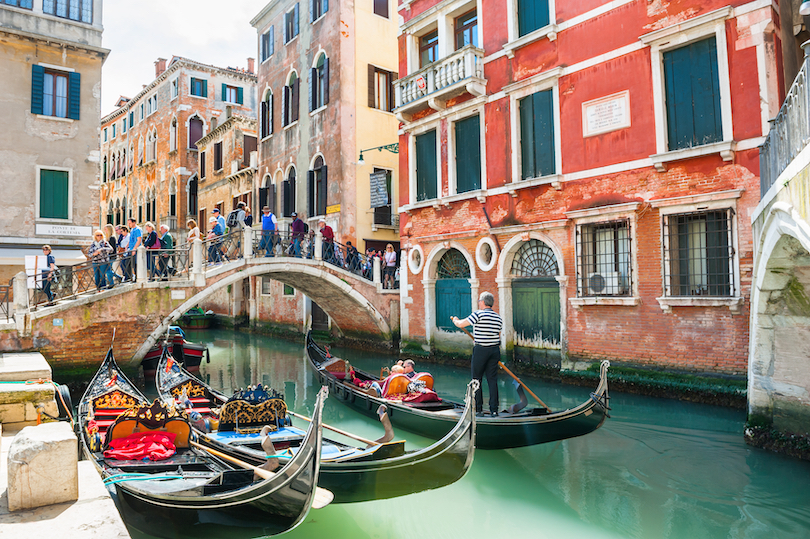
Once the Easter holidays arrive, the peak season starts with the number of tourists in Venice only subsiding in November. Hotel prices and airfares are much higher with queues forming outside its main attractions and museums. While there is an excited buzz about the city, its narrow alleys do start to feel a bit crowded.
Coupled with its longer, sunnier days, averages of 17°C (62°F) are great for strolling about its stunning streets and squares. Parades and concerts take place for the Feast of San Marco while its prestigious Art Biennale also begins, carrying on til the end of November. Although it is a bit wetter than the winter months, its 12 days of rain shouldn’t put much of a damper on your trip.
Venice in May
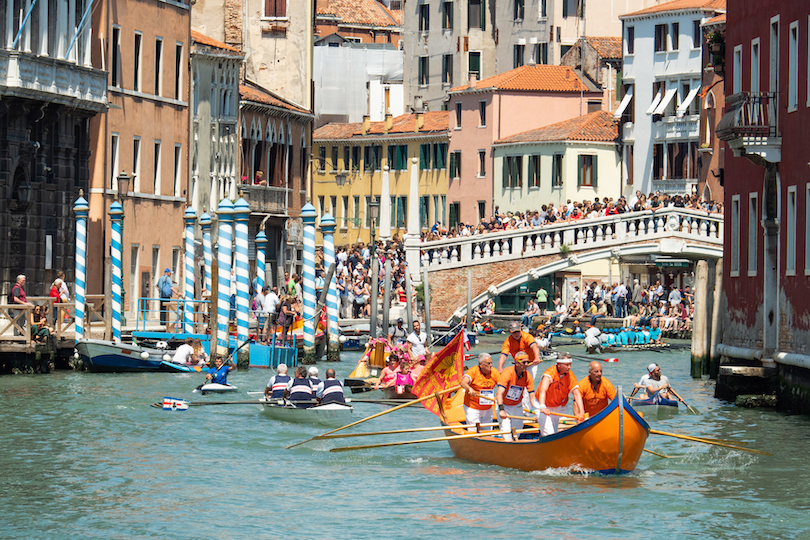
Along with April, May is one of the best months weatherwise to visit Venice. Temperatures of around 21°C (70°F) are perfect for wandering about the city before the summer heat kicks in. This is also a good time to explore some other islands and cities in Veneto before they’re completely overwhelmed.
While many museums, shops and restaurants shut for Labour Day, there are some exciting regattas to watch later on in the month. These are for both the Vogalonga – a long-running competition – and the Feast of the Ascension. Although there are loads of crowds around, prices are still more affordable than in summer.
Venice in June
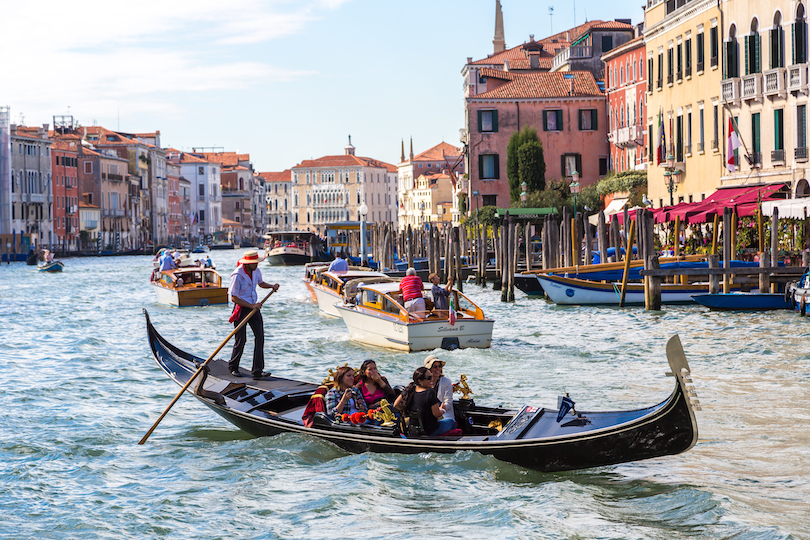
With average temperatures rising to 25°C (77°F), Venice starts to feel a bit hot and stuffy, especially with the hordes of tourists thronging about its streets. The weather is finally good enough though to sunbathe and swim at the Lido. Other than all its Art Biennale exhibitions, June is the last month to catch an opera at La Fenice Theatre before the summer break.
As each day has around 16 hours of light, there is ample time in which to sightsee or sit and sip a spritz at its outdoor cafes. June is one of the rainiest months though, along with August and November. While prices are more expensive, concerts, dances and exhibitions also take place for the Feast of St. John in Bragora and Feast of San Pietro de Castro.
Venice in July
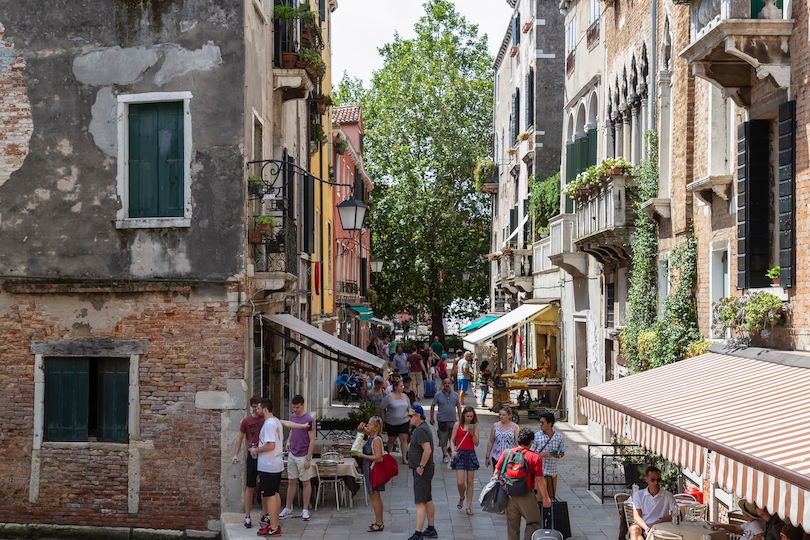
July and August are the absolute peak season in Venice when everywhere is packed and all its shops, restaurants and bars are at their busiest. You’ll have to queue at many of its main attractions and museums with the vaporetti to Murano and Burano also being full. To avoid the astronomical accommodation prices, it’s worth having a look for hotels in nearby Mestre.
The hottest and sunniest month of the year, July’s high averages of 28°C (82°F) are actually rather unpleasant. While wandering about is a hot and sticky affair, it’s the perfect weather to lounge on the beach at either the Lido or Jesolo. The city has a lovely, lively atmosphere about it with regattas and firework displays also being held for the Feast of the Redeemer.
Venice in August
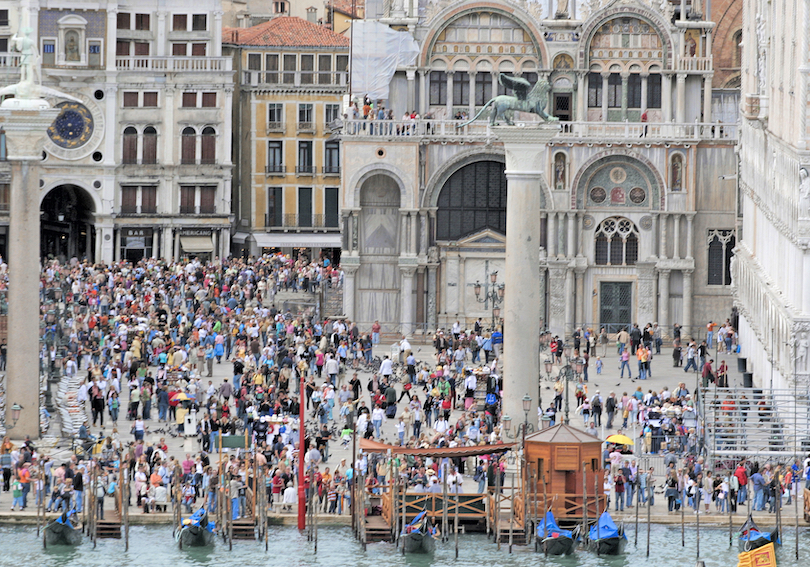
While many Italians take their holidays in August, business continues as usual in Venice with most shops and restaurants remaining open. The Rialto Bridge and streets near Piazza San Marco are absolutely rammed. To escape the crowds, consider heading to less popular areas like Dorsoduro and Cannaregio.
The sweltering weather and slow-moving throngs of tourists can make sightseeing tiring and a bit frustrating. You can always cool off though at the beach or in one of its countless quiet churches. Besides the Festival of Santo Stefano’s sports competitions and dance shows, the world-renowned Venice International Film Festival starts, continuing into September.
Venice in September
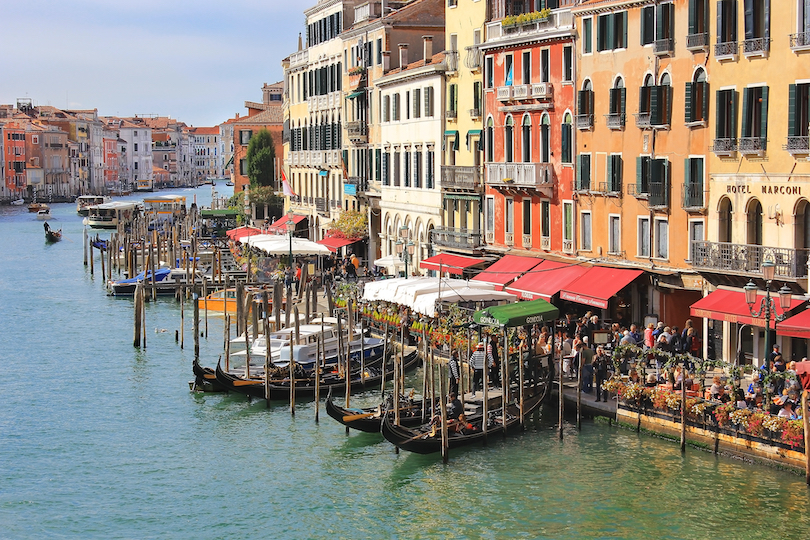
Once the school holidays are over, things are finally a bit quieter, calmer and cheaper in the city – that’s not saying much though! Prices remain high and massive groups of tourists still mill about its streets. As it is a few degrees cooler, ambling around is more comfortable with the days being dry and sunny.
Aside from the International Film Festival at the Lido, there is the fascinating Regata Storica and all its historic boats to watch along the Grand Canal. The opera season also opens again at La Fenice Theatre. As the weather is still warm, you can always sunbathe and swim at its beaches. Most nearby day trip destinations will still be quite busy though.
Venice in October
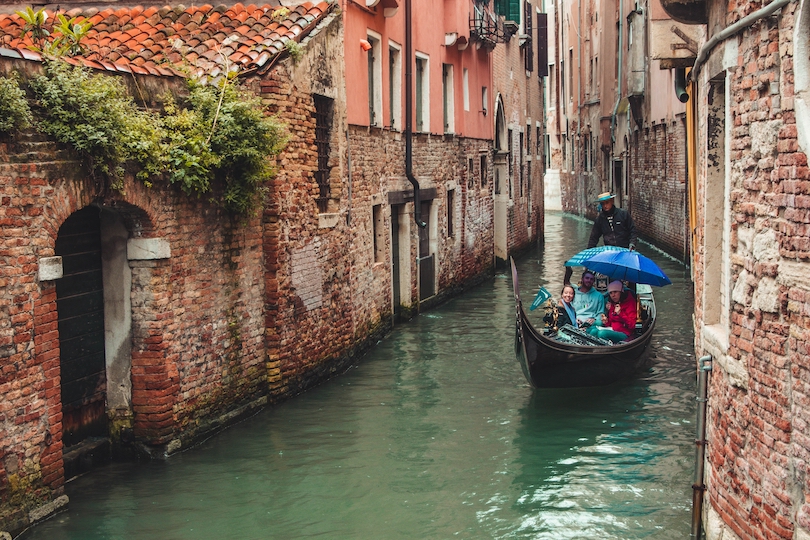
As October has fewer big events going on, accommodation is finally a bit more affordable with the city being much quieter the further you stray from Piazza San Marco. For the most part, the weather is quite warm and dry, though the days are shorter. Its 5 hours of sunshine and averages of 18°C (64°F) are still lovely for sightseeing but a bit too cool for the beach.
Before things turn cold, wet and grey in November, it’s worth taking trips to historical cities like Padua, Vicenza and Verona. You also no longer have to fight for space on its vaporetti to Murano and Burano. At the end of October, thousands visit for its marathon which passes by its scenic canals over little old bridges.
Venice in November
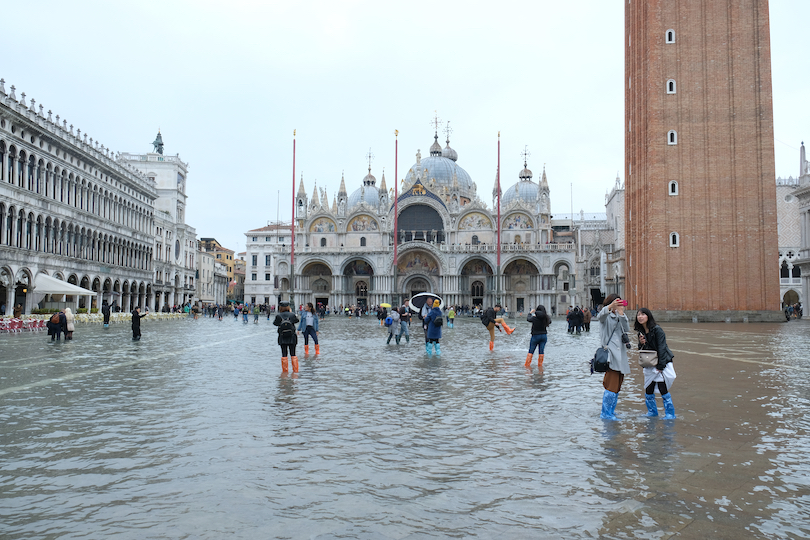
With just 3 hours of sunshine, much more rain and temperatures of 12°C (53°F), November is well and truly the off-season in Venice. Blissfully crowd-free, its reduced hotel prices and airfares can make a trip tempting. You’ll have to pack an umbrella though and listen out for sirens signalling acqua alta’s impending arrival!
While many of its attractions have reduced opening hours and there are fewer daylight hours in which to explore, Venice looks incredible at any time of year. Traditional events such as its Feast of St. Martin and Feast of Our Lady of Health also take place. At these, you can watch religious parades and sample local delicacies. Its Art Biennale also finally comes to a close in November for the winter.
Venice in December
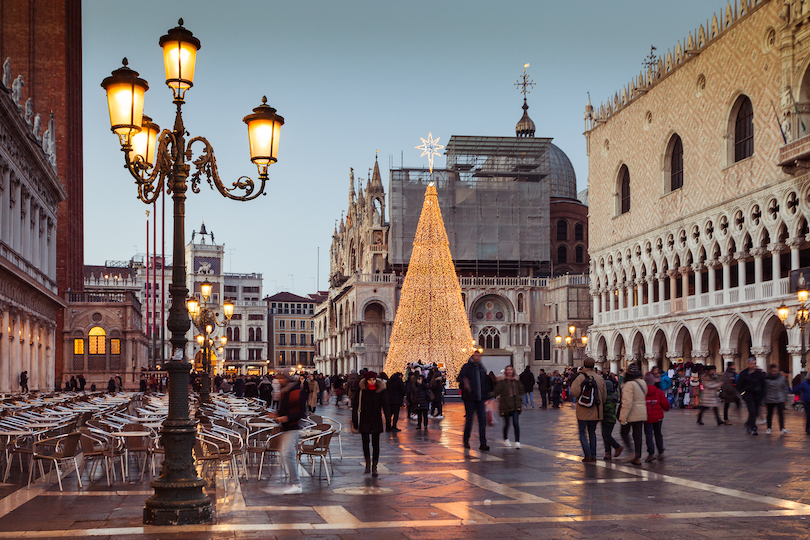
A bit drier and colder than November, Venice has a wonderful, relaxed feel to it in December with the Christmas holidays also bringing some festive cheer. While the chance of fog, wind and acqua alta is higher, exploring its deserted alleys is still magical if you wrap up warm.
Still very quiet in comparison with the spring, summer and autumn months, it sees a spike in visitors around Christmastime. Hotel prices of course rise around the holidays. Other than perusing its cozy markets, you can shoot about the ice rink at Campo San Polo. To welcome in the New Year, you can enjoy concerts and firework displays in Piazza San Marco or attend a special performance at La Fenice Theatre.
Share this post:
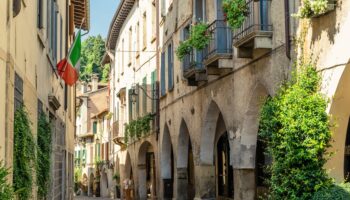
14 Best Places to Visit in Veneto, Italy
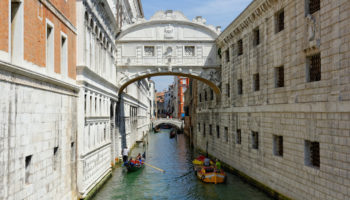
25 Top Tourist Attractions in Venice
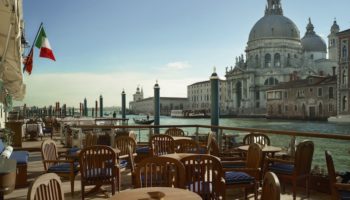
Where to Stay in Venice: Best Areas & Hotels
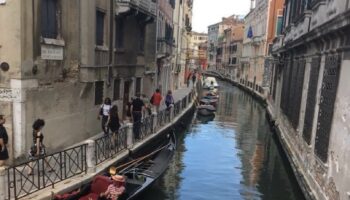
Visiting Chioggia: Little Venice’s Best Kept Secrets
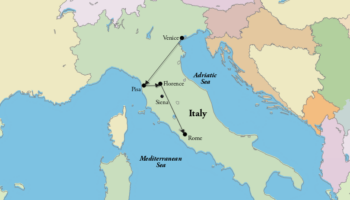
How To Spend One Week in Italy: DIY Itinerary
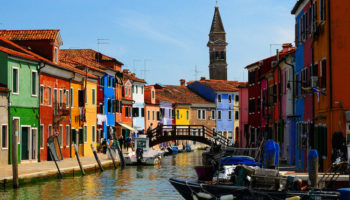
11 Best Day Trips from Venice
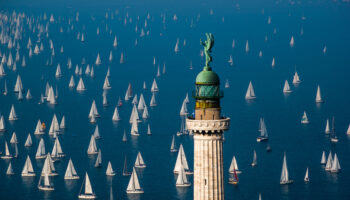
18 Best Things to do in Trieste, Italy

23 Best Things to do in Genoa, Italy
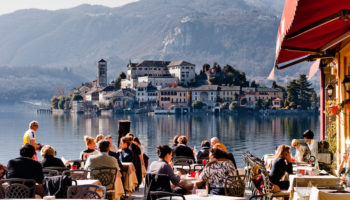
10 Most Beautiful Lakes in Italy
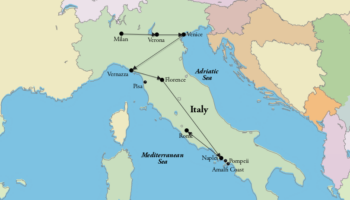
How to Spend 2 Weeks in Italy: DIY Itinerary
When's The Best Time To Visit Venice
Book your individual trip , stress-free with local travel experts
- roughguides.com
- best-time-to-visit-venice
Plan your tailor-made trip with a local expert
Book securely with money-back guarantee
Travel stress-free with local assistance and 24/7 support

written by Olga Sitnitsa
updated 11.04.2024
Venice ’s tourist season is very nearly an all-year affair . Peak season is from Easter to early October when hotel rooms are virtually impossible to come by at short notice; if possible, try to avoid July and August , when the crowds are at their fullest, the climate can be oppressive, and many restaurants and bars take their annual break. The other two popular spells are Carnevale (leading up to Lent) and the weeks on each side of Christmas; again, hotels tend to be heavily booked, especially for Carnevale
Key takeaways
- When's the best time to visit Venice?
What are the travel season(s) in Venice
What are the best months to visit venice, when is rainy season in venice, visit the carnival of venice, tips for travelling to venice, tailor-made travel itineraries for italy, created by local experts.

8 days / from 2622 USD
Experience the hit TV show 'The White Lotus' in Sicily
Stay in beautiful Taormina with gorgeous views of Mount Etna and discover Sicily, including famous filming locations. Go on exclusive wine tastings, discover the Greek theater in Taormina with a private guide, visit other Sicilian towns and enjoy the crystal clear water on this week-long trip.

8 days / from 3258 USD
Enchanting Italian Lakes
Experience the picturesque lakes of Northern Italy, including Lake Garda, Como, Lugano and Maggiore; explore the charming Borromean Islands – former favourites of Ernest Hemingway – and stroll the romantic streets of Verona and Milan. All of this, and much more, with this self-drive trip!

16 days / from 3258 USD
From Venice to Florence: A Grand Tour of Northern Italy
From the atmospheric canals of Venice and the picturesque coastline of Cinque Terre, to the trendy designer boutiques of Milan and the Renaissance-infused streets of Florence, Northern Italy has plenty to offer. Experience it all with this comprehensive trip.
- Spring ( March to May) and autumn (September to November ) are the most favourable periods to visit Venice, when temperatures are mild and crowds are smaller, allowing you to explore its canals and architecture more closely.
- Acqua alta , or flood season, occurs from October to January , presenting a unique aspect of Venice with its flooded streets and squares, offering a different perspective on the city's charm.
- The Venice Carnival , a world-famous event, usually takes place in February , transforming the city into a colourful scene of masquerades, elaborate costumes and cultural festivities.
- Venice is hot and crowded in the summer ( June to August ), but there are opportunities to enjoy lively festivals, al fresco dining along the canals and spectacular sunsets over the lagoon.
When's the best time to visit Venice?
For the ideal combination of comparative peace and pleasant climate, the two or three weeks immediately preceding Easter are perhaps the best time of year. Climatically, the months at the end of the high season are erratic: some November and December days are so clear that the Dolomites seem to start on the edge of the mainland, but others bring torrential rain or fog so dense you can’t see across the Canal Grande.
However, the desertion of the streets in winter is magical, and the sight of the Piazza under floodwater is unforgettable. This acqua alta, as Venice’s seasonal flooding is called, is common between October and March, and you should anticipate a few inconvenient days in the course of a winter visit.
Here are some highlights:
- Spring : Ideal weather and Venice Biennale.
- Summer : Vibrant festivals and outdoor dining.
- Autumn : Serene beauty and the Venice Film Festival.
- Winter : Carnival of Venice and unique acqua alta scenes.

Grand Canal, Venice, Italy © Apple Kullathida/Shutterstock
In Venice, the tourist seasons are characterised as follows:
High Season
From June to August, from late December to early January (Christmas and New Year's Eve), and a fortnight at Easter. Venice is at its busiest during this period, with warm summer weather attracting tourists to its canals and events such as Easter creating a festive atmosphere. Expect crowded attractions, higher accommodation prices and a lively city pulse.
Shoulder Season
Occurs in April, May, September and October. These months are characterised by milder weather and coincide with events such as the Venice Biennale art exhibition, which alternates with the Architecture Biennale, which begins in May.
At this time, the city is less crowded than in high season, allowing for a more relaxed exploration of Venice's historic streets and canals. Accommodation prices are moderately high but more affordable than in high season.
Lasts from November to March, with the exception of the Christmas, New Year and Carnival periods. This season is characterised by cooler temperatures, potential acqua alta (especially from November to January) and a calmer atmosphere of the city.
The number of tourists decreases significantly, resulting in lower prices and a more soulful experience of Venice. This period offers a unique opportunity to explore the city without the crowds of tourists, although some businesses may operate on reduced hours or be closed.
When planning a trip to Venice it is important not only to consider the weather conditions but also to find suitable accommodation. Our guide to the best places to stay in Venice will help you solve this issue .

St Mark's Square from the Grand canal. Venice, Italy © volkova natalia/Shutterstock
Venice, a city of great beauty and historical significance, offers its visitors unique experiences throughout the year. However, some months stand out for their perfect combination of pleasant weather, relatively smaller crowds and the city's vibrant cultural calendar. These months capture the essence of Venice and will make your visit unforgettable.
Weather in Venice in April
April marks the beginning of spring in Venice. The weather becomes comfortably mild and the city begins to blossom with colour, making it an ideal time for photography and nature lovers. Easter celebrations add to the festive atmosphere and you can enjoy open cafes and restaurants without the summer crowds. April also sees the opening of the Biennale art or architecture exhibitions, depending on the year, and the start of a wave of cultural events.
Weather in Venice in May
May is probably one of the best times to visit Venice. The weather is warm but not yet hot, allowing you to explore the city's narrow streets and countless bridges for long periods. The city is alive with colour, from fresh greenery to clear blue skies, perfect for leisurely gondola rides. Also in May, Venice often hosts the Biennale, making it a magnet for art lovers from all over the world.
Weather in Venice in September
As the summer heat begins to subside, September welcomes visitors with comfortable temperatures and a light, pleasant atmosphere. The city breathes a sigh of relief as the peak tourist season comes to an end, allowing for more relaxed cultural and historical sightseeing. Among other things, the Venice Film Festival, held in early September, attracts film lovers and adds a glamorous touch to the city's already enchanting atmosphere.
Weather in Venice in October
October is the month that showcases the tranquil beauty of Venice. Temperatures cool down and the summer crowds eventually dissipate, offering a more intimate introduction to the city. The change of season brings stunning autumn colours, creating picturesque scenes around every corner. This is a great time if you want to immerse yourself in the rich history and art of Venice without the hustle and bustle of high season. In addition, the mist over the canals adds a mysterious charm to the Venetian scenery.

Venice landmark, Burano island canal, colorful houses and boats, Italy © StevanZZ/Shutterstock
The closest equivalent to the rainy season in Venice is mostly in the fall: the rainiest month is November, as well as October and April. These months often see acqua alta, or floodwaters, causing flooding in some parts of the city. This phenomenon, while unique and fascinating to observe, can affect the movement and accessibility of Venice.
If you plan to visit during these periods, you should be prepared for possible disruptions and the opportunity to see the city from an unusual perspective as its waterways and streets merge together.
The Venice Carnival is a world-famous festival that transforms the city into a land of wonder, history, mystery, and beauty. It usually takes place in February and concludes with Lent, so guests from all over the world come to take part in its extravaganza.
It is important to book accommodation in advance, as the city is flooded with people wanting to experience the magic of Carnival. While most of Venice's attractions remain open, expect them to be more crowded than usual.
The appeal of Carnival lies not only in its historic costumes and elaborate masks but also in the variety of entertainment it offers:
- Majestic masquerade balls in ancient Venetian palaces.
- Street performances that enliven the city's narrow streets
- Gondola parades along the famous canals.
- Impressive art exhibitions and live music events.
However, the influx of tourists during this period means that popular destinations can be extremely busy and airfares and hotel prices can rise significantly. It is therefore advisable to plan your Venice Carnival adventure well in advance to ensure you have an enjoyable time in the colorful atmosphere of the festivities.
Venice offers a wide list of things to do at any time of the year. If you're feeling confused and don't know where to start planning your itinerary, check out our list of the best things to do in Venice for all tastes .

Masked man by the water at Venice Carnival, Italy, Europe – copyright Kiki Deere
Plan your visit during shoulder season
Visiting Venice during the "shoulder" months of March, April and October can enhance your experience. During these periods, the weather is milder, the crowds are smaller and the beauty of the city is more tranquil. You'll get fewer queues at the main attractions and a calmer atmosphere for exploring the winding streets and canals.
Embrace the Acqua Alta
The Acqua alta , or high water, is a unique phenomenon in Venice that usually occurs between October and January. Instead of seeing it as an inconvenience, embrace this aspect of Venetian life. Put on waterproof boots and walk on the elevated platforms to see the city in a whole new light. It's an experience unique to Venice that you won't want to miss.
Get lost in the backstreets
One of the best ways to get to know Venice is to wander its less-visited paths. Venture beyond the main tourist spots, such as St Mark's Square and the Rialto Bridge, to discover hidden gems. Here you'll find quieter canals, charming local shops and authentic Venetian restaurants, giving you a glimpse into the daily lives of the residents.
Use Public Transportation Wisely
Venice's public transport system , primarily the vaporettos (water buses), is an efficient way to get around the city. If you are staying for a few days, consider purchasing a pass to save on the cost of individual tickets. Remember that gondola rides, although iconic, are more for the experience than as a practical way to get around, and they can be expensive.
Online editor at Rough Guides, specialising in travel content. Passionate about creating compelling stories and inspiring others to explore the world.
- Authentic Experiences
- Travel Advice
- Travel Tips
Planning your own trip? Prepare for your trip
Use Rough Guides' trusted partners for great rates
Travel advice for Italy
From travel safety to visa requirements, discover the best tips for traveling to Italy
- Eating and drinking in Italy
- How to get to Italy
- Getting around Italy: Transportation Tips
- Shopping tips for Italy
- Sports and Outdoor activities in Italy
- Travel Tips Italy for planning and on the go
- Best time to visit Italy
- How to spend 7 days In Italy - 8 unique itineraries
- The Best 10-Day Italy Travel Itinerary
- How To Spend 14 Days In Italy - 5 Unique Itineraries
- How to get from Rome to Florence
Find even more inspiration for 35 here

Ready to travel and discover Italy?
Get support from our local experts for stress-free planning & worry-free travels.
- Where to stay
- Itineraries
- Travel advice
Weather & Climate
Marco Polo Airport Guide
Neighborhoods to Know
Venice's Vaporetto Transportation
Best Gondola Rides
Day Trips From Venice
Top Things to Do
Free Things to Do
Traveling With Kids
Best Museums to Visit
Guide to Carnevale
Top Venice Restaurants
Nightlife in Venice
Best Time to Visit
The Best Time to Visit Venice
Lara D'Agostino / TripSavvy
If you're planning a trip to Venice, some times of year are definitely better than others. Weather, festivals, and, of course, the acqua alta (high water) that Venice is so famous for should all be considered when deciding when to go to Venice.
Taking all of that into account, the best time to visit Venice is November. If you want to have the city to yourself, it's best to visit in the off-season and while you may need to pack some layers for November's chilly evenings, the city is mostly tourist-free and hotel rates are much more affordable. While high water can definitely hamper your sightseeing, know that it has been a way of life for Venetians for hundreds of years and is a unique experience to have as a tourist.
The Weather in Venice
Late spring and early summer in Venice do offer the best weather. But the city during these beautiful warm days is packed with tourists (the May 1 holiday is particularly crowded), meaning that there can be long waits to enter museums and sights. Also during this peak time, finding accommodations—budget or otherwise—can be a challenge.
Venice is similarly packed with tourists in late summer, even though the city can be oppressively hot, the canals ripe with odor, and the inevitable mosquitoes are bothersome.
The fall is a lovely time to visit Venice, but it is also when the acqua alta (flooding, or literally "high water") is more likely to occur. October through January is the typical high water season, though flooding can occur at any time during the year.
Venice's location, in northern Italy on the Adriatic Sea, means that the city has colder, longer winters. While winter can be a great time of year to visit, especially in terms of getting a bargain and avoiding crowds, it can be harsh. The winds that whip off the Adriatic and down the alleyways are bone-chilling. Luckily, winter ends on a lively note with Carnevale , or Carnival, Venice's biggest festival.
Peak Season in Venice
Venice's very busy season occurs in the summer when hotels are charging their maximum rates and tourists are packed into gondolas on the canals. Days are sunny and long, but Venice's inland location means that it can be quite hot.
Key Events and Festivals
Venice has several big events that are worth booking a trip around. Carnevale dates usually fall in late February or early March, when tons of tourists descend on Venice for two weeks of masked and costumed revelry. Easter is also a festive time and is the start to the high season in Venice.
Every other year, in odd-numbered years, Venice hosts the Biennale for Art . This international arts showcase is a world-renowned event and takes place from the end of May to the end of November. The Biennale is a very popular event, so be prepared to find Venice more booked up than usual when it is on.
Yet another summer festival to see in Venice is the Festa del Redentore, which occurs the third weekend in July. This religious festival takes place at the Church of the Redentore, which lies on the island of Giudecca across from Saint Mark's Square . The festival is celebrated with the building of a pontoon bridge over the water, feasting, fireworks, and a gondola regatta.
March is chilly and humid, but packed full of exciting festivals and events, leading into the Holy Week and Labor Day (May 1), a national holiday. By April, the weather has warmed up a bit, yet crowds aren't too bad, making it a nice time to visit.
Events to check out:
- The Vogalonga, a world-class rowing competition featuring rowers from around the world, typically takes place in late May.
- Tourists crowd Venice during Easter. Don't miss the Benedizione del Fuoco , when the lights at Saint Mark's Basilica are turned off and a fire is lit in the space's entrance.
Italian summer holidays kick off on August 15, but the months preceding are among Italy's best for festivals and events.
- Every other year, Venice hosts its eponymous biennale, a months-long contemporary art extravaganza that runs through November. The entire city hosts art exhibits, installations, lectures, and happenings in venues across the city.
- In July, Venice hosts the Festa del Redentore, which marks the end of a big epidemic in 1576. During this festival, the temporary footbridge from the mainland to Giudecca Island, which is created from a connected flotilla of boats, becomes one of the most famous bridges in Venice.
In fall, tourists have left, leaving the city with fewer crowds and less expensive accommodations. Still, festivals and events are in full-swing in lively Venice. Note that later in the fall, weather can be quite brisk and in November, Venice often experiences acqua alta or flooding from high tides.
- On the first weekend of October, Venetians celebrate Festa del Mosto. On these days, locals spend time on the nearby island of Sant’Erasmo, the biggest island in the lagoon. This is where much of the area's produce is grown.
- Gondoliers race along the Grand Canal in September, as part of the Regata Storica (Historical Regatta), Venice's most exciting gondola race. There's always food, music, and lively fanfare.
Weather in Venice during the winter may not be the best, as temperatures average just 43 degrees Fahrenheit and rain is common, but there are fewer tourists since cruise season is over. Don't miss New Year's Eve in the Piazza San Marco, where there's a big group kiss followed by fireworks.
- Carnevale, Italy's version of mardi gras, takes over the city in February.
- The Christmas season truly ramps up on December 8, a national holiday.
For lower rates and minimal crowds, visit in the fall from September to November. Temperatures get colder as you get later in the season and the seasonal flooding is a possibility, but experiencing the city without hoards of tourists is worth the trade-off.
Venice is teeming with tourists all summer long, and the crowded streets, sky-high hotel rates, and muggy weather don't make for an ideal vacation. February is also a crowded time with Carnevale visitors.
The flood season—known locally as acqua alta —can happen at any time of year, but most commonly occurs from October to January.
The Best Things to Do in Venice, Italy
10 Budget Travel Tips for Visiting Venice
Weather in Venice: Climate, Seasons, and Average Monthly Temperatures
Venice in July
Tips for Going to Carnevale in Venice
November in Venice: Weather, What to Pack, and What to See
Liberation Day Observances in Italy
Venice, Italy Guide: Planning Your Trip
Murano: Planning Your Trip
The Best Time to Visit Boston
Celebrating Carnevale in Italy
Best Romantic Destinations in November and December
The Best Time to Visit Naples, Italy
The Best Time to Visit the U.S. Virgin Islands
The Best Time to Visit Spain
The Best Time to Visit the Dominican Republic

Venice Revealed

The Best Time to Visit Venice: The Ultimate All-Season Guide
This post may contain affiliate links. This means that if you book a tour or hotel through my link I earn a small commission at no additional cost to you. By supporting me through these links, you’re helping me keep this site awesome and deliver top-notch content to you. Your support means the world to me, and I’m incredibly grateful for it!
To truly appreciate Venice’s romantic allure , it’s crucial to plan your visit carefully. I live very close to Venice and spend time there frequently meaning that I have been there in every season.
What’s the best time to visit Venice? My favorite times to go there are in April and May and then again in September and October.
However, the best time to visit Venice can vary greatly depending on your preferences. Some prefer the bustling energy of the peak season, while others seek the tranquility of fewer crowds. Factors such as weather, hotel rates, and key events also play a significant role in determining the ideal time for your visit.
In this comprehensive guide, I’ll delve into the nuances of Venice’s seasons, discuss the city’s weather patterns, highlight key events and attractions, and provide practical tips to help you plan your visit.
Want to know the worst time to visit Venice? Click here for my full article!
Understanding Venice’s Seasons
Venice, like much of Italy, experiences four distinct seasons, each with its unique characteristics and charm. Understanding these seasons and their implications for travel can greatly enhance your visit to this enchanting city.
Peak Season
The peak season in Venice typically falls in the summer months, from June to August. During this time, the city is teeming with tourists from around the world, drawn by the warm weather and the vibrant atmosphere.
The city is in full swing, with all attractions open and tons of events taking place. However, be prepared for large crowds , long lines, and packed vaporetti, especially in popular spots like Piazza San Marco and the Grand Canal. Also, hotel rates tend to be at their highest during this period and some people complain that it’s smelly in the summer.
You’re not too far from some gorgeous beaches , though, so if you have some extra time to spend in Venice then it’s worth it to come during this season.
The off-season in Venice is generally during the colder months, from November to February, excluding the festive Christmas period and the famous Carnevale in February . Aside from during those times, the city sees fewer tourists, resulting in smaller crowds and shorter lines at attractions.
The weather can be quite cold, and some attractions may have shorter hours or be closed entirely. However, hotel rates are generally cheaper, and you can experience a quieter, more authentic Venice.
There is still plenty of events and things to do in the off season. For instance, in January you can take in the Epiphany celebrations.
Shoulder Season
The shoulder season in Venice occurs in the spring (April to June) and fall (September and October). These periods offer a balance between the bustling energy of the peak season and the tranquility of the off season. The weather is generally pleasant, and while there are still tourists, the crowds are less overwhelming.
Hotel rates are also more moderate compared to the peak season. The shoulder season can be an excellent time to visit Venice if you’re looking for a balance between good weather, manageable crowds, and reasonable prices.
Read my guide on the most romantic hotels once you’ve started planning your trip!
Peak Visitor Numbers and Tourist Seasons in Venice

Venice, the city of canals, is a popular tourist destination that attracts millions of visitors each year . Understanding the peak visitor numbers and tourist seasons in Venice can help you plan your trip more effectively, ensuring you get the most out of your visit.
Venice experiences its highest tourist influx during the summer months, particularly in July and August. This is considered the “peak season” when the city is bustling with tourists from around the world. The weather is warm, and all attractions are open, making it an ideal time for sightseeing. However, it’s also when Venice is most crowded, and hotel rates are at their highest.
On the other hand, the “off season” typically falls in the colder months, from late fall to early spring. During this time, the number of tourists drops significantly. While some attractions may have shorter hours, you’ll enjoy fewer crowds, and accommodations are generally cheaper.
The “ shoulder season ” falls in the transitional periods between the peak and off seasons, usually in late spring (April to June) and early fall (September and October). During these months, the weather is still pleasant, and the tourist crowds are less overwhelming than in the peak season.
However, it’s important to note that these are general trends and can vary from year to year.
Weather in Venice
Venice, the city of canals, is a marvel to behold in any season. However, the weather can significantly impact your visit, so it’s essential to know what to expect.
Average Temperatures
Venice experiences a humid subtropical climate, with cool winters and very warm summers. The average annual temperature is 18℃. The warmest month of the year is July, with an average temperature of 28℃. On the other hand, January is usually the coldest month, with an average temperature of 7℃.
Here’s a month-by-month breakdown of the average temperatures:
- January: 7℃
- February: 9℃
- August: 28℃
- September: 24℃
- October: 19℃
- November: 13℃
- December: 9℃

Precipitation
Venice also sees a fair amount of rainfall throughout the year. The months with the largest precipitation are October, November, and May, with October seeing the highest average precipitation of 88mm.
Here’s a month-by-month breakdown of the average precipitation:
- January: 49mm
- February: 51mm
- March: 61mm
- April: 73mm
- August: 62mm
- September: 68mm
- October: 88mm
- November: 84mm
- December: 62mm

Visiting Venice in Different Seasons
Each season in Venice offers a unique experience, with its own set of pros and cons. Here’s a breakdown of what you can expect when visiting Venice in different seasons:
Summer (June – August)
- Long, sunny days perfect for sightseeing
- Numerous events and festivals, such as the Festa del Redentore in July
- Gondola rides and alfresco dining are particularly enjoyable in the warm weather
- High tourist season, resulting in large crowds and long lines at attractions
- High temperatures and occasional summer thunderstorms can be uncomfortable
- Hotel rates are at their peak
Fall (September – November)
- Fewer tourists, resulting in a more relaxed atmosphere
- The weather is generally pleasant, with temperatures dropping from the summer highs
- The occurrence of “acqua alta” can be an interesting experience (though it’s best to come prepared with rain boots)
- Some attractions may have shorter hours
- The weather can be unpredictable, with a higher chance of rain and acqua alta
Winter (December – February)
- The least crowded time to visit Venice
- Lower hotel rates
- Unique events like the Venice Carnival in February
- Cold winters, with temperatures often dropping below freezing
- Shorter days mean less daylight for sightseeing
- Some businesses may be closed or have reduced hours
Spring (March – May)
- Beautiful blooming flowers and pleasant weather
- Fewer crowds compared to the summer months
- The Venice Biennale starts in late May, a major contemporary art exhibition
- Spring showers are common, so it’s a good idea to carry an umbrella
- Some popular sites can start to get crowded, especially during the Easter holidays
Remember, the best time to visit Venice depends on your personal preferences and what you want to get out of your trip.
Key Events and Holidays in Venice
Venice is a city that’s rich in culture and tradition, and this is reflected in the numerous events and holidays that take place throughout the year. These events can significantly impact your visit, affecting everything from hotel rates to tourist crowds.
National Holidays in Italy
Italy celebrates several national holidays, many of which are also celebrated in Venice. These include New Year’s Day (January 1), Easter Monday (date varies), Labor Day (May 1), and Christmas Day (December 25). During these holidays, many businesses and attractions may be closed, but the city often comes alive with special events and celebrations.
Specific Events
One of the most significant events that impact the city’s crowd levels is the Carnevale di Venezia, or the Carnival of Venice. This annual festival is world-renowned and attracts visitors from all corners of the globe. The Carnevale typically takes place in February , leading up to Lent. The exact dates vary each year, but in 2023, for example, many of the Carnival events were scheduled from the 11th to the 21st of February, according to the official Venice Carnival website .
If you’re planning to visit during the Carnevale, it’s recommended to book your accommodation and tickets for events well in advance. Some of the most popular events, like the ‘Il Ballo del Doge’ or the Doge’s Ball, can sell out quickly.
Another significant event is the Festa del Redentore in July, a grand festival with fireworks and a regatta to celebrate the end of the plague in 1576.
Holy Week , leading up to Easter, is also a special time in Venice, with religious processions and services taking place throughout the city.
Christmas in Venice is a magical time, with festive decorations, special church services, and Christmas markets. The markets start popping up around the end of November and often last until into the second week of January.

Another notable event is the Vogalonga Regatta, a non-competitive rowing event that takes place in May. It’s a spectacular sight, with hundreds of boats from around the world participating.
Impact on Hotel Rates and Tourist Crowds
During these events and holidays, Venice can become particularly crowded, and hotel rates often increase due to the high demand. It’s advisable to book your accommodations well in advance if you plan to visit during these times.
For events like the Vogalonga, transportation and even the routes the gondolas can take are impacted. The Grand Canal is closed to public transportation during the Vogalonga for most of the day, for example.
Practical Tips for Visiting Venice
Visiting Venice can be an unforgettable experience, but it requires some planning and preparation. Here are some practical tips to help you make the most of your trip:
Weather Preparedness

Venice’s weather can be quite variable, so it’s important to plan for good weather and prepare for the possibility of bad weather. Check the average temperatures and rainfall for the time of your visit and pack accordingly. Remember, even in the summer, thunderstorms can occur, and in the winter, the city can experience cold temperatures and high water levels (acqua alta). Always have a plan B for outdoor activities in case of unexpected weather changes.
Venice can be an expensive city, especially during the peak tourist season. If you’re on a tight budget , consider visiting in the off-season when hotel rates are generally cheaper. Also, keep in mind that many attractions charge admission fees, so factor these into your budget as well.
Buying one of the many passes available for things like transportation, museums , and other attractions can save you money and time. I highly recommend one and you can see the ones that should help you on your trip by clicking here.
Check out my guide on the most popular Venice Passes so you can find one that suits your needs best!
Packing Appropriately
Packing appropriately for your trip to Venice is crucial. In addition to clothing suitable for the weather, consider packing items like rain boots and a waterproof jacket, especially if you’re visiting during the acqua alta season . If you are caught by surprise by aqua alta and didn’t pack appropriately, don’t worry as many souvenir shops sell boots.
Comfortable walking shoes are a must as you’ll likely spend a lot of time on your feet exploring the city.
Check out my packing list guide for what to wear in Venice!
Day Trips and Special Events
Venice’s location in northern Italy makes it a great base for day trips to other cities and regions such as the Prosecco hills for a wine tour . Consider adding a day trip to your itinerary to explore more of Italy. Also, if you’re visiting over New Year’s Eve, you’re in for a treat. Venice hosts a spectacular fireworks display over the lagoon to ring in the new year, a truly magical experience.

Check out my article on the best day trips from Venice to help you plan your ideal trip!
Venice, with its unique charm and rich history, is a city that captivates every visitor. Whether you’re navigating the bustling streets during the peak tourist season, experiencing the festive atmosphere of the Carnevale, or enjoying the quieter charm of the off-season, Venice promises an unforgettable experience.
Remember, the best time to visit Venice is the time that suits you best. So, plan your trip, pack your bags, and get ready to fall in love with La Serenissima, the most serene city.
- Recent Posts
- The 12 Best Beaches Near Venice: A Comprehensive Guide - March 5, 2024
- [Day Trip] 12 Fun & Quirky Things to Do in Burano, Italy - March 4, 2024
- Dorsoduro Restaurants: Venice’s Best Kept Culinary Secrets - March 2, 2024
Similar Posts

The 20 Best Museums in Venice for Art, History, and Culture
Venice, a city renowned for its winding canals and historic charm, is also a treasure trove of art and culture. Nestled among its charming canals and winding streets are some of the world’s most illustrious museums, each telling a unique story of the city’s rich past and vibrant present. Whether you’re an art lover or…
![best time to travel venice [2024] Is Venice Safe for Tourists? 6 Safety Tips You Need to Know](https://venicerevealed.com/wp-content/uploads/2023/04/is-venice-safe-768x256.png)
[2024] Is Venice Safe for Tourists? 6 Safety Tips You Need to Know
Venice, Italy is a beloved romantic destination for tourists from all over the world. With its picturesque canals, stunning architecture, and rich history, it’s no wonder why so many flock to this city each year. However, some of you may be wondering, is Venice safe to visit? After all, if you’re going somewhere you’ve never…

A Guide to Inside the Doge’s Palace: Why It’s Worth It
Immerse yourself in the grandeur of Venice’s past by stepping into the Doge’s Palace, an architectural masterpiece that embodies the city’s rich history and culture. As the heart of political power during the Venetian Republic, the Doge’s Palace offers a unique glimpse into the lives of the Doges who ruled Venice for centuries. People often…

The Absolute Worst Time to Visit Venice to Save Your Sanity
Imagine gliding through serene canals, the soft melodies of gondoliers echoing off centuries-old buildings. Now, imagine that same journey, only you’re amidst a sea of tourists, elbowing for space. My opinion is that the worst times to visit Venice are July and August due to the crowds and intense heat and humidity. However, timing is…

Overtourism in Venice: A Responsible Tourist’s Guide
Imagine standing on the Rialto Bridge, gazing at the Grand Canal, a sight that has captivated visitors for centuries. Now imagine that view obscured by throngs of tourists, the waterways congested with boats, and the air filled with noise. This is the reality of mass tourism in Venice. Venice, a city that has stood the…

Shopping in Venice 101: Essential Tips from a Local
Attention, shoppers! If you’re searching for a shopping experience that marries unique finds with the charm of old-world craftsmanship, look no further than the enchanting city of Venice, Italy. From the bustling shopping streets to the quaint boutiques tucked away in the city’s corners, Venice offers a shopping experience like no other. Whether you’re hunting…
Leave a Reply Cancel reply
Your email address will not be published. Required fields are marked *
Save my name, email, and website in this browser for the next time I comment.

Best time to visit Venice Italy
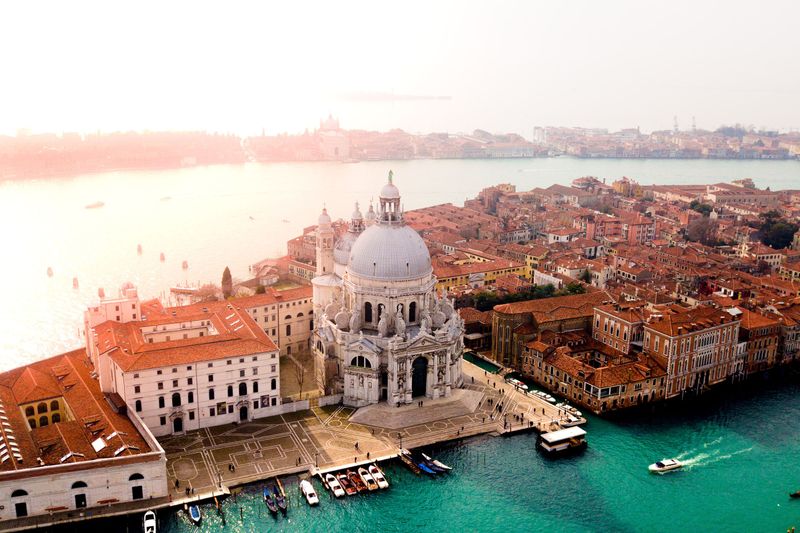
If you are organizing your trip to Venice , you should know which is the best time to visit it .
Before we start our article, however, we want to let you know that the city is actually beautiful any time of the year . Anyhow, each season has its own characteristics , related to the weather, temperatures, festivals and so on.
Would you start this journey with us?
When is the best time to visit Venice Italy?
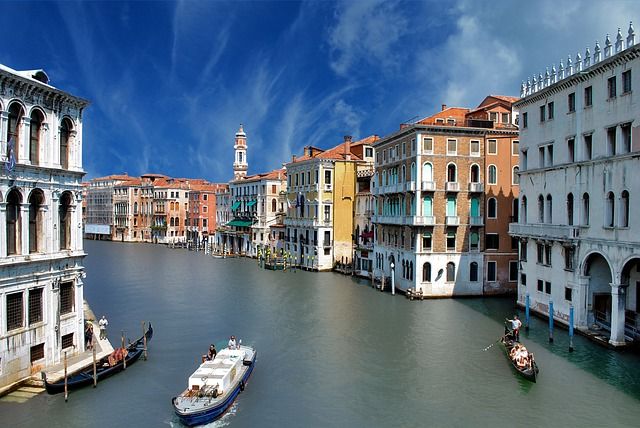
We truly do not know which is the best time to visit Venice .
As locals, who live here all year around, we love experiencing different sides of our beloved city .
However, from a tourist point of view , you may want to have some tips .
Let us explain our considerations to you.
Annual weather in Venice according to the seasons
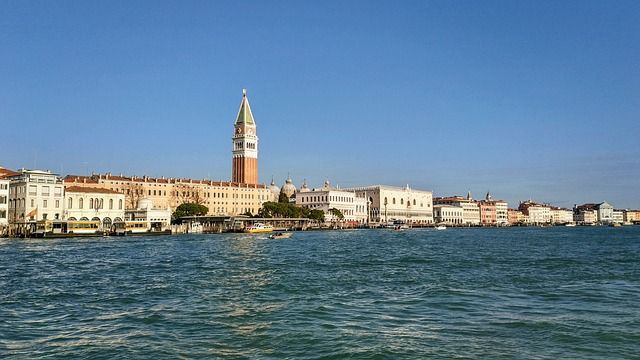
In Italy, as you probably know, we could subdivide the year into 4 seasons.
Spring, from March to June , is characterized by beautiful sunny days and temperatures that may be warm . You can also experience some temperatures dropping, rainy and windy days. But that's all part of spring weather.
Summer, from June to September , is the hottest time of the year . Coming in those days of the year, you can experience warm temperatures but also sultriness and wet weather. It can be very challenging exploring Venice in July or August, so you have to organize your itinerary, avoiding the hottest hours of the day.
Autumn, from September to December , is characterized by colder temperatures and rainy days . However, due to climate change, in the last decade, we are experiencing a never ending Summer, so...
Winter days, from December to March , are characterized by the coldest temperatures of the year . Coming here during winter, you could also experience the high tide (acqua alta) so you'd better be prepared ( check out our guide to know more ).
Peak Season in Venice
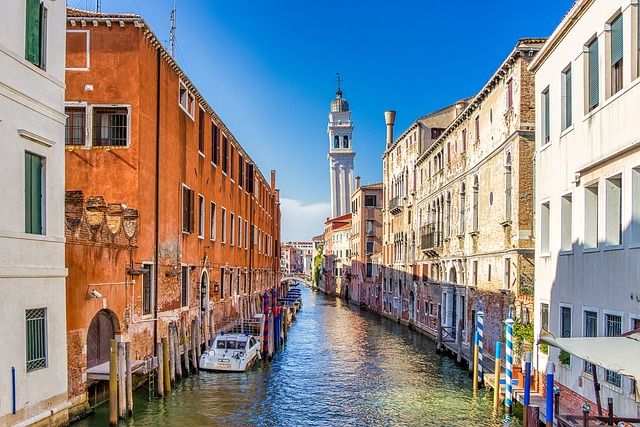
If weather and temperatures are an important feature of your trip to Venice, so are peak season.
In fact, during peak seasons you will find less availability (of hotel rooms or restaurant tables) at higher rates .
Which is Venice's peak season? It's a tough question , indeed. In our opinion, it's easier if you ask which are not peak seasons!
Many festivals and events spread throughout the year, making Venetian calendar full of events and things to do.
For example, in many parts of the world, February is considered low season: however, in Venice it is the moment to celebrate one of the craziest festivals of the year : the Carnival!
Best time to visit Venice for events and festivals
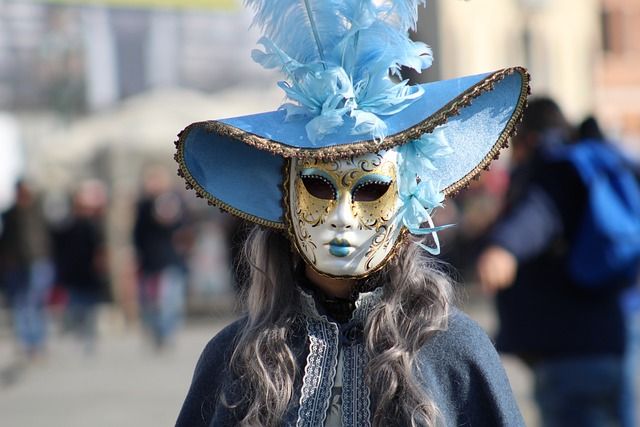
As we said, February hosts the first big event of the year.
However, the season that concentrates most of the festivals and events is actually the Summer .
From the Biennale to the Mostra del Cinema (this one the first days of September); from the incredible Redentore feast (the third weekend of July) to the many events related to the Assumption Day on August 15th.
The city is very crowded but the atmosphere is so festive and joyful .
Should you visit Venice during the low season?
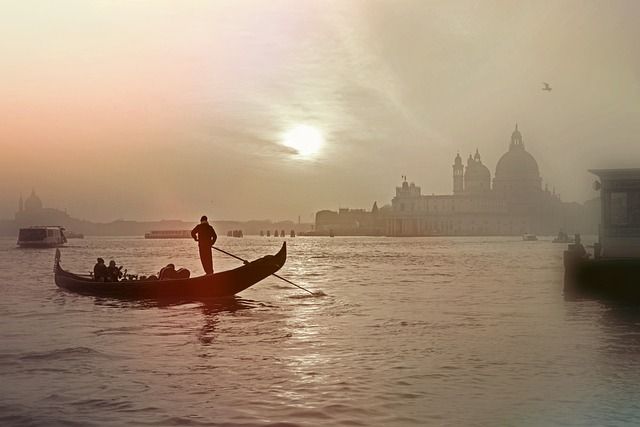
If you want our opinion (we run some restaurants in the city), the least busy time to visit Venice is January only .
Many shops, hotels and restaurants, in fact, decide to close during the coldest month of the year, just after the Christmas celebrations. They all open again to celebrate Carnival.
During January you would expect fewer tourists and of course fewer crowds . It's the perfect time of the year if you want to visit many attractions and museums.
November can also be considered off season. However, if you come here in the last week of the month, the city is more crowded than ever.
In fact, this is the moment to celebrate the Madonna della Salute (Holy Mary of the Health) and to organize a splendid festival with a beautiful floating bridge and beautiful fireworks !
When to visit Venice if you are traveling on a budget
From November to January is the best time to visit Venice on a budget . Hotel rates are lower and the city is less crowded.
Of course, you should avoid the last weeks of December for obvious reasons.
Please explore our guide on how to stay in the city to save some money .
In conclusion, which is the best time to visit Venice Italy?
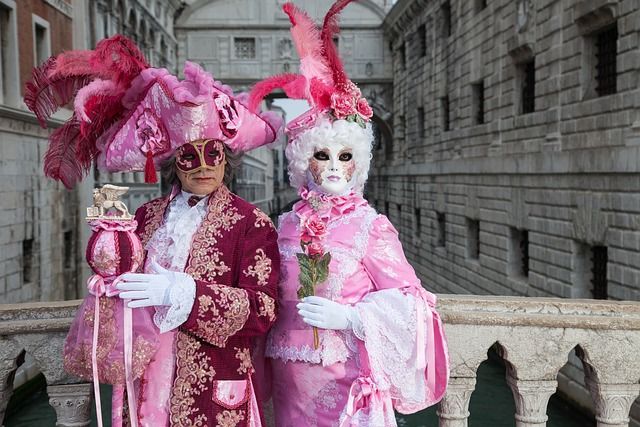
As you probably have understood by reading carefully through the article, there is not a better moment to visit Venice.
It all depends on which kind of person you are and which kind of things you want to do.
If you don't stand high temperatures, please do not come here during July or August, but if you want to experience some of the craziest and traditional events this is the perfect time to come here.
If you want to stay quiet inside the museums and do not have to think about how to avoid large crowds, come here in November or January. However, this is also the coldest time of the year, with many rainy and foggy days.
You just have to be prepared to make the best out of your visit to the city !
Popular tags
The Best Time to Visit Venice
Italy › Venice › Best Time to Visit Venice Updated: May 4, 2022 By Santorini Dave
- Venice – Best Places to Stay
- Best Hotels in Venice
- Best Hotels for Families in Venice
When is the best time to visit Venice?
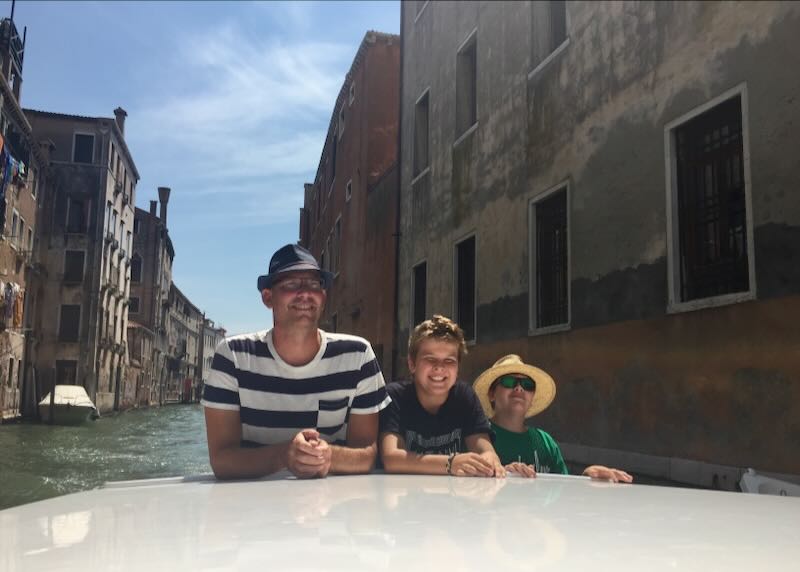
Me and my two boys in Venice on a summer visit.
My favorite time to visit Venice is during April, May, September, and October when the city is warm and dry but not too hot. I try to avoid visiting in August when the weather is hot and muggy and many Venetians leave for a month-long vacation. Winter is excellent for avoiding crowds (except during Carnival season), but it is rainy and the chance of flooding increases, though typically not enough to prevent sightseeing.
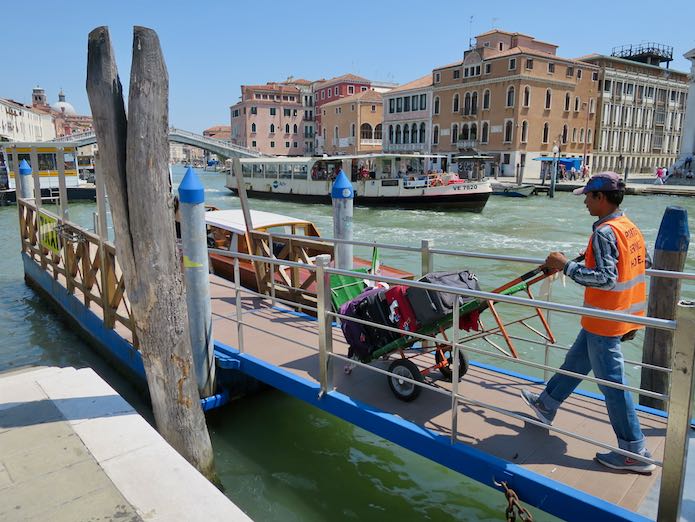
The best time to go to Venice is April, May, September, and October.
- Best Time for Sightseeing : Mid-spring, and particularly the first half of May, is the very best time to enjoy sightseeing in Venice. The cold of winter has lifted and the sun makes a daily appearance, while temperatures are comfortably warm. Tourist services are fully operational, yet you’re unlikely to run into large crowds. Unless your goal is to spend your days lying on the beach, there is really no downside to visiting in May. If going in May is not an option, the second half of September is your next best bet, with the crowds of summer beginning to thin, and temperatures cooling down some. August is arguably the worst time for sightseeing in Venice, with stifling heat and high humidity, lots of bugs and plenty of sweaty tourists to contend with. No matter what time of year you’re in Venice, visiting the most popular attractions like St. Mark’s Square, is best enjoyed during the early morning hours. Not only will you have the best chance for being at the front of the queue for places like the Basilica and the Campanile, but you can take advantage of the early morning light for especially magical photos.
- Best Time for Visiting the Rialto Markets : The Rialto Bridge, located in the oldest and most central quarter of the city, has been a bustling hub for hundreds of years. No matter what the season, the area is always filled with tourists. This is one spot where you won’t notice a significant difference in crowds between summer and winter other than the temperature. As with many other popular destinations, the best time to visit is early in the morning – before 9am, on a Friday or Saturday; the markets begin winding down after lunchtime. By going early in the morning, not only will you see the local fish and vegetable market, but you can also enjoy a fairly tranquil scene at the bridge. The Rialto Market is open Tuesday through Saturday from about 7:30 a.m. to about 1:00 p.m. On Mondays, the fruit and vegetable vendors are open, while the seafood stalls are closed.
- Best Time to Attend Carnivale : Carnivale is one of the biggest celebrations in all of Italy, but there is no place in the country that does it bigger or better than Venice. It takes place here, and many places around the world, 40 days before Easter, with a final party before Ash Wednesday and Lent. The events typically last for two to three weeks before the actual Carnival Day (Shrove Tuesday – the day before Ash Wednesday). While many events, like the opulent masquerade balls, require invitations and have very high ticket prices, many others, like the candlelit parade of boats, concerts and street performances, are free and open to the public. If you arrive into Venice mid-week during the first week, you might wonder, “why all the hype?” Other than a few low-key events and the skating rink in Campo San Polo, there’s not really a lot going on. But that’s because all of the excitement comes on the weekends, and the final weekend in particular. St. Mark’s Square is the focal point, where you’ll see the most elaborate costumes and masks. On weekdays, the area is generally still fun, and also fairly manageable – on the weekend, visitors flood in and the streets can get very crowded. Away from the costumes and all of the masks, the local areas of Venice are still relatively quiet and peaceful.
- Best Time for a Gondola Ride : Gondola rides are available throughout the year, and while anytime is a good time for this unforgettable experience, it may be most romantic in winter, early Spring, or late Autumn, with less boat traffic on the canals, the water especially tranquil and blankets available to cuddle up in and ward off the chill. It makes for a more intimate ride than a summer adventure when the waterways are packed and temperatures are sizzling. No matter what the season, the time of day you go matters too. Just about everyone plans to go at sunset or just after dusk, which means the canals will be jam-packed with gondolas. If your priority is to capture that idyllic photograph, choosing to go in the late morning or early afternoon hours may be best, as crowds will be at a minimum and you’ll have plenty of light, not to mention, it’s less expensive too.
- High Season (June through August) : Venice’s very busy high season falls in the summer. During this time of year tourists are crammed into even pricier gondolas and hotels charge their highest rates. This season also means stifling heat and pesky bugs, but if a summer vacation is a must, or if you simply enjoy the excitement of the crowds and want to take advantage of longer days with an abundance of sunshine, going to Venice during high season may be for you. Summer in Venice is more temperate than in Italy’s scorching inland cities, and as most Venetian hotels come with air-conditioning, it can be pleasant, or at a minimum tolerable.
- Shoulder Season (March through May, September through November) : Shoulder season in Venice falls in the spring and autumn months, both beautiful times of the year to be in the City of Canals. In the spring, Venice defrosts, with temperatures rising from the lower 50s in March to the lower 70s in May, and in the fall, the city begins to empty of peak summer crowds, making for a magical atmosphere, though you’re likely to need a coat as November’s temperatures range from the upper 30s to lower 50s.
- Low Season (December through February) : Winter is low season, which means none of the sweat and stress of the high tourist season, with temperatures averaging in the 30s and 40s. While this time of year certainly has its advantages, with few crowds and discounted accommodation rates, keep in mind that sights may have shorter hours – many close as early as 5pm – and there will be fewer activities available. February, during Carnevale, is the exception, when rates are high, crowds are vast and there are numerous events to take part in. This season can bring some flooding, particularly at St. Mark’s Square and along Zatteree at the southern edge of Venice, though it’s unlikely to significantly affect sightseeing plans. A number of tabacchi (tobacco shops) and a few souvenir shops sell boots that will help keep your feet dry.
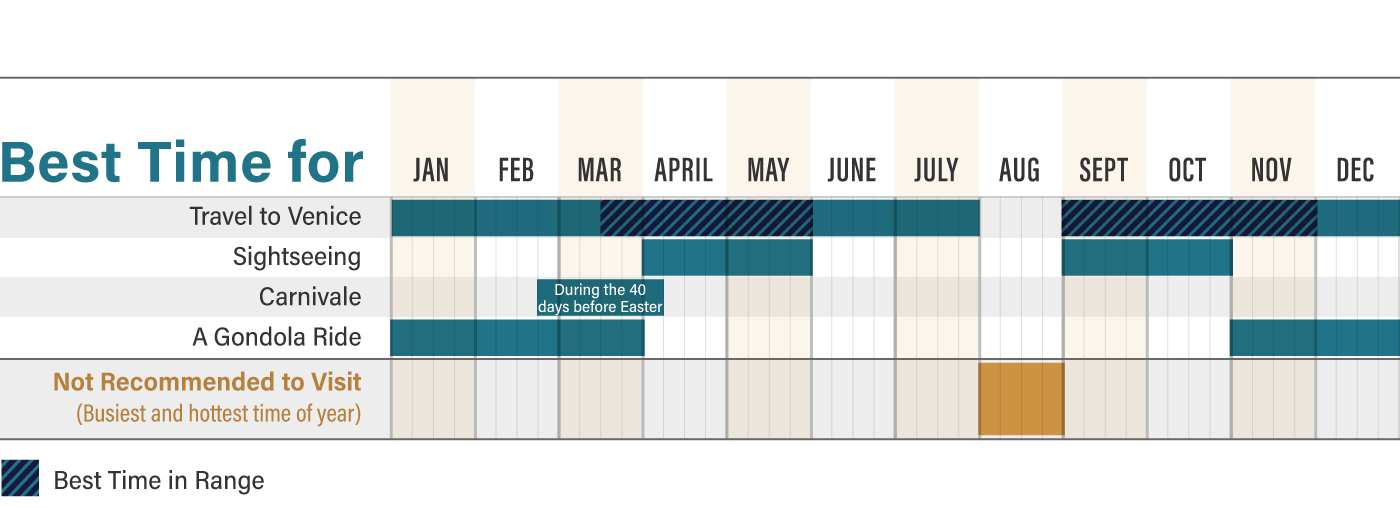
Venice Weather by Month
- Venice Weather in January : Venice is at its coldest, and quietest, in January, with daytime temperatures typically hovering around 3°C and sometimes dipping below freezing, particularly at night. This is when that famous Venetian fog rolls in that gives the canals a ghostly, romantic atmosphere. Most days are partly cloudy, and you should expect to experience rain on an average of nine days in January, with about 58mm falling in total. Often, there is moderate or light rain during at least part of the day. While it’s usually not enough to keep one indoors, as it’s rather chilly, you should plan on dressing in layers, bringing a warm coat, hat, gloves and a scarf. On the plus side, the cruise ships have long departed, and you won’t have to fight crowds to see the sights. (Average Max Temperature: 6°C. Average Precipitation: 58mm.)
- Venice Weather in February : February can still be quite cold in Venice, with temperatures typically hovering around 5° to 6°C and overnight lows just a bit over freezing at 1°C. Warm clothing is a necessity as it was in January, but the days are growing longer now. Rain isn’t significant, but with the heavy fog, it will likely feel rather damp. A month earlier, there was about nine hours of sunlight, by February 1 that increases to 9 hours and 45 minutes, and by February’s end, you’ll enjoy slightly over 11 hours of light with the sun setting just before 6pm. As fog is usually quite heavy now, it can make for an especially romantic canal ride. (Average Max Temperature: 8°C. Average Precipitation: 50mm.)
- Venice Weather in March : Temperatures in March are becoming milder, but it’s still cool, so you’ll need to pack that hat, scarf and coat. Temperatures range from about 8°C to 12°C during the day, dipping down to 4°C at night. This month is wetter, with around 64mm of rainfall on an average of 12 days; precipitation is likely to occur as moderate rain, with occasional light rain and thunderstorms as well. A raincoat with a hood will allow you to get around comfortably. There are about 12 hours of daylight on average, with 12 hours and 46 minutes by March 31 when the sunsets just after 7:30pm. (Average Max Temperature: 12°C. Average Precipitation: 60mm.)
- Venice Weather in April : April ushers in much more pleasant weather, though it doesn’t get too warm. It’s the beginning of sunshine in Venice, with open-air cafes and lots of fabulous places to soak up the joyful atmosphere. The average high temperature has increased to 16°C and overnight lows are a rather comfortable 12°C. This month experiences about the same amount of rainfall as March, with around 64mm coming down over an average of 13 days in April, mostly as moderate rain, along with occasional thunderstorms. On most days, light clothing is appropriate, though as the weather tends to change frequently, bring along a light jacket with a hood and/or an umbrella. The days are significantly longer than they were over the winter months, with more than 14 hours of daylight and sunset at 8:17pm on April 30. (Average Max Temperature: 16°C. Average Precipitation: 60mm.)
- Venice Weather in May : May marks the official start of the tourist season, and temperatures start to rise, with sunshine brightening up the entire city. You’ll start to notice more bugs, along with bigger crowds and sweatier tourists. The average temperature is around 21°C, which means a light shirt or top and pants or shorts are typical daytime attire, though you may need a sweater in the evening with temperatures dropping to 12°C after dark. Pack a bathing suit, as it will probably be warm enough to soak up the sunshine on the beach, or to take part in watersports like jet skiing. There is typically 70mm of rainfall over 11 days in May, often coming down as moderate rain or thunderstorms. There is a significant difference in temperature from May 1 to May 31, with highs averaging around 15°C early in the month, increasing to highs of 23°C by the end of May. (Average Max Temperature: 21°C. Average Precipitation: 70mm.)
- Venice Weather in June : The tourist season is now in full swing – and, so is the heat. Expect hot, sunny and long days; the longest day is June 20, which brings nearly 16 hours of sunlight. Pack your beachwear, including a bathing suit and sunscreen, along with t-shirts, shorts and capris. The average high temperature is 24°C and it doesn’t cool down much at night, with low temps average 16°C. Rain this month occurs on an average of 12 days, often as afternoon thunderstorms.
- Venice Weather in July : July is the hottest month in Venice, and the peak of the tourist season. The average high temperature is 28°C, with lows dipping only to around 18°C overnight. Pack your bathing suit so that you can cool off in the water at beaches like Lido, along with t-shirts, shorts and sandals to wear during the day and nice casual, light clothing for going out in the evening. Due to the high temperatures, and long hours of sunshine (over 15 ½ hours on July 1), be sure to bring and wear high SPF sunscreen as well as a hat. Around 63mm of rain falls on an average of 10 days in July, most of it through summer thunderstorms. (Average Max Temperature: 28°C. Average Precipitation: 63mm.)
- Venice Weather in August : August in Venice is still very warm and very busy, though the average high drops a degree to 27°C this month. At night you can expect the same, with warm, relatively pleasant evenings, and the temperature dropping to 18°C. Rain increases slightly to 70mm over nine days, mostly as thunderstorms, and there is about 14 hours of daylight, with August 31 the shortest day and the sun going down just before 8pm. August is a good time to get out on the water and go sailing or rowing, to cool off from the intense heat, but if you aren’t able to, be sure to duck under an umbrella or head inside during the hottest part of the day. (Average Max Temperature: 27°C. Average Precipitation: 70mm.)
- Venice Weather in September : Temperatures are slowly beginning to drop now, reaching an average high of 24°C and a low of 15°C, while tourist crowds start to thin. During the day a short-sleeve shirt and pants or even shorts are usually adequate, though you may need a sweater if a cool breeze blows through. Rain generally isn’t significant, falling on an average of nine days in September, mostly occurring in the form of thunderstorms followed by light rain. The days are getting shorter, with a little less than 12 hours of sunlight by the month’s end. (Average Max Temperature: 24°C. Average Precipitation: 70mm.)
- Venice Weather in October : It’s noticeably cooler in October, and much less busy with the tourist season having come to an end. Days are pleasant, typically around 14°C to 16°C, and after the sun goes down, you’ll likely need a sweater or jacket as the temperature drops to an average of 10°C. Expect about the same amount of rain as last month, with 70mm falling over 10 days, mostly moderate with the occasional thunderstorm. Daylight is decreasing, to just over 10 hours of sunlight on October 31 and sunset at about 5pm. (Average Max Temperature: 18°C. Average Precipitation: 70mm.)
- Venice Weather in November : Weather is changing dramatically now, with high temperatures dropping to an average of 11°C and lows to 4°C. As this is one of the rainier months in Venice, rain increases particularly during the second half of the month, making the need for an umbrella and warm jacket more likely. There is a rather large difference in temperature from the beginning to the end of the month, starting out with highs around 10°C, dropping three degrees to 7°C by month’s end. Overnight, temperatures hover just a few degrees above freezing. (Average Max Temperature: 11°C. Average Precipitation: 70mm.)
- Venice Weather in December : One of the coldest months of the year in Venice, in December the average temperature typically only reaches as high as 7°C, and after dark, it often falls to right about freezing. You’ll need to bring your cold weather gear, including a warm jacket, heavy sweaters, a hat, gloves and scarves. An umbrella and waterproof shoes or boots are likely to be appreciated too. A heavy fog and mist rolls in now, creating a haunting cityscape along with a chill in the air. The days are shorter now, with the shortest day falling in mid-December bringing less than nine hours of daylight and the sun setting at 4:30pm. (Average Max Temperature: 7°C. Average Precipitation: 50mm.)
Venice Events and Festivals by Month
Venice events in january.
- New Year’s Day – New Year’s Day is a national holiday in Italy, and in Venice, most attractions, including museums as well as shops, restaurants and other services are closed. Many Venetians celebrate the start of the new year by taking a morning dip in the chilly waters from the beach on the Lido.
- Ephiphany/La Befana – This national holiday held annually on January 6, marks the 12th day of Christmas and is one on which Italian children wake up to toys and candy in their shoes, celebrating the arrival of La Befana, a good witch. In Venice, it’s also celebrated with a regatta known as La Regatta delle Befane, which features men dressed up like the witch who race boats in the Grand Canal.
- Festival of Saint Anthony (The Feast Day of Saint Anthony Abbott) – This Italian holiday held on January 16 and 17 in Venice, celebrates the patron saint of butchers, domestic animals, gravediggers and basket makers. In Venice, it traditionally marks the start of the Carnevale season. The tradition of the festival begins with a bonfire outside of two churches near the square, and is followed by a mass on the morning of the 17th. At the conclusion of mass, visitors can observe the release of balloons in the piazza which represent blessings for all children and animals.
- Post-holiday Sales – A state-mandated sale period begins in January and lasts for six to eight weeks. While the date varies each year, the sales usually begin early in the month, after La Befana, and are known for offering some very good bargains, often with discounts of 25 to 35 percent or even more. Look for signs in shop windows reading SALDI, which means “sales.”
Venice Events in February
- Carnevale di Venezia – Carnivale is celebrated across Italy, but Venice is known for throwing one of the biggest parties of all. Here, the entire city center is transformed into a living theater set for two entire weeks or more, following a tradition that originated back in 1162. It involves tens of thousands of costumed participants who attend masquerade balls and take part in activities like street performances, juggling, and a nonstop program of historical plays in the central Piazza San Marco. The “grand finale” includes a candlelit, silent water parade where hundreds of gondolas float along the Canal Grande. Travelers from across the globe crowd into the city to enjoy the parades on land and in the canals, food fairs, children’s carnivals and many other activities. It takes place 40 days before Easter, with a final party before Ash Wednesday and Lent. The events typically last for two to three weeks before the actual carnival day, the day before Ash Wednesday, which changes every year according to when Easter falls.
- Valentine’s Day – Surprisingly, it’s only been in recent years that Italy has started to celebrate the feast day of Saint Valentine, or Festa di San Valentino, with love letters, hearts, and candlelight dinners. You can celebrate by taking a gondola ride and kissing under the famous Bridge of Sights, enjoying two-for-one admission at some of Venice’s museums or toasting to your love with a drink at an outside table in Saint Mark’s Square after dark.
Venice Events in March
- Festa della Donna – Women’s Day is celebrated annually on March 8 throughout Italy, honoring mothers, and all women. On this day, men bring flowers, usually yellow mimosas, to the women in their lives, and restaurants offer special meals honoring women. If you plan to dine out on this day, reservations are recommended. Watch for concerts and local events that will be held around Venice and other cities through Italy.
- Festa di San Giuseppe – This is Father’s Day in Italy. The Feast Day of Saint Joseph includes the tradition of children giving gifts to their fathers, and zeppole (a fried dough similar to a doughnut) is consumed.
- Holy Week and Easter – Holy Week, or Easter Week, may be in March or April. It always begins on Palm Sunday, the Sunday before Easter. This is a very busy time in Venice, with tourists crowding the city rather than locals. Because it’s a long weekend, many Italians take the opportunity to get out of town, heading to the countryside, the sea, or the mountains. Visitors can enjoy pageants, classical music concerts and Easter services during this time. Most major sights and museums will be open on Easter Sunday and Monday, though many shops and restaurants will be closed.
Venice Events in April
- Settimana della Cultura – The Week of Culture is typically held in mid-April, though the exact dates aren’t usually released until just before the event. During this time, many national museums and sites offer free admission. Some museums in Venice that participate include the Accademia, the Ca d’Oro and the Archeological Museum, among many others.
- Festa di San Marco and Liberation Day – Held annually on April 25, this busy day on the Venetian calendar is an important religious observation of the city’s beloved patron, Saint Mark. He’s feted on this day with a gondoliers’ regatta that includes commemorations of the saint who died on April 25, 68 AD at Saint Mark’s Basilica, and festivities in Saint Mark’s Square. Tradition also includes men giving their wives or girlfriends the “bocolo,” the bloom of the red rose. The day also marks the anniversary that Italy was liberated at the end of the Second World War.
Venice Events in May
- Labor Day and the Festa della Sparesca – International Workers’ Day, or Labour Day, is a national holiday held on May 1 each year. Many Venetians leave town for the long weekend, while those who stay can witness the gondolier regatta known as Festa della Sparesca held at Cavallino in the lagoon.
- Festa della Sensa – The Festa della Sensa is an ancient celebration commemorating Venice’s relationship to the sea. It takes place on the first Sunday after Ascension Day (40 days after Easter). Festivities include a magnificent procession at sea, with colorful parade boats from all the rowing associations in Venice following the Serenissima which carries the mayor and the patriarch.
- Vogalonga – Held the weekend following the Sensa festival, Volalonga is a thrilling rowing race that includes as many as 3,000 participants. The 32-kilometer course runs from San Marco Basin to the island of Burano and returns through the Grand Canal, concluding at the Punta della Dogana. This is a fantastic event to watch, with the suffocating motorized boat traffic ceasing, and the water is left to the oars.
Venice Events in June
- Festa della Repubblica – Republic Day is a national holiday held on June 2 each year. It is similar to Independence Day in other countries, and celebrates the nation becoming a Republic in 1946. Though many businesses, including museums and restaurants, will be closed, there are almost always some eateries open that cater to the countless visitors that flood the city during high season. Keep an eye out for posters announcing special festivities and concerts throughout town.
- La Biennale – This month-long contemporary arts extravaganza beings in June every other year during odd-number years, and runs through November. Sixty days after Easter, Corpus Domini, honoring the Holy Eucharist, is celebrated by Catholics. In Venice, this day typically features a long procession in and around St. Mark’s Square. It’s believed to be the oldest of its kind in the country, dating back to 1317.
- Palio of the Four Ancient Maritime Republics – This boat race rife with medieval pageantry is hosted in Venice every four years. The traditional regatta shifts between Pisa, Genoa, Amalfi and Venice. Prior to the race is a parade, with participants donning medieval dress and marching through the streets.
Venice Events in July
- Festa del Redentore – July’s biggest event is the Festa del Redentore, or Festival of the Redeemer, which marks the end of an epidemic in 1576. It is accompanied by fireworks and a rowing competition, while the footbridge from the mainland to Giudecca, which is created from a connected flotilla of boats, becomes one of Venice’s most famous bridges. The unique event is renowned throughout the country, with boat parades and elaborate Venetian-style dinner hosted at numerous restaurants before the big pyrotechnic show begins. Dinner reservations must be made well in advance as seats are limited.
- Arena di Campo San Polo – This open-air cinema begins in late July and runs through the end of August. It features the largest screen in Venice and includes films that are generally reruns of the previous season’s blockbusters, but there are also a number of premieres as well. Most are in Italian, or dubbed into Italian, although six films in the original English language version are typically also featured.
Venice Events in August
- La Biennale di Venezia – The Venice Biennial is considered one of the most important art extravaganzas in the world. Held every other year during odd-number years, it runs throughout the month of August and includes the International Art Exhibition, International Film Festival and International Architecture Exhibition as well as the Festival of Contemporary Music and International Theatre Festival.
- Ferragosto – The traditional beginning of the summer holidays for most Italians, Ferragosto, held on August 15, falls on the religious holiday of Assumption. It marks the time when local Venetians head out of town, to the beach or mountains, to escape the heat and mosquitoes that summer brings. While some businesses will be closed, many stay open, catering to tourists. Fireworks are a very big part of Ferragosto across the country, including in Venice.
- Venice Film Festival – The Venice Film Festival is an annual internationally known film festival on Venice Lido that brings out a bevy of stars who grace Venice’s gondolas and red carpets.
- Outdoor Concerts and Movies – Several squares around Venice host outdoor movies and concerts throughout the month of August, including Campo San Polo. Look for the posters with information about the events.
Venice Events in September
- Regata Storica di Venezia – Venice’s Historic Regatta is one of the most spectacular events in Venice, and the most important event on the rowing calendar, highlighting the city’s reliance on boating and waterways. Taking place on the first Sunday of September annually, it is made up of four different races and involves many different types of boats, including the gondola. Teas of gondoliers, some decked out in costume, race a course along the Grand Canal. The event is accompanied with much fanfare, food and music.
- Festival of the Triumph of the Cross – September 14 is a holy day marked annually with a procession at the church and grand school (Scuola Grande) of San Giovanni Evangelista in the Sestiere di San Polo.
Venice Events in October
- Opera Season at La Fenice – Venice’s famous opera house is an unforgettable place to see an opera, and is highly recommended, even for non-opera fans.
- Venice Marathon – Every fourth Sunday in October, this internationally recognized race begins on the mainland and finishes in St. Mark’s Square.
- Halloween – Although Halloween isn’t an Italian holiday, it’s become increasingly popular in recent years, particularly among young adults. Many of the shop windows feature Halloween décor, and nightclubs, bars and restaurants on the Lido host Halloween costume parties.
Venice Events in November
- All Saints Day – November 1 is a public holiday. This is a time when Italians remember their deceased loved ones by visiting cemeteries and graves. In Venice, families traditionally crossed a pontoon bridge to the island cemetery of San Michele, placing flowers on the graves of their saintly or secular relatives. Today, they make the trip by vaporetto or water taxi, though the idea is the same, honoring the dead and keeping in touch with the loved ones they expect to see in the hereafter.
- Festa di San Martino – On November 11 each year, kids armed with their mothers’ pots and spoons raise a ruckus around Venice, chanting the saint’s praises and demanding trick-or-treat-style tokens in return for taking the noise elsewhere.
- Festa della Salute – The festival of La Salute is held annually on November 21. The day commemorates the plague that decimated much of the city’s population, when one-third of Venetians died from a plague that occurred in the early 17th century. Celebrants give thanks at the church of the Madonna della Salute in the Dorsoduro sesteire, which was built by survivors. City workers lay a footbridge built on pontoon boats across the Grand Canal which leads from the San Marco quarter to the steps of the church where the main doors are opened, as they are just once a year and have been for nearly four centuries, to receive the masses for mass.
Venice Events in December
- Hanukkah – Venice celebrates Hanukkah in the Ghetto, which is the Jewish area of Venice that was the first segregated Jewish community in Europe. If you visit, you can witness the lighting of the Menorah, sample kosher food finds and enjoy a variety of Hanukkah festivities.
- Feast of the Immaculate Conception – On December 8, Catholic faithful celebrate the day of the Virgin Mary’s conception of Jesus. This is a national holiday which means many businesses may be closed.
- Christmas Markets – From mid-December through mid-January, the festive Christmas market in Campo Santo Stefano is filled with stalls selling beautiful Venetian handicrafts, including nativities, children’s toys, and delectable seasonal treats. Live music is also part of the festivities.
- Christmas Eve/Christmas Day – Venetians celebrate Christmas Eve with a multi-course fish dinner, and many follow the meal with a midnight Mass at Saint Mark’s Basilica with services in Italian, English, French and German. Everyone is invited, and although it technically starts at 11:30pm, you’ll need to get there a few hours before to reserve a seat. On Christmas Day, everything will be closed. Venetians celebrate over a large lunch with family and opening presents. You can follow them later to a free concert held at 4pm at the Santa Maria Gloriosa dei Frari church.
- Festa di San Silvestro/New Year’s Eve – December 31st in Venice, and throughout Italy, is celebrated with plenty of fanfare. You’ll find parties throughout the city, and in Piazza San Marco, hundreds of visitors fill the square to enjoy fireworks, toasts, music and a midnight kiss.
About Santorini Dave

We will be in Italy in late March of this year. We will be arriving in Milan on March 30. We were planning to visit Venice on March 31 (Saturday) however Easter this year is on April 1. Trying to determine when would be the best day to visit Venice Saturday or Sunday? We don’t celebrate Easter, however, we would like to go on a day in which shops will be open and we can get the best out of our day trip. What would be your suggestion?
Saturday will be slightly less busy than Easter Sunday but both will be very busy. (And Easter Monday busier still.) Most shops and restaurants in Venice will be open during Easter but still might be some surprisings.
Hello. Any recommendation for a good restaurant with a scenic view in Venice? (Visiting in November.) Thank you Dalia
Terrazza Danieli has great food and view.
I’ve been wanting to visit Venice for as long as I can remember. If you had a favorite month – or even a favorite week to visit Venice what would it be? Looking for good weather that’s great for walking. Smaller crowds would also be nice (though not as important as good weather.) I’ll be there with my husband and we both love food. Is there an area of Venice that is good for excellent food and true Italian food? – would love to avoid the tourist spots, but perhaps everywhere is touristy. Advice and recommendations appreciated.
Thank you, Stefani
I’d go for late September-October as crowds drop a lot once school in Europe has gone back. October can be warm and sunny with beautiful light – but naturally these days the old weather patterns vary a bit so there’s never a guarantee. However to be honest, Venice is a special experience in whatever conditions. Mid winter in the fog can be very romantic! For food I’d recommend the Cannaregio district with its many neighbourhood eateries. If you’re interested in local food be adventurous and ask the waiter for suggestions and what’s in season. Avoid restaurants that offer a set tourist menu. Venice is touristy but a lot of people live there too and they need to go out to dinner too so it is possible to have a good authentic meal.
Any preference between traveling to Venice in early June or late September (crowds, hotel rates, weather)? Also, how far in advance would you book hotels for a June or September visit? And how far in advance should we book our train tickets from Rome to Venice? Thank you, Shawn
Early June can be hot (though these days weather forecasts are hit and miss) while late September tends to be more comfortable in terms of temperatures. Both will be fairly crowded but that’s Venice. (The quiet time is midwinter). Both periods are pretty well high season in terms of hotel rates though advance booking can often get you a good deal. Train tickets can be booked up to 3 months ahead on Trenitalia.com but tickets can also be purchased at the train station. Trains to Rome are plentiful so booking more than a day in advance isn’t necessary (though you may not get your choice of departure at the last minute).
Hope this is helpful.
Leave a Reply Cancel reply
Your email address will not be published. Required fields are marked *
- Skip to primary navigation
- Skip to main content
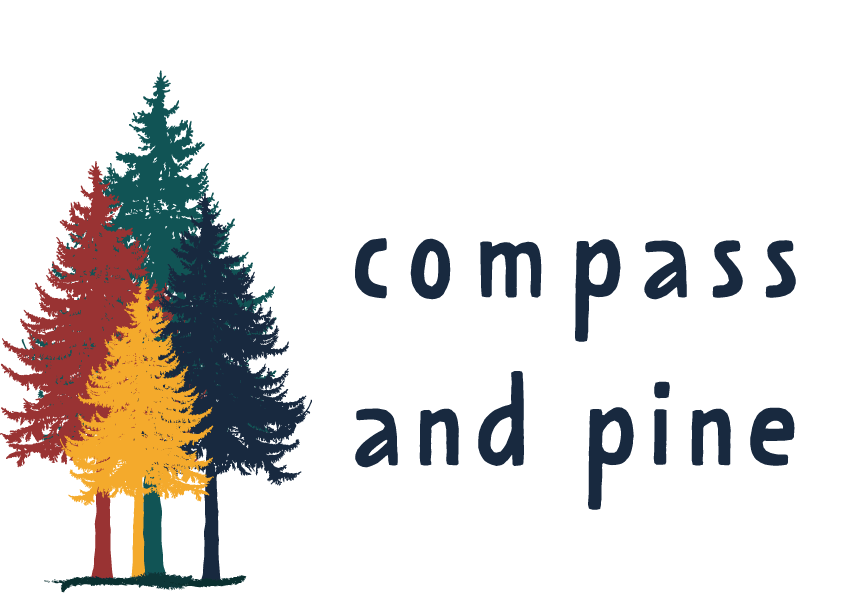
Compass & Pine
The Ultimate Travel Guide

Best Times to Visit Venice
If you’re considering a trip to Venice, you might wonder when to visit. The answer, of course, depends on what you’re looking for. If you want to experience the city’s busiest and most vibrant, you’ll want to come during peak season. But be warned: Venice can be incredibly crowded during this time. If you’re looking for a more relaxed vacation, shoulder season or even off-season may be a better bet. Keep reading to learn more about the different factors that can affect your decision on when to visit Venice.
Venice’s Weather by Month
Shoulder season in venice, peak season in venice, off-season in venice, how much does it cost to vacation in venice, what is the cheapest month to go to venice, how much money should i take to venice for 3 days, where is the best location to stay in venice, how many days do you need to see venice, can i speak english in venice, what month does venice flood, when is the rainy season in venice.
The National Centers for Environmental Information (NOAA) reports that Venice’s climate has typically ranged from a freezing 30°F (-1C ) to a comfortable 86° F (30C) over the past several years.
Remember that these are only monthly average temperatures; hotter or colder days could happen during the month.

For example, although the monthly average temperature for Venice in July is 86° F, don’t be fooled into thinking the temperature remains consistent the whole month. You will likely experience some days above 90 degrees and others in the 70s.
Similarly, in colder months, don’t expect the temperature to always stay cold; you may find yourself suddenly surprised by warmer conditions than anticipated.
For those who prefer a moderate climate, rejoice! Venice is an excellent place for you. Every time I’ve been to this beautiful city, it has provided me with an ideal temperature – never too hot or cool. I find Venice’s average temperatures to be a great mid-point.
When it comes to weather, though, rain, wind, and humidity will all contribute to the perceived temperature. Make sure you have at least one outfit for each occasion.

(March-May and September-November)
Experience the beauty of Venice during its shoulder season and reap the rewards! Prices for hotels and flights are substantially lower than during peak season, helping you explore the city on a budget.
Furthermore, you can explore Venice and everything it has to offer with significantly fewer crowds. Despite a potential dip in average temperature or an unforeseen shower, visiting Venice in shoulder season is undoubtedly worth it.
Shoulder season in Venice generally runs from mid-March to early May (spring) and late September to November (autumn).
If you visit Venice in the spring, you’ll be treated to warming temperatures and longer days. The downside is that it can still be chilly, so pack a light jacket or sweater.
Autumn is also a beautiful time to visit Venice. The weather is cool but not cold. Just be prepared for some rain.

(Late May-August)
Peak season (or high season) in Venice runs from late May to August when the average temperature is warmest, and the city experiences the least rain. This is the most popular time to visit Venice, so expect high prices and large crowds.
Book your hotel and flights well in advance if you plan a trip to Venice during the high season. Prices will be increased during this time of year, and accommodation may fill up quickly. We recommend booking a place in the Cannaregio district as hotel rates are often the most affordable and the district is quiet (i.e., further from the touristy sections).
On the plus side, there’s a lot to do in Venice’s high tourist season: outdoor cafes, restaurants with outdoor seating, gondola rides, festivals, famous Venetian churches to explore, and more.
While they’ll be very crowded during peak season, you should visit Burano, Murano, Lido, and Torcello. We wrote guides on the Best Things to Do In Burano , the Top Things to Do in Murano , and the Best Things to Do in Torcello .
Plus, have you really been to Venice if you didn’t go during the hustle and bustle of tourist season?

(December-February)
Winter is Venice’s low season and the best time to visit if you don’t mind the cold and like to explore places without crowds. From December through February, temperatures are at their lowest. However, I can assure you that Venice still has plenty of activities during this time.
The first time I took a tour of St. Mark’s Basilica and Doge’s Palace was in January 2018, and it was fantastic. Low crowds meant I got to interact with our guide, ask questions, and request to visit certain areas of the museums.
The canals may be a bit chilly, but with fewer crowds in the city, you’ll get to explore more at a slower pace and take in all the details that Venice has to offer. Plus, there’s nothing like walking through Saint Mark’s Square uninterrupted and alone.
The one exception to the low season is Venice’s carnival. Thousands gather to participate in parades, parties, and other unique festivities – like wearing traditional masks and garb. Read our guide to the Venice Carnival – including tips on food, parades, and the history of this event.

Events and Holidays in Venice
New Year’s Day concert at Teatro La Fenice. You’re in for a treat if you don’t know anything about La Fenice. It made our list of the top 10 things to do in Venice . This majestic opera house, renowned for featuring some of the greatest singers and composers from Italy and Europe, is one of the most revered venues in the world. Boasting a storied history, it has held countless performances that have captivated audiences for centuries.
Carnevale – Now a national holiday, this is the most significant event in Venice and one of the largest in Italy. Throughout February and March, you’ll find an abundance of revelry and traditional masks everywhere you turn. As part of this festival, visitors can partake in parades, parties, fireworks shows, concerts, food markets, and more! If you want to learn more, we wrote an in-depth guide to Carnival in Venice . Keep in mind that hotel rates are at their highest during carnival.

Su e zo per i ponti (“Up and Down the Bridges”) – a non-competitive walk that starts in the Piazza San Marco, in front of the Doge’s Palace, and follows designated routes throughout the city that leads walkers through calli (streets), campi (squares) and ponti (bridges).
Celebrated annually on April 25th, St. Mark’s Day honors Venice’s beloved patron saint, Mark the Evangelist. Popularly known as the Feast of Saint Mark or Rosebud Festival, it is a day cherished by Venetians and Sardinians.
Biennale di Venezia (“Venice Biennale”) – an art exhibition that has been held since 1895 and showcases modern and contemporary works of art and architecture from the best international talent. The year’s focus rotates annually between art and architecture (hence the name biennial).
Vogalonga – an event where Venetians and visitors participate in rowing races throughout the canals of Venice in protest of wave damage caused by motor boats and lagoon degeneration. Venetians are not alone in this plight; people from all corners of the globe have come to offer their support and bring enlightenment.
Salone Nautico – Venice’s primary boat show. Held at the Arsenale of Venice, it features a wide variety of luxury yachts, super yachts, sailboats, and some of the world’s most impressive vessels.
Festa de San Pietro de Casteo – The first of the summer holidays is a a festival celebrating the end of June and the arrival of summer. This event is a feast for the Saints Peter and Paul, who are venerated in the basilica of San Pietro. It celebrates Venetian culture and features musical shows, games, and food festivals.
Regata delle Antiche Repubbliche Marinare (“Palio of the Historical Maritime Republics”) – a historical re-enactment aimed at recalling the rivalry of the most famous Italian maritime republics: the republics of Amalfi, Pisa, Genoa, and Venice. Four rowing crews representing each republic compete against each other to bring honor to their city.
Festa del Redentore – a religious holiday in which Venetians commemorate the end of a terrible plague in 1576, which killed 50,000 people, and ended the lives of several prominent figures, including renaissance painter Titian.
This celebration features fireworks and boat parades throughout Venice’s canals every year. The highlight is visiting Il Redentore church, one of the oldest and most beautiful cathedrals in Venice , designed by famed architect Andrea Palladio to commemorate the end of the plague.

Ferragosto – A traditional Italian holiday that started with Feriae Augusti, commemorating Emperor Augustus’ decision to designate the 1st of August as a day of rest for those who had worked tirelessly in the agricultural sector.
Venice Film Festival – Hosted at the Venice Biennale on Lido Island , this event is one of the most prestigious film festivals in the world. It features screenings of over 100 international films and documentaries each year, as well as awards ceremonies and special events.
Regata Storica – a traditional boat race that takes place on the Grand Canal and is intended to evoke Venice’s maritime history. The Regata Storica features elaborately decorated boats and pageantry.
Venice Marathon – held annually since 1986; this course starts in Stra and passes through Mestre, Parco San Giuliano, and Ponte della Libertà before ending at Riva dei Sette Martiri in Venice.
Festa della Madonna della Salute – a religious event that commemorates the end of the Great Plague in 1630. During this day, Venetians and tourists gather at this beautiful Venice cathedral to pay homage to the Virgin Mary and give thanks for her protection.
Christmas – the highlights are the markets around the Rialto Bridge and Piazza San Marco. Find traditional dishes, fireworks, and novena scenes that rival those in Rome. Expect smaller crowds at Christmas but larger crowds the closer you get to New Year’s Eve. The same applies to hotel rates: they’re cheaper before Christmas and more expensive near New Year’s.
Frequently Asked Questions

The cost of a vacation in Venice can vary widely depending on the time of year, activities, and accommodation. Generally speaking, prices range from €50 to €200 per day for budget travelers. Prices can go up significantly for those looking for more luxurious accommodations or experiences (like guided tours or visiting neighboring islands Murano , Torcello, and Burano ).
The cheapest month to go to Venice is usually December or January, when the city has fewer tourists and accommodation prices are lower. February is also more affordable, but prices will increase the closer you are to Venice’s carnival.
If you’re looking to visit Venice on a budget, try to travel during the shoulder seasons (March-May and September-November) or the low season (December-February) when average temperatures drop. Be sure to bring warm clothes.
It really depends on what you’d like to do during your stay in Venice, but you should budget for anywhere between €150 to €200 per day. This includes hotel accommodations, food, transportation, and recreational activities.
For budget-conscious travelers, the best location to stay in Venice is Cannaregio . It’s a beautiful and very old section of the city that doesn’t generate as much foot traffic, so hotels are the cheapest in this area. It’s also home to some of the best restaurants in Venice .
If you want to be right where the tourist sites are, you should try to book a hotel in San Marco or San Polo. These locations are home to the most significant sites in Venice (Doge’s Palace, Rialto Bridge, and Saint Mark’s Basilica).
Regardless of where you choose to stay, Venice is a very small city , and it only takes around one hour to walk from one end to the other. So you’ll always be within walking distance of something fun to do and see (read our guide on the 10 best things to do in Venice ).
Tired of walking? Explore our guide to using the Venetian Water Taxi and Vaporetto system .

We recommend a minimum of two days to visit Venice. This will give you enough time to see the major sites and explore a few side streets. However, if you have more time, we recommend extending your stay for at least three days. Then you can spend more time exploring churches, museums, and neighboring islands Murano, Burano, and Torcello.
Yes, most locals in Venice are very familiar with English, and you should be able to communicate easily. However, learning a few polite phrases in Italian (like ‘hello’ and ‘thank you’) is always good practice to show respect for the culture.
Venice’s famous acqua alta (high water) usually occurs in late autumn and winter. The highest tides are usually seen in December, January, and February. While the city doesn’t flood like it used to, thanks to the new MOSE barrier system, check the tide forecast before planning your trip. If it does flood for some reason, souvenir shops sell boots (at a premium).

Venice’s ‘rainy season’ runs from March through November, but the most rainfall is in May and June. If you plan to visit during this time, bring a lightweight raincoat or umbrella!
Ultimately, the best time to visit Venice depends on your goals and budget. Shoulder season provides a more low-key atmosphere and is usually less expensive than peak season. For those looking for an authentic Venetian experience, the off-season is ideal as there will be fewer tourists around, although you’ll face cold winters. High season is Venice at its peak, with plenty to do, beautiful weather, and other tourists.
No matter when you decide to visit, Venice is sure to be a magical destination. With its charming canals, stunning architecture, and vibrant culture, it’s no wonder why so many travelers flock here year after year. Bon voyage!
Have you been to Venice? What do you consider the best time to visit? Let us know in the comments below!
About Todd O'Rourke
Todd is an award-winning writer and filmmaker who co-founded Compass and Pine with his dog Leg. Together, they have traveled extensively throughout the United States and Europe, with their base of operations in Philadelphia.
He started Compass and Pine after living in Vicenza, Italy for three years and falling deeply in love with the country, the people, and, of course, the food.
His favorite city is Florence, Italy, and his favorite National Park is Olympic in Washington.
LinkedIn | About Us
Reader Interactions
Leave a reply cancel reply.
Your email address will not be published. Required fields are marked *
Save my name, email, and website in this browser for the next time I comment.
Explore more
Venice Travel Guide

Courtesy of Andreas Koch | EyeEm

Why Go To Venice
Venice is enchanting. Yes, that may be cliché to say, but once you see the city on the water for yourself, you'll surely agree. Step out of the Santa Lucia train station and the breathtaking Grand Canal will soon greet you. You'll see water taxis coast along, passing underneath the Ponte degli Scalzi (Bridge of the Barefoot) and might hear the faintest hint of a serenading violin, or is that your imagination? It might not be all in your head. Romantic gondolas carrying smitten couples glide through the web of the city's many waterways, and gondola drivers are known to sing when the moment feels right. On land, narrow passageways twist past Old World storefronts and residences, and over bridges. You should note that maps aren't all that helpful here and getting lost is the norm – embrace the disorientation, or enlist the help of a local by signing up for one of the best Venice tours .
This canal-clad city's main draw is its magical atmosphere, but you'll also find quite a few diversions, too: The tour guides at St. Mark's Basilica and the Doge's Palace give some great historical insight; the Gallerie dell'Accademia hangs works by Titian, Veronese and other famed Venetians; and the Teatro La Fenice puts on some world-renowned operas. You can also travel to nearby islands like Lido for the beach, Murano for the well-known glass and Burano for its lace.
Find Flight and Hotel Deals
Navigate forward to interact with the calendar and select a date. Press the question mark key to get the keyboard shortcuts for changing dates.
Navigate backward to interact with the calendar and select a date. Press the question mark key to get the keyboard shortcuts for changing dates.
- # 2 in Best Day Trips from Florence
- # 4 in Best Places to Visit in Italy
- # 5 in Best Winter Vacations in Europe
See All 6 Rankings
Best of Venice
Best hotels in venice.
- # 1 in The Gritti Palace, a Luxury Collection Hotel, Venice
- # 2 in JW Marriott Venice Resort & Spa
- # 3 in Hotel Cipriani, A Belmond Hotel, Venice

Best Things to Do in Venice
- # 1 in St. Mark's Basilica (Basilica di San Marco)
- # 2 in Grand Canal
- # 3 in Gondola Rides

Popular Tours

Venice In a Day: Basilica San Marco, Doges Palace & Gondola ride
(1821 reviews)
from $ 152.08

Legendary Venice St. Mark's Basilica with Terrace Access & Doge's Palace
(3874 reviews)
from $ 114.87

Best Of Venice: Saint Mark's Basilica, Doges Palace with Guide and Gondola Ride
(226 reviews)
from $ 118.72
Venice Travel Tips
Best months to visit.
The best time to visit Venice is from September to November when tourists desert the city. Although the temperatures – which range from the upper 30s to mid-70s – necessitate some layers, the lowered hotel rates and the barren canals make it worth it. Winters are cold with temperatures in the 30s and 40s, while spring brings Venice's most beautiful weather. Summertime is peak season and is characterized by high hotel rates, high temperatures and – you guessed it – plenty of crowds. Although acqua alta (high water) can occur anytime between late September and April, it's most likely to happen in November and December, so make sure to pack a pair of rain boots if you plan on traveling then.
Weather in Venice
Data sourced from the National Climatic Data Center
What You Need to Know
Budget for the tourist entry fee Starting Jan. 16, 2023, travelers visiting Venice for the day will have to pay an entry fee ranging from 3 to 10 euros (about $3 to $10) per person 6 years and older. Tickets can be reserved online via the city's booking platform, and prices will be determined by ticket demand. Visitors staying overnight do not have to pay the fee as city accommodations already include a tourist tax in the nightly rate. Fines for not paying the entry fee range from 50 to 300 euros (about $50 to $300).
Rise with the sun At least once during your trip, you should wake up early and walk to Piazza San Marco for one of the world's best sunrises.
Coincide with a festival Carnival (held in January and early February) and the International Film Festival (in August and early September) breathe extra life into this romantic destination.
How to Save Money in Venice
Stick to walking You can enjoy the Venetian ambiance by walking rather than taking a boat, and you'll save quite a few euros, too.
Stick to the bus Take an ATVO bus or one of the Alilaguna water buses from the Venice airport into Venice proper instead of a water taxi. You'll pay between 8 and 15 euros (around $10 to $18) for the bus ride instead of more than 100 euros (around $120) for the water taxi.
Book in advance Gondola rides are a must in Venice, yet they're quite expensive. If you aren't traveling with a group, or don't want to share with strangers to split the cost, tour companies often offer rides for less. Find out more in our guide to the best Venice tours .
Culture & Customs
Unlike Rome , Venice's economy is largely dependent on its very strong tourism industry. So, keep in mind that you'll likely be sharing your Venice trip with loads of other vacationers.
To Italians, everything from a person's dress to his or her actions and manners should be beautiful, or bella figura. First impressions are especially lasting for Italians, who, while warm and helpful, do hold outward appearances in very high regard. Dressing well will sometimes even be rewarded by better and more prompt service.
Bella figura does not stop with physical presentation as it extends into a person's manners and conduct. Avoid being obnoxiously loud or ostentatious, as this is greatly looked down on as brutta figura . Learning some Italian and attempting to use it will win you points with Italians, who are generally patient and happy to help you learn more. In any kind of store or restaurant, it's appropriate to greet and say goodbye to employees – even if you do not buy anything – with a ciao and arrivederci , respectively. Wherever you go, remember your manners and don't forget your pleases, per favore , and thank yous, grazie .
Residents generally speak Italian with a Venetian dialect, which can be unrecognizable – even to native Italian speakers. Ca, a shortened form of the word "casa," is used to describe many private residences and palaces. A street or calle in Venice, (pronounced ka-lay), is different from the " via " or " strada " streets elsewhere in Italy.
Similar to the rest of Italy, many Venetian businesses and tourist attractions take Sundays and at least one other day off, though it fluctuates from place to place. During the week, some also take a midday siesta after lunch hours.
Meals in Italy are expected to last long and it's very common for patrons to linger. So don't be surprised when your server does not bring your bill the minute you finish your meal. In fact, you will not get your bill, il conto , until you ask for it. When you do receive it, remember there is a service charge, or servizo , included, and sometimes a coperto , or cover charge. Italians don't tip, so you don't have to either. Also keep in mind that water and bread are usually not free at meals. If you ask for water, your server will ask you to specify whether you prefer tap water, acqua di rubinetto ; flat water, acqua naturale ; or sparkling water, acqua frizzante or acqua con gas . Also be aware that Venetians tend to eat dinner by 7:30, and many Venice restaurants close their kitchens by 10 p.m. As is the case throughout Italy, Venice's official currency is the euro. Since the euro to U.S. dollar exchange rate fluctuates, be sure to check what the current exchange rate is before you go. Major credit cards are accepted at most restaurants and shops.
What to Eat
With such close proximity to the water, it should come as no surprise that fish is the main component of Venetian cuisine. Cuttlefish ( sepia ), clams ( vongole), and sea bass ( branzino ) are popular ingredients, which can be found in many of the area's most well-known dishes, including frutti di mare , Venice’s take on a seafood salad. Tramezzini is a tasty Venetian street food: These triangular sandwiches, with a range of fillings from cheese to meats, can be found at cafes throughout the city. Wash it all down with prosecco , a sparkling white wine from the Veneto region. Some of the best Venice tours were designed with foodies in mind. Sign up for a tour if you'd like help navigating the dining scene from a local.
For the best bang for your buck, try to avoid the San Marco area or any establishment that solicits tourists off the street. Instead, try one of the smaller establishments – such as traveler-recommended Ristorante La Caravella – tucked away on one of the many hidden side streets. Locals frequent establishments like Paradiso Perduto, near the Jewish Ghetto , for its long wooden tables and vibrant atmosphere. The farm-to-table Ostaria Boccadoro is another popular haunt. You could also dine at a bacaro , a smaller wine bar with lower prices, authentic cuisine and more character. Traveler favorites include Cantina Do Spade, Alla Ciurma and Cantina Do Mori.
Venice is considered a very safe destination. However, as is the case with most popular tourist destinations, the city can be a magnet for pickpocket crimes. Keep a watchful eye on your belongings, especially around crowded areas of the city, such as Piazza San Marco and on any of the waterbuses. Travel experts say that you can walk Venice's dark alleys at midnight and still be safe, but you might get lost considering how often street names change. Still, getting lost is part of the allure of a Venice vacation. Keep in mind that there's no way to walk off of Venice: The compilation of islands is surrounded by a lagoon. You should also note that signs with the word "Per," an arrow and an attraction name are pointing you in the right direction. You shouldn't pay attention to graffiti directions, which may or may not have been written to confuse tourists.
Getting Around Venice
The best way to get around Venice is by foot. Although the city's labyrinth of canals and weaving roads can complicate things, getting lost is the best way to discover the city's famed allure. You can traverse the canals by vaporetto or water bus/ferry (relatively affordable), water taxi (pretty pricey) or gondola (very expensive).
To get from the Marco Polo Airport (VCE) to central Venice, you should take an ATVO bus (the Venice Airport Bus Express) or Alilaguna water bus. If you – like many other travelers – choose to take the train from other Italian or European cities, you'll be dropped off at the Venezia Santa Lucia train station, where you can take a vaporetto to your accommodations . Driving is not an option here – even the police use boats to get around. However, if you'd like to rent a car, there are several companies located at the airport.
Entry & Exit Requirements
A passport with at least six months of remaining validity is required for United States citizens traveling outside the mainland by air or sea, as well as for U.S. citizens trying to re-enter the country. U.S. citizens do not need a visa unless they plan on staying longer than 90 days. Visit the U.S. State Department's website for the latest information on foreign exit and entry requirements.
The Basilica di San Marco exudes opulence from every corner.
Explore More of Venice

Things To Do
Best hotels.

You might also like

# 2 in Best Honeymoons in Europe for 2024

# 5 in Best Day Trips from Florence

Tuscany, Italy
# 1 in Best Wine Vacations
If you make a purchase from our site, we may earn a commission. This does not affect the quality or independence of our editorial content.
Recommended
The 18 Best Napa Valley Wineries to Visit in 2024
Lyn Mettler|Sharael Kolberg April 23, 2024

The 25 Best Beaches on the East Coast for 2024
Timothy J. Forster|Sharael Kolberg April 19, 2024

The 50 Best Hotels in the USA 2024
Christina Maggitas February 6, 2024

The 32 Most Famous Landmarks in the World
Gwen Pratesi|Timothy J. Forster February 1, 2024

9 Top All-Inclusive Resorts in Florida for 2024
Gwen Pratesi|Amanda Norcross January 5, 2024

24 Top All-Inclusive Resorts in the U.S. for 2024
Erin Evans January 4, 2024

26 Top Adults-Only All-Inclusive Resorts for 2024
Zach Watson December 28, 2023

Solo Vacations: The 36 Best Places to Travel Alone in 2024
Lyn Mettler|Erin Vasta December 22, 2023

26 Cheap Beach Vacations for Travelers on a Budget
Kyle McCarthy|Sharael Kolberg December 4, 2023

The 50 Most Beautiful White Sand Beaches in the World
Holly Johnson December 1, 2023

- Skip to primary navigation
- Skip to main content
- Skip to primary sidebar
- Skip to footer
TravelAwaits
Our mission is to serve the 50+ traveler who's ready to cross a few items off their bucket list.
Traveling To Venice, Italy: What To Know Before You Go

Damiano Baschiera / Unsplash
- Destinations
Venice, Italy is one of the most dreamlike and romantic places on earth. You’ve probably grown up seeing idealized images of Venice in magazines like National Geographic that provided a fantasized version of what Venice, Italy is like: the traditional gondolas, the stunning canals, the endless bridges… So, the question remains: Is this what Venice is like in real life?
When you first get off the plane in Venice, it seems hard to believe that a stunning canal-lined city surrounded by the Adriatic Sea exists just a few short miles away. It’s not until you hop into your water taxi and are driving down the Venetian Lagoon that you realize you really are in Venice, and that it really is like those photos you grew up seeing.
Venice is a city in northeastern Italy and is the capital of the Veneto region. It is nestled amongst a group of 118 small islands separated by canals, and linked by over 400 bridges, hence where it gets the nicknames the “City of Canals” and the “City of Bridges.”
The following information will provide you with everything you need to know in order to plan a trip to this unparalleled and unique Italian city, including the weather, best things to see, what to eat, where to stay, and how to get around.

Shutterstock / givaga
Weather In Venice
Average High/Low Temperatures by Month
January: 45°/32°F February: 48°/33°F March: 55°/40°F April: 62°/47°F May: 71°/55°F June: 78°/62°F July: 83°/66°F August: 82°/65°F September: 75°/58°F October: 65°/50°F November: 54°/41°F December: 46°/33°F
Months with the Most Rainfall
June: 11 days November: 11 days August: 9 days
The Climate in Venice
Venice has a Mediterranean climate with hot weather and high humidity in July and August. July is the hottest month in Venice with an average temperature of 73°F, and it is also the month with the most daily sunshine hours. Violent thunderstorms and flooding are common in Venice.
June and November are Venice’s wettest months, and winter months see chilly weather. Winter in Venice welcomes frequent and sometimes freezing fogs, especially in January.
The Best Time to Visit Venice
The best time to visit Venice is during spring months. Spring offers favorable temperatures ideal for sightseeing, especially in May. In May, the cold of winter diminishes and days are comfortably warm.
The Carnival of Venice is one of the biggest celebrations in Italy, occurring each year in February. Though February is a cooler month in Venice, it is a great time to visit, due to this world-renowned celebration.
What to Pack for a Trip to Venice
Since Venice sees four seasons, it’s important to pack for the weather when planning a trip to Venice.
If you’re visiting during winter months, be sure to bring warm clothes. If you’re traveling to Venice in summer, be aware that it can get very hot, so you’ll want the works: sunglasses, sunscreen, hats, light clothing, and, of course, comfortable walking shoes!
If you happen to visit Venice during its rainy season, namely in November, make sure you come fully prepared with rain boots and an umbrella.

Shutterstock / Catarina Belova
Best Things To See In Venice
There are endless things to see and do in Venice, from its bustling plazas to its stunning canals, bridges, and basilicas.
1. Piazza San Marco
Commonly referred to as St. Mark’s Square, Piazza San Marco is the city’s principal square, with several prominent buildings and landmarks, including St. Mark’s Basilica, Doge’s Palace , and St. Mark’s Clocktower . Spend the day touring these sites, watching the hundreds of pigeons that frequent the square or indulge in some delicious Italian favorites at the plaza’s many surrounding restaurants and cafes.
2. Grand Canal
Forming one of the major water-traffic corridors in Venice, Grand Canal follows a natural channel that traces a reverse-S from St. Mark’s Basilica to Santa Chiara Church . Travelers can take a traditional poled gondola ride along Grand Canal, or watch as motorized water buses and private water taxis zip through the area.
3. St. Mark’s Basilica
Situated in Piazza San Marco, St. Mark’s Basilica is the cathedral church of the Roman Catholic Archdiocese of Venice. It’s undeniably the city’s most famous church and is best known for its Italo-Byzantine architecture.
4. Rialto Bridge
The oldest of four bridges that span Venice’s Grand Canal, Rialto Bridge is a stone-arch bridge built at the end of the 16th century. The bridge is renowned as an architectural and engineering achievement of the Renaissance.
5. Bridge of Sighs
Another prominent bridge in Venice, the Bridge of Sighs gets in name from a suggestion that prisoners would sigh at their last glimpses of Venice, just before being taken to their cells. Made of white limestone, the Bridge of Sighs passes over the Rio di Palazzo, connecting the New Prison to interrogation rooms in Doge’s Palace.

Best Food To Eat In Venice
1. sarde in saor.
A sweet-and-sour (agrodolce) dish, sarde in saor consists of fried sardine fillets marinated in vinegar, onions, raisins, and pine nuts. It was originally consumed during the Middle Ages as a means of preservation for Venetian sailors and fisherman. The word saor itself refers to the technique of marinating food in vinegar.
2. Bigoli in salsa
In Italian, bigoli are long, thick, whole-wheat pasta noodles that resemble spaghetti. The sauce on bigoli consists of onion and salt-cured fish, namely sardines or anchovies. Bigoli in salsa is traditionally served on lean days, such as Christmas Eve and Good Friday. This simple dish is bursting with flavor and will have you saying, “Now, that’s amore !”
3. Dried and salted cod
Venetian salted cod, called baccal à mantecato in Italian, is one of the most popular ways of preparing cod in Italy, especially in Venice. The salted cod is typically beaten with milk and peanut oil until whipped. It is usually served on a bread crostini or atop baked polenta.
4. Cicchetti
Known as Venetian antipasti, cicchetti are delicious, cheap dishes unique to Venice. Cicchetti is small plates or finger foods, similar to tapas in Spain. These small plates are usually enjoyed out at a restaurant with friends and family, accompanied by a glass of wine or spritzer and good conversation.

Other Things To Do In Venice
Take an italian cooking class.
One of Italy’s greatest appeals is its cuisine, and what better way to spend your time in Venice than learning to cook like a true Italian?
There are endless cooking classes held throughout Venice, but Mama Isa’s Cooking School is our pick and was awarded as Italy’s top cooking school by the New York Times .
Travelers can choose between a half-day, full-day, or pizza cooking class. Mama Isa herself is a chef, cooking class teacher, and “sfoglina,” known in Venice as a pasta specialist. She has more than 10 years of experience hosting cooking classes in Italy, teaching visitors how to make their own homemade pasta, toss their own pizza dough, or make risotto from scratch.
Hop on a Gondola Ride
It wouldn’t be a trip to Venice without hopping on a gondola ride and being serenaded by a gondolier. While riding a gondola in Venice may be a slight tourist trap, it’s one that no traveler should be ashamed to partake in.
Gondolas have been a primary form of transportation in Venice since the 12th century, up until speedboats started taking their place in the 20th century.
While gondolas are still considered a mode of transportation in Venice, their main purpose is to guide tourists through the picturesque canals of the city, while gazing upon centuries-old Baroque buildings and breathing in that fresh Adriatic Sea breeze.

Shutterstock / Ihor Serdyukov
Best Kept Secret In Venice
Libreria acqua alta.
Arguably one of the most unique bookstores in the world, Libreria Acqua Alta has rejected Venice’s constant state of flooding by keeping its collection of books in boats, gondolas, canoes, and tanks.
Located in Calle Lunga Santa Maria Formosa, Libreria Acqua Alta sells a massive collection of books in all languages that cover every topic imaginable, including art, food, sport, cinema, fiction, and non-fiction.
Open daily from 9:00 a.m. to 8:00 p.m., the out-of-the-ordinary bookstore is a must-see when visiting Venice. This dream-like attraction invites visitors to explore its endless“bookshelves” and get lost with some literature in its encyclopedia-lined staircases.

Shutterstock / Habrus Liudmila
Best Areas To Stay In Venice
Neighborhoods in Venice are called sestieres, and there are several wonderful areas to choose from when looking for accommodations in Venice.
1. San Marco
San Marco is situated in the heart of Venice and is home to the largest number of museums, tourist attractions, and monuments. Though this is arguably the most beautiful area to stay in Venice, keep in mind it may also be the most crowded, and the most expensive.
2. Cannaregio
Cannaregio is a more authentic alternative to neighborhoods like San Marco, and is home to Venice’s Jewish Ghetto, one of the oldest throughout all of Europe. This is a great choice for travelers that like to get a bit off the beaten path. Sites to see in Cannaregio include the Church of Madonna dell’Orto and Church of Santa Maria dei Miracoli .
3. Castello
Castellois the largest sestiere in Venice, dating back to the 13th century. It’s yet another very local and very authentic neighborhood in the city and is a great option for those who are looking to save on accommodations.
4. Dorsoduro
A true tale of two cities, Dorsoduro is known for having both a tranquil daytime ambiance and a bustling nightlife. Dorsoduro is home to the Gallerie dell’Accademia , Venice’s most renowned art gallery.

Shutterstock / OlgaKhorkova
How To Get Around In Venice
One of the main aspects of Venice that makes it so unique is its presence of canals in place of roads. Venice is made up of more than 150 canals, thus there are no cars in the city. It’s undeniably what gives Venice it’s romantic appeal, but how does one get around without road transportation?
Since Venice is quite small, the best way to see the city is on foot, and you can easily walk to all of the city’s main attractions. Though Venice can be seen primarily on foot, there are some options for those that wish to take advantage of Venice’s water transportation. There are bus-boats that serve as public transportation in Venice, though it costs a pretty penny. A one-way fare that’s good for one hour costs €7.50.
A more affordable alternative to Venice’s bus-boats is something called a “traghetto.” A traghetto is a gondola-like boat that takes visitors from one side of Grand Canal to the other for only a couple of euros. There’s nothing fancy or romantic about these boats, but they’re used by locals and will give you a more authentic take on public transportation in Venice.
Key Phrases To Know In Italian
While Venice is, in fact, a very popular tourist destination, I myself was surprised to discover that not many Italians spoke English when I visited the beautiful canal-lined city a few years back.
When you are visiting touristy areas throughout Venice, namely Piazza San Marco, Rialto Bridge, Saint Mark’s Basilica, etc., there will be more people that people English, such as restaurant and hotel employees. But don’t expect this to always be the case!
It would probably be in your best interest to learn and practice some key Italian phrases before heading to Venice. You probably already know a few Italian phrases or words without even realizing it!
The following basic phrases will undeniably help you navigate your way through Venice. Even if you don’t use them in conversation, being able to recognize the following words or phrases on signs could help make your trip a little easier (like knowing how to read the word for “bathroom,” for instance).
Hello: Ciao Good morning: Buon giorno Goodbye: Ciao Please: Per favore Thank you: Grazie Yes/No: Si/No You’re welcome: Prego Excuse me: Mi scusi How much?: Quanto? Bathroom: Bagno Can you help me?: Me potete aiutare? Do you speak English? Parla inglese?

Shutterstock / Iakov Kalinin
Things To Know About Italian/Venetian Culture
1. the art of ordering coffee.
Italians have a very particular way of drinking coffee, and you’ll get some head scratches or maybe even some under-the-breath chuckles if you don’t follow suit. The best way to prove you’re a foreigner in Italy is by not knowing how to order coffee.
In the morning, Italians only drink cappuccino or macchiato. Anytime after 12 p.m., you no longer consume any beverage that contains milk, thus will be ordering espresso and only espresso if choosing to drink coffee in the afternoon or evening.
Coffee is also known for costing exactly €1.30 throughout Italy, so never pay more than this. There also is no such thing as coffee to-go, so expect to stand at a bar or sit at a table while consuming your morning or afternoon coffee.
2. Siesta: It’s Important
Like Spain, Italy takes its midday nap time very seriously. Except for the city center in major cities throughout Italy (Rome, Florence, Venice, etc.), shops, restaurants, and businesses will close during siesta.
Siesta in Italy normally occurs between 1-4 p.m. It’s a time for Italians to go home, eat lunch with their families, and relax before heading back to work.
3. Eating Late
Italians are also known for eating dinner quite late, and restaurants will follow this schedule. Don’t expect dinner restaurants to be open until about 7 p.m. or later throughout Italy.
More To Read…
If you’re like us here at Travel Awaits and want to learn as much about a destination before you travel there, there are several helpful articles, books, and travel guides that will fully prepare you for your trip to Venice.
Helpful Articles About Venice Travel
1. To get some ideas on where to stay in Venice, be sure to check out Luxury Hotels In Venice, Italy and Best Budget Hotels In Venice, Italy .
2. For more information on all of the wonderful things to do in Venice, read Venice, Italy: Must See And Do In This Magical City .
3. To learn about the reason Venice may not exist in the future, head to Why Future Generations May Not See Venice .
Venice Travel Guides
Here is a list of some of the best travel guides for Venice:
1. Fodor’s Venice (Full-color Travel Guide)
2. Lonely Planet Venice & the Veneto (Travel Guide)
3. Michelin Green Guide Venice and the Veneto (Travel Guide)
4. Blue Guide Venice: Ninth Edition
5. The Monocle Travel Guide to Venice: The Monocle Travel Guide Series
Venice Books
For some excellent fiction and non-fiction material, both about Venice and by famous Italian authors, be sure to read:
1. A History of Venice by John Julius Norwich
2. The City of Falling Angels by John John Berendt
3. Death in Venice by Thomas Mann
4. In the Company of the Courtesan by Sarah Dunant
5. If Venice Dies by Salvatore Settis

Alexandra was first bitten by the travel bug when she studied abroad in Seville, Spain, in 2013. Since then, she graduated from Indiana University with a bachelor of arts in journalism and a double minor in Spanish and music. After graduation, she taught English abroad for four years in Spain and Thailand. Besides being a contributing writer for TravelAwaits, Alexandra has turned her passion for travel into a career as an expedition manager at National Geographic Expeditions, overseeing trips throughout Southeast Asia, Europe, and Africa.

Best Time to Visit Venice
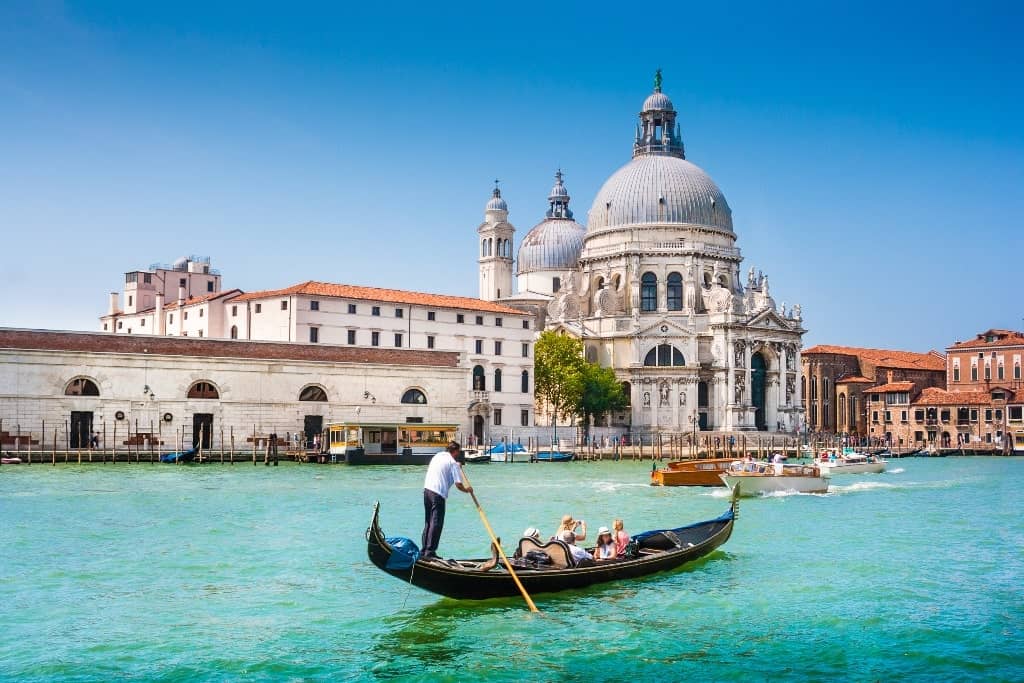
Wondering when is the best time to visit Venice? Venice is so special that every time of year is perfect for a trip! Every season has something different to offer, both in terms of weather and events.
Table of Contents
Best Time to Go to Venice in Brief
Best months to go in Venice for sightseeing: April, May, September, October Best months to visit Venice for some outdoor activities : April, May, June Best weather in Venice: April, May, September, October Best time to visit Venice for the events : February, August, September, December
Best Time to Visit Venice by Season
High season in Venice: summer. Though Venice can get really crowded and expensive between June and late August, there are no significant changes in comparison to the other seasons. The weather is generally hot and humid, so it’s not the best time to go sightseeing.
Low season in Venice: winter. Even if between November and March there are fewer visitors in town, there are two exceptions: February and December. Prices are not particularly lower except in late November and late January. The weather is generally cold and rainy.
Shoulder season in Venice : March, April, September, and October. These months are definitely the best ones to visit the city because of the overall lovely weather conditions. April tends to be crowded due to the Italian Easter holidays/Spring Break.
Let’s see why you shall visit Venice in every month!
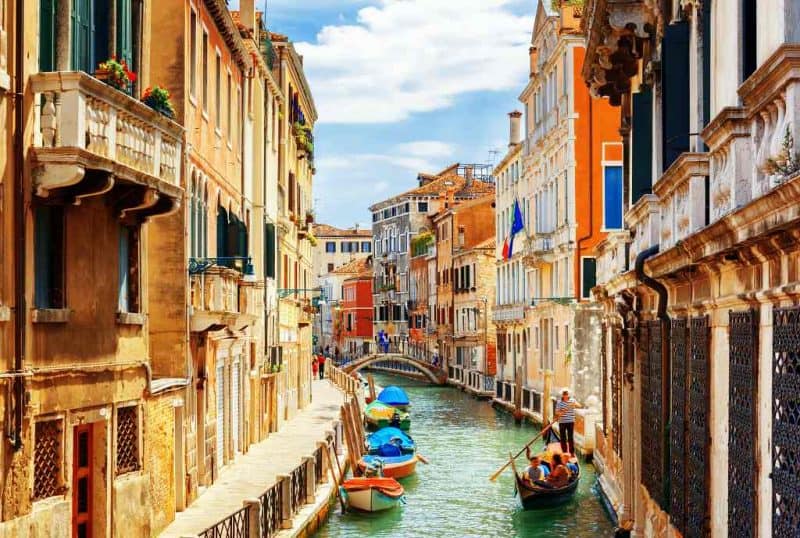
Best Time to Visit Venice by Month
Venice in january.
Max Temp: 7°C Min Temp: 0°C Rainy days: 10
January is the coldest month of the year in Venice and the perceived temperature can be considerably lower due to high humidity.
Events in Venice in January: Jan 6th: Epiphany. The main event is the so-called “Befana Boat Race”, where all the participants are dressed up like the famous Italian folk character.
What to do : visiting a museum is the best activity to escape the cold, but you can also simply lounge at a restaurant and taste all the typical dishes without rushing your meal. In January, you can also go ice-skating in Campo San Polo.
Why January : plan a weekend off in the second half of the month to benefit from lower fees and fewer tourists around.
Perfect time for: art lovers and foodies
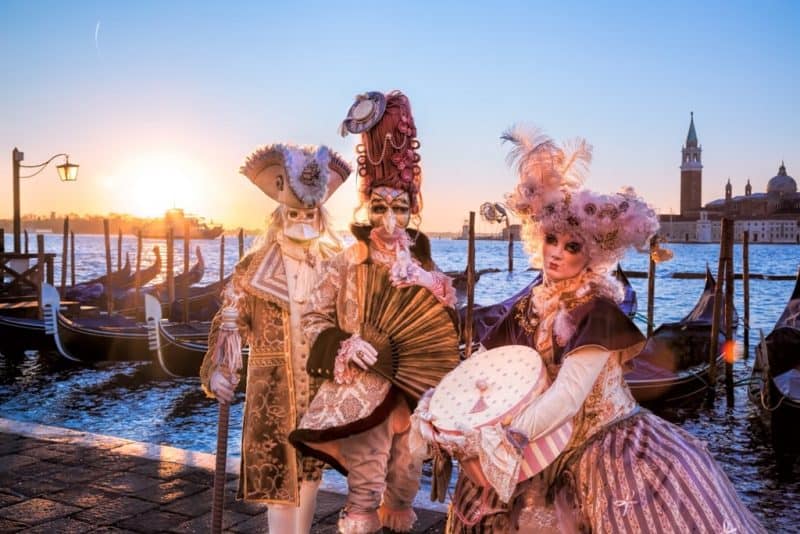
Venice in February
Max Temp: 9°C Min Temp: 1°C Rainy days: 11
It’s often quite cold and rainy, but weather gets better towards the end of the month.
Events in Venice in February:
Carnival: one of the main local events takes place in February, which is also one of the busiest months in Venice. Many tourists from all over Europe go there to attend local parties, parades or simply be immersed in local folklore.
St. Valentine’s Day: a weekend for two in Venice is something you shall experience once in a lifetime!
What to do: sightseeing can be quite tiring in February, since there are many people everywhere. For this reason, it’s best to book your visits in advance, either joining a guided tour or buying a skip-the-line ticket. Don’t miss a masked ball or a special Carnival event (check the list of the main events and their schedule here Carnival of Venice – parties and masquerades balls).
Why February : to experience the liveliest time of the year in Venice
Perfect time for: having fun
Venice in March
Max Temp: 13°C Min Temp: 8°C Rainy days: 11
Venice can be rainy all year long, but weather gets warmer and sunnier in March.
Events in Venice in March:
March 8th: Women’s Day. Local museums and art exhibitions are free for women.
What to do: you can plan one or more day trips to explore the areas nearby. Start with a tour of the islands and discover their traditions and landscapes.
Why March : to celebrate the arrival of spring
Perfect time for : a girls’ weekend
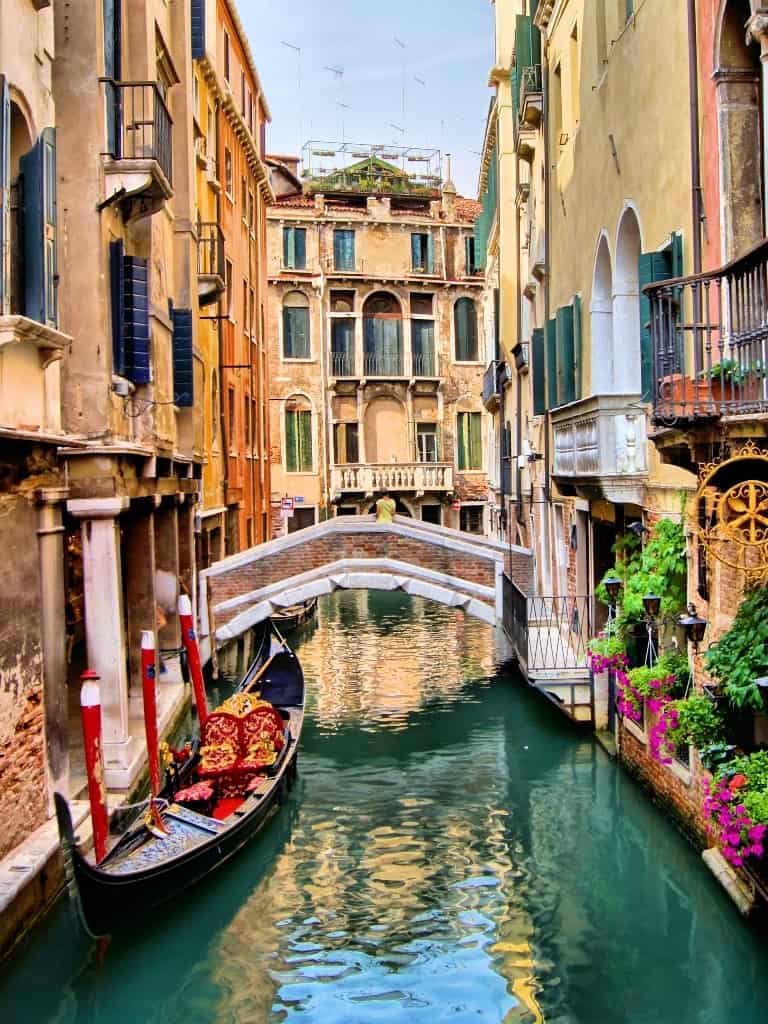
Venice in April
Max Temp: 17°C Min Temp: 12°C Rainy days: 12
Climate varies a lot in spring and you shall dress in layers and bring an umbrella with you to be ready for any kind of weather conditions.
Events in Venice in April:
Easter: a typical holiday period for Italians often choosing to spend a few days in a city of art like Venice. A typical local tradition is having a fish lunch and you can taste all the local specialties in a cozy restaurant overlooking Canal Grande.
April 25th: Italian Liberation Day and St. Mark’s Day, that is the patronal feast of Venice. On this day, men are used to offering a rose bud to their girlfriends and wives and the city center is full of rose vendors filling the air with spring scents.
What to do: April is one of the busiest months in Venice due to Italian Spring Break, so you shall plan your visits in advance and get your skip-the-line tickets whenever possible. It’s also a great time to take some beautiful pictures, thanks to the perfect spring light and the clear water of the canals. If you want to avoid large crowds, focus on less popular but equally interesting neighborhoods like the Jewish Ghetto or Castello district.
Why April : for a Spring Break in Italian style
Perfect time for : photographers/travel bloggers/influencers and visitors who like being surrounded by people
Venice in May
Max Temp: 21°C Min Temp: 15°C Rainy days: 12
Weather is generally warm and pleasant, but rainfalls are frequent.
Events in Venice in May:
May 1st: Labor Day. A typical weekend off for Italians who often choose Venice as a base.
What to do: on a bright and warm day, you shall definitely enjoy a boat tour, whether on the picturesque Canal Grande or in the Lagoon. In May, you can also spend some nights out thanks to local mild weather and a gondola ride in the evening could be a good idea to watch the city lights on the canals.
Why May : to spend your time outdoor and to enjoy some warm spring nights
Perfect time for : a boat or gondola ride
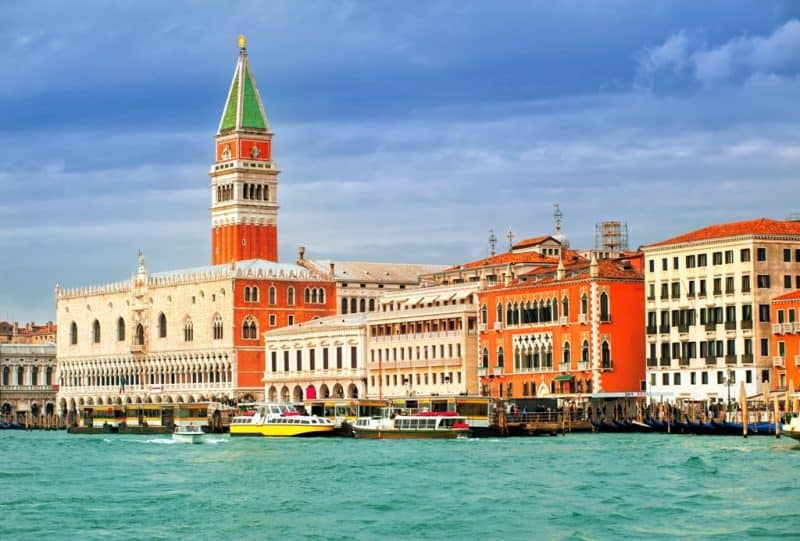
Venice in June
Max Temp: 25°C Min Temp: 20°C Rainy days: 10
Summer is generally hot and humid, but weather is still pleasant in June.
Events in Venice in June:
First Sunday of the month: Vogalonga boat race. It’s a 30Km regatta which is really spectacular to watch from the canals’ banks.
What to do: of course, summer is the ideal time for your day trips! You can also spend a day on the beach in Lido neighborhood, which is easily accessible by waterbus (it takes about 40 minutes from the city center).
Why June: despite being a sunny and warm month, there are not too many tourists around
Perfect for : combining sightseeing and relax on the beach
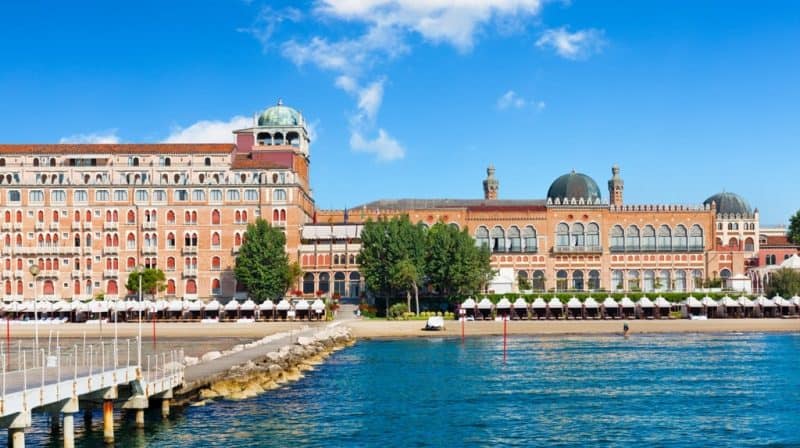
Venice in July
Max Temp: 27°C Min Temp: 20°C Rainy days: 10
Summer is often muggy because of high humidity.
Events in Venice in July:
Third Sunday of the month: Redentore Festival. It celebrates the end of the plague in 1577 and the highlight of this day is the firework display in the lagoon.
What to do: escape the heat inside a cool museum or take a dip in the sea. Enjoy a romantic gondola ride at sunset and join locals at a bacaro for an aperitivo based on Spritz and cicchetti (local tapas).
Why July : it’s not the best month to go sightseeing, but you could plan a beach holiday in a nice seaside resort and plan a day trip or a whole weekend in Venice.
Perfect for: people who are not bothered by high temperatures and humidity
Venice in August
Max Temp: 28°C Min Temp: 20°C Rainy Days: 10
Events in Venice in August:
August 15th: Ferragosto. This mid-summer celebration brings many tourists to Venice, even just for a weekend. There are also many entertainments offers and music festivals around that time.
Film Festival: one of the most eagerly awaited events takes place between the end of August and the beginning of September in Lido neighborhood.
What to do: August is another muggy month in Venice. Spend your time visiting some museums, relaxing on the beach and walking in nature visiting local beautiful gardens like the Biennale ones, where you’ll also find a few summer art exhibitions.
Why August: to attend the famous Film Festival and spot some celebrities
Perfect for: movie lovers
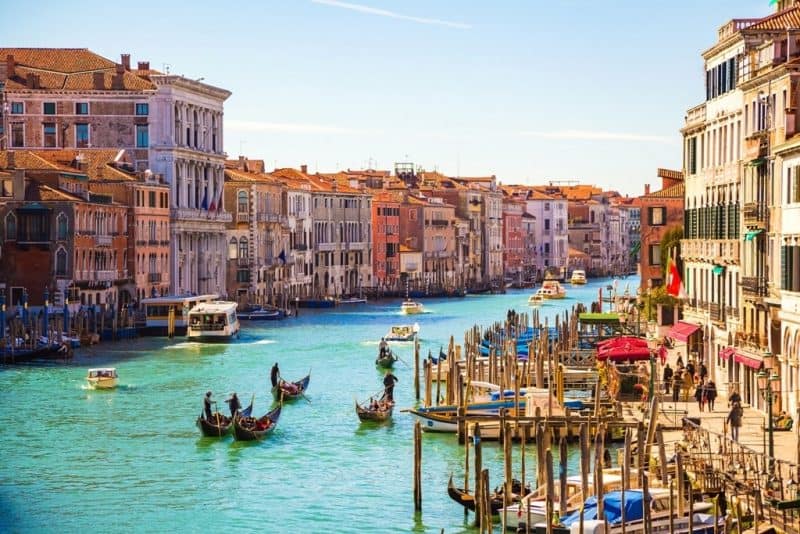
Venice in September
Max Temp: 25°C Min Temp: 18°C Rainy days: 9
Weather is at its best: warm, sunny and dry
Events in Venice in September:
Film Festival: it usually ends around Sept 6 th -10 th
Historical Regatta: on the first weekend of September, a water parade of costumed character crowds the Canal Grande
What to do: in the second half of the month, there are fewer tourists around and the city gets quieter, so it’s the perfect time to explore the calli at your own pace and to enjoy the beautiful monuments and the many churches of Venice.
Why September: lovely weather
Perfect for: movie lovers and people who like wandering around the streets and be immersed in the local atmosphere
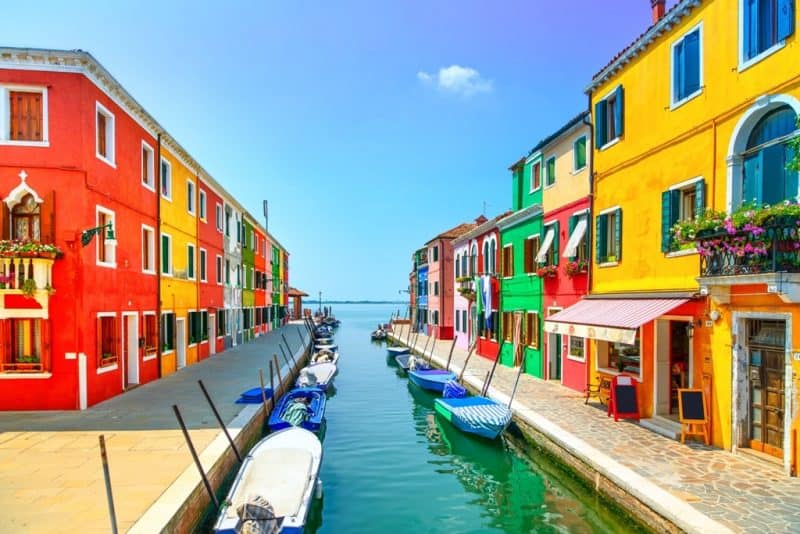
Venice in October
Max Temp: 18°C Min Temp: 13°C Rainy days: 10
Autumn is generally cool but there are still many sunny days in October. Towards the end of the month, the mist is quite common and you can already experience the typical phenomenon of Acqua Alta (partial floods due to high tide and winds).
Events in Venice in October:
October 31st: Halloween. You can find many themed tours in town: Venice: 2-Hour Legends and Ghosts of Cannaregio Tour.
What to do: October is one of the quietest months in Venice, so you can plan a thorough visit and spend several hours visiting all the monuments, churches, and museums at your own pace. The weather is generally good until the end of the month, so a walking tour can be a good idea too.
Why October : nice weather and no crowds
Perfect for: enjoying a thorough and quiet visit
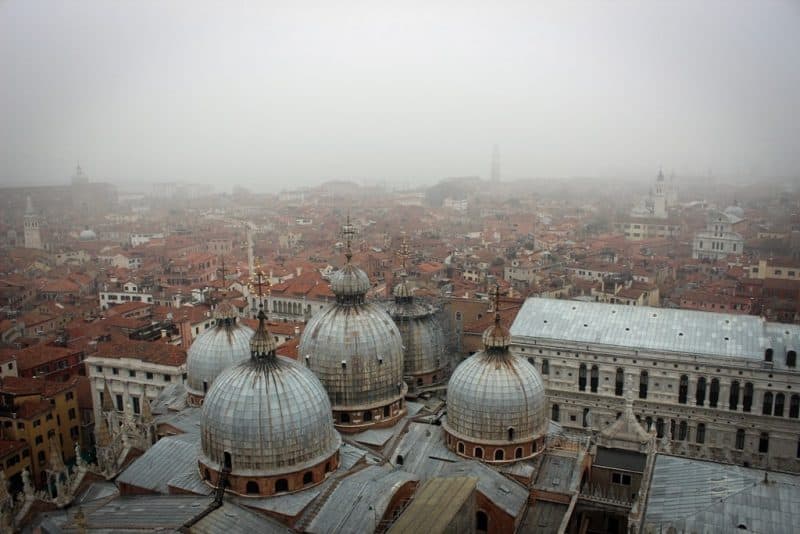
Venice in November
Max Temp: 13°C Min Temp: 8°C Rainy days: 13
Heavy rainfall is relatively common as well as fog and Acqua Alta.
Events in Venice in November:
November 1st: All Saints. Avoid the closest weekend to this celebration if you don’t like crowds.
November 21st: Feast of Madonna della Salute. It celebrates the end of the plague and locals are used to going to mass in the homonymous church reachable by a votive pontoon bridge.
What to do: keep your camera at end and take plenty of pictures of a foggy and mysterious evening, a reddish sunset or a flooded square. Bring rubber boots, umbrella and raincoat with you since Acqua Alta is common in November!
Why November: to experience the foggy and wet yet romantic Autumn in Venice
Perfect for: artists, poets, photographers and romantic people
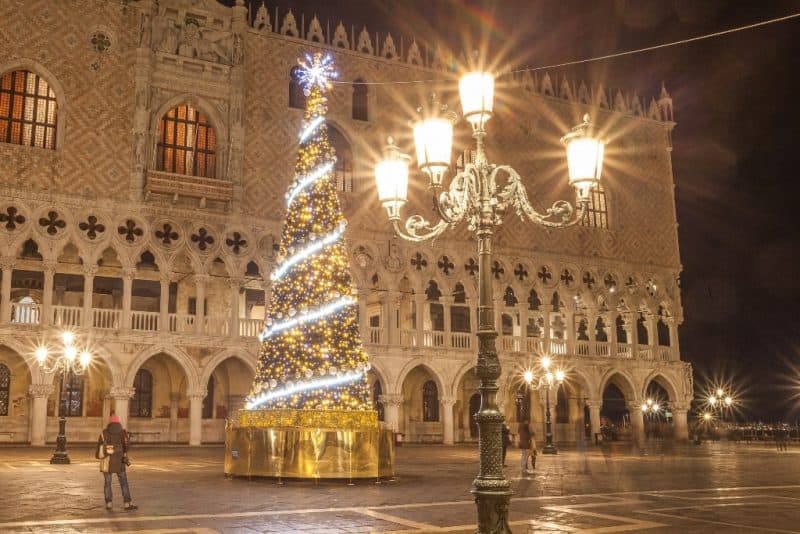
Venice in December
Max Temp: 10°C Min Temp: 6°C Rainy days: 11
Weather is generally cold and grey.
Events in Venice in December:
December 8th: Feast of the Immaculate Conception. It marks the official start of the Christmas season in Italy
December 25th: Christmas
December 31st: New Year’s Eve. If you can stand spending long hours out in the cold, there is a free concert in Piazza San Marco and some fireworks at midnight.
What to do: weather is not so good in December, but local Christmas magic is definitely worth the trip. December is one of the most expensive months (Venice is always expensive!) due to the high affluence of both national and international visitors. The main December activities in Venice are: going to La Fenice Theater to enjoy one of the best shows of the season, ice-skating in Campo San Polo, admiring the nativity scene in the Basilica of Santa Maria Gloriosa dei Frari, go shopping at the Christmas market in Campo Santo Stefano.
Why December: to experience local Christmas magic
Perfect for: people who are not bothered by cold and humid weather and high-budget travelers
Planning a trip to Venice? You might also like: How many days in Venice? How to spend 2 days in Venice Venice in winter Best day trips from Venice Interesting facts about Venice Venice or Rome?
Sharing is caring!
Leave a Comment Cancel reply
Save my name, email, and website in this browser for the next time I comment.
Best Time To Visit Venice
Top hotel collections.

Beach Hotels
5 Star Hotels
Cheap Hotels
What is the best time to visit Venice?
April, May, September and October are the best months to visit Venice, with temperatures ranging between 10°C to 25°C. These months mark the peak of Spring and Fall, respectively. They are devoid of the winter cold and experience plenty of warm sunshine. The pleasant weather and the lack of excessive crowds make these months a magical time to visit Venice to explore it in its raw state. The first half of May is also an excellent time to visit Venice.
June to August, in particular, are not advised for sightseeing. The sweltering heat and the presence of mosquitoes and bugs, combined with excessive tourists, make it impossible to experience Venice at its best. Alternatively, travellers who are keen to take part in any of Venice’s famous carnivals or events can plan their trips around the specific event. It is recommended to make your bookings in advance in such cases. If you’re looking for the lowest fares in flights as well as accommodation, then winter is your best bet.
Weather in Venice

Upcoming Venice Weather
Monthly weather in venice, venice travel packages.
Compare quotes from upto 3 travel agents for free
Europe Tour Packages Under 50000 - Venice, Milan and Rome
Luxury european holiday package in italy, france & switzerland, italian treasure tour package - boat tour around capri, soulmate special - 6 nights italy tour package, treasures of italy - 7 nights 8 days tour package, honeymoon paradise in italy, more about best time to travel to venice, venice in peak season, venice in shoulder season, venice in low season, venice in winter (december - february).
- Hanukkah is celebrated widely in the Ghetto - the Jewish region of Venice.
- Feast of the Immaculate Virgin takes place on 8th December.
- Christmas Markets pop up from mid-December onwards. Christmas Eve is usually celebrated with a multi-course fish dinner followed by a Midnight Mass at the Saint Mark’s Basilica.
- New Year’s Eve or Festa di San Silvestro is celebrated pompously throughout Venice. The festivities include parties, music, toasts and fireworks.
- La Befana or Epiphany is another national holiday. It is held on January 6th every year. It is celebrated with a regatta, known as La Regatta Delle Befane, in Venice.
- The Feast Day of Saint Anthony Abbott is held on 16th and 17th of January. This Italian holiday celebrates gravediggers, the patron saint of butchers, domestic animals and basket makers.
- State-mandated sales start in early January and last for about eight weeks. Watch out for some excellent bargains.
- Carnivale di Venezia is one of the most significant events in Venice. Though the Carnivale is celebrated throughout Italy, it is Venice that throws the biggest parties.
Venice in Spring (March-May)
- Easter Week occurs in March or April, depending on the calendar. It is a busy week for Venice as tourists start pouring in, owing to the long weekend. Restaurants and other businesses usually remain closed during this time.
- Festa di San Marco and the Liberation Day are celebrated on the 25th of April every year. It is the day when Italy was liberated towards the end of the Second World War.
- The Week of Culture or Settimana della Cultura usually takes place around mid-April. National museums and other tourist attractions offer free entry in order to promote the Italian culture.
- Festa Della Sensa is an ancient celebration that commemorates Venice’s relationship with the sea. The festivities include colourful boat parades and an elaborate procession at sea.
- Vogalonga is an exciting rowing race held during the weekend after Festa Della Sensa. About 3000 participants take part in the 32 km race to put forth a fantastic event.
Venice in Summer (June-July and August)
- Festa Della Repubblica or Republic Day is a national holiday in Italy. It takes place on June 2nd each year. Majority of the public places and businesses will remain closed on this day.
- La Biennale is a cultural arts event that takes place in alternate years. It starts in June and goes on till November. Long processions are held in Venice on this occasion.
- Palio of the Four Ancient Maritime Republics is a boat race that is held in Venice once in every four years.
- Arena di Campo San Polo is an open-air cinema that begins in late-July and goes on till the end of August. It is the largest screen in Venice and features blockbusters from the previous season. Most of the films are either in Italian or dubbed in Italian.
- Festa del Redentore or the Festival of the Redeemer is the biggest event in the month of July. It marks the end of the 1576 epidemic.
- La Biennale di Venezia or the Venice Biennial is regarded as one of the most prominent art extravaganzas in the world. It is held in alternate years in the month of August.
- The Venice Film Festival is an internationally-renowned and important annual event. It takes place in August each year.
- Ferragosto takes place on August 15th, which is also a religious holiday of Assumption. Since it marks the beginning of the summer holidays, locals usually head out of town.
- Several outdoor concerts and movies are held throughout the month of August.
Venice in Fall (September to November)
- Festival of the Triumph of the Cross is a holy day that takes place on September 14th. Processions take place at the church and grand school of San Giovanni Evangelista.
- Regata Storica di Venezia is Venice’s Historic Regatta. It is regarded as one of the most spectacular and important events of this city.
- The Venice Marathon is held on the fourth Sunday of October each year.
- Opera Season at La Fenice takes place towards mid-October. It is a perfect opportunity to see an opera at Venice’s popular opera house.
- Various events are hosted by local restaurants and pubs on the eve of Halloween. The festival is becoming increasingly popular in recent times.
- All Saints Day takes place on November 1st and is a public holiday. This day is dedicated to the deceased loved ones and locals visit the cemeteries in their memory.
- Festa di San Martino takes place on November 11th each year. Kids create a ruckus and indulge in a trick or treat sort of event.
- Festa Della Salute or the Festival of La Salute takes place on 21st November every year. It commemorates the plague that had decimated a majority of the city’s population.
Related Posts
Best Time to Visit Italy
Things To Do In Venice

St. Mark's Square

Grand Canal

St. Mark's Basilica

St. Mark’s Clock Tower

Doge's Palace

Bridge of sighs
Nearby Places

Venice Photos

+ 48 photos
Browse Package Collections
Venice package collections.
Venice Honeymoon Packages

Nearby Destinations for Packages
Browse hotel collections, by hotel type.
Resorts In Venice
Villas In Venice
Best Hotels In Venice
Best Luxury Hotels In Venice
Bed And Breakfast In Venice
Amazing boutique hotels in venice
Guest Houses In Venice
Best Hotels In Venice With Pool
Motels In Venice
Lodges In Venice
By Budget Category
Cheap Hotels In Venice
3 Star Hotels In Venice
By Star Category
5 Star Hotels In Venice
4 Star Hotels In Venice
With Specific Facilities
Hostels In Venice
Camping In Venice
Hotels In Venice City Centre
Venice Hotels Near Airport
Near Landmarks
Hotels Near Marco Polo Airport (VCE)
For Special Purposes
Best Beach Hotels in Venice
Similar Places

Get the best offers on Travel Packages
Compare package quotes from top travel agents
Compare upto 3 quotes for free
- India (+91)
*Final prices will be shared by our partner agents based on your requirements.
Log in to your account
Welcome to holidify.
Forget Password?
Share this page

Best time to visit Venice | A comprehensive guide
Things to do in Venice Venice Travel Guide Best Time To Visit Venice
Venice, the city of canals makes for a great travel destination year round. Whether you're planning to make it in time for the Venice Carnival or you're looking to steer clear of the acqua alta , this guide will give you an idea of the best time to visit Venice. You can also glance through what happens in Venice every month of the year and what makes Venice a year-round delight.
Quick Jumplinks to Navigate the Guide
- Best Time To visit Venice - Know Before You Plan Your Trip
Venice Through The Year
Best season to visit venice, weather in venice year round, a month-by-month guide to visiting venice.
- More Venice Guides
Know Before You Plan Your Trip to Venice
Best time for staying outdoors in venice.
If plenty of sun and a day by the beach is what you’re looking for, Venice offers you its best from March onwards till August. In these months, you will find several resorts and pools opening up for the holidaying crowd. You may also indulge in sailing or rowing, which is a popular activity in Venice during summers.
Best Time for Sightseeing & Museum Hopping
Art enthusiasts can head to Venice between August to November. The temperature during these months is pleasant, and one can also make the most of the iconic Venice Film Festival that is held during this time. Being the shoulder season, these months also witness relatively less crowd around the city.
Best Time for Honeymooners
Venice boasts of pleasant climate during the months of September and February. With the winter either settling in or making its way through the city, Venice witnesses partly cloudy and foggy climate that makes up for the ideal romantic destination. Honeymooners can also avoid the crowd during these months as they fall just before the high season in Venice.
Best Time for Budget Travellers
If you’re looking for an economic getaway, planning your trip around the months of November to January is an ideal option. Off-season in Venice sees lesser crowd and budgeted accommodation. Apart from this, there are also several holiday events lined up around the city that you simply shouldn’t miss!
Best Time for Shopaholics
Venice houses an annual sale during the months of November and December. It is also during these months that there are pop up markets around the city during Christmas. Shopaholics can make the most of their trip by having a go at some of the most ornamental Christmas markets in the city.
Tourist Seasons in Venice
High season.
June to August witnesses a very busy time for Venice. It is during this time of the year that you may find long queues, swarms of crowd and lack of accommodation in Venice. However, if you’re looking for a summer holiday with lots of sunshine by the beach, this season could provide in abundance.
Shoulder Season
Beginning from March to May and from September till November is shoulder season in Venice. This season relatively sees a lot less crowd than summer, but still has people visiting for the pleasant temperature and iconic festivals. While it does not promise cold, a thick jacket is advisable for the season as it gets nippy every now and then.
December to February in Venice marks a low season in the city. With the mercury dipping down to zero and days getting shorter, there are often very few activities available to enjoy. However, the holiday season does bring in the necessary fervour and you may spot arrays of Christmas markets in the city and before the New Year kicks in.
Visiting Venice in itself is one of the best experiences you will have in life. For most, it hardly matters what time of the year you visit Venice. However, if you want to know before you go, this is how the seasons in Venice look.

Venice in Spring
Venice welcomes Spring season at the beginning of March and it extends upto the end of May. The pleasant weather and the energetic ambiance is a welcome change after the gloominess of winter that often overstays up till February. It is also the time before summer kicks in, leaving enough time before the crowd finds its way to the city. Venice shows wonderful shades of the season with flowers blooming everywhere you go.

Venice in Summer
Cheerful sunshine and blue skies looking over the Venetian beaches — summer is quite a popular time to visit Venice and several tourists from around the world believe so. You may encounter large crowds and longer queues, so make sure you book on time. With long days and starry nights, Venetian summers also give way to interesting events taking place every now and then.

Venice in Autumn
If you’re looking for a nip in the air without having to face the music, Autumn is the best time for you to visit Venice. With winter settling in slowly and summer making its way out, there are a lot of open air activities that you could enjoy during this season. Venice also hosts a number of art festivals during this time that could be enjoyed by art-enthusiasts.

Venice in Winter
While the weather may seem challenging during winter, Venice is a sight for sore eyes with quaint pop-up markets and cutesy outdoor cafes prepping for Christmas. The temperature dips down to 0°C but the city retains its charm and lively ambiance during the season. The season also witnesses a relief from the crowd that is around for the summer or spring season in Venice.
The weather in Venice year round has been charted on the graph below. The Highs are depicted in red and the Lows in blue.
Follow our detailed guide to pick a month for your Venice exploits.
Venice In January
Average Temperature: 3°C to 6°C
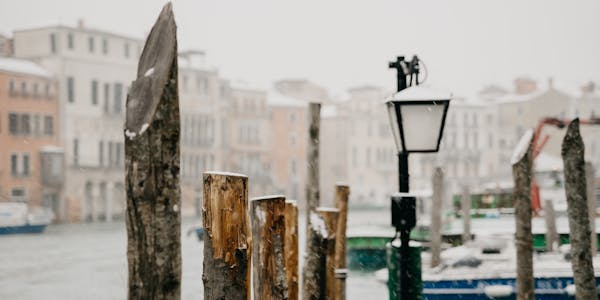
If you’re looking to spend some quiet time in Venice, January is an ideal time to get acquainted to the city. With the mercury dropping every now and then, the city offers you an ambiance that is straight out of a romantic movie. Days can be cloudy, accompanied with some Venetian fog, and there’s always chance of untimely rains. However, the weather is pleasant and does not get as chilly as it does in December. Pack enough layers, including gloves, scarves and a warm coat to make the most of the weather in January.
Related Read : 12 Utterly Romantic Things To Do In Venice
Venice In February
Average Temperature: 5°C to 6°C

Despite the retreating winter, February can be quite cold in Venice. While you don’t need to pack as heavy as you would in January, you still require to carry enough overalls to keep you warm during early mornings and late evenings. February, however, hosts the most-awaited Venice Carnival that is the right time to stop by for a gala time and indulge in public shows as well as other events lined up especially for it. February is the ideal time to visit if you’re planning to enjoy the Venetian winter without having to book tickets during holiday season!
Recommended Experiences in Venice during Winters
Venice in march.
Average Temperature: 8°C to 12°C

With the onset of Spring, Venice warms up and you can enjoy the newly bloomed flowers across the city. Expect a little more of rainfall than usual in this season, but apart from that there is plenty of sunshine with 12 hours of daylight on an average. Celebrations begin to pop up around this month and you may notice various events being held for Women’s Day on 8th of March and 19th March which is St. Joseph’s day (also celebrated as Father’s Day in Venice). With Easter break just around the corner, be prepared to encounter moderate crowd.
Venice In April
Average Temperature: 12°C to 16°C

With April comes pleasant weather and lots of sunshine in Venice. Light clothing and comfortable footwear goes a long way during this season. This is the best time to visit outdoor cafes and open-air events that happen around this time of the year. Along with Easter in Venice , other iconic festivals including the feast of St. Mark on the 25th of April bring in a lot of cheer and celebration on the St. Mark Square. Apart from this, Venice also celebrates Liberation Day on the same day, commemorating Italy’s liberation during the World War II.
Venice In May
Average Temperature: 15°C to 21°C
May marks the beginning of the peak season in Venice, which means you may encounter larger crowds, more queues and accommodation issues. However, this will also mean a cheerful atmosphere and sunshine that will brighten up the city unlike any other weather. You can expect warm days but don’t be surprised to see the temperature dipping by the end of the day. This season will also witness several water sports taking place, as Festa della Sensa, commemorating Venice's marriage to the sea, takes place on the first Sunday after Ascension Day. It is also followed by Vogalonga, a rowing race, something that tourists as well as locals believe in participating.
Recommended Experiences in Venice during Spring
Venice in june.
Average Temperature: 16°C to 24°C

With the peak season along with summer, both on a full-swing, Venice is hot and sunny during June. There is still a chance of rain and some afternoon thunderstorms which drop in unannounced during summer season here. Pack light along with your beachwear, which is recommended if you want to catch some tan during the longest day in Venice, June 20. During odd numbered years, Venice hosts its Art Biennale, that runs from June to November. You may also catch up on its various previews and pre-events, apart from Art Night Venezia.
Venice In July
Average Temperature: 18°C to 28°C
July is not only the hottest month in Venice, but is also the peak of its tourist season. The temperature rising can This is perhaps the best season to pack your bathing suits and sandals to cool off at the beaches. It is advisable to pack a sunscreen with high SPF to avoid a possible sunstroke. Venice celebrates its biggest festival — Festa del Redentore — commemorating the end of plague in the city during 1587. The spectacle attracts many from around Europe and the world and is celebrated widely across Venice with pomp and fervour.
Related Read : 10 Museums In Venice You Ought To Visit Now!
Venice In August
Average Temperature: 18°C to 27°C
August in Venice can still be hot, however, night time can turn pleasant as compared to June or July. There is above average rainfall during this month and also a chance of thunderstorm. It is recommended to pack according to the changing weather and keep a raincoat at hand. August in Venice is a great time to go rowing or sailing, which could provide a respite from the heat in this season. Ferragosto, a traditional Italian holiday, takes place in August along with the preparations of the famous Venice Film Festival. You may also find a lot of interesting outdoor concerts and movie screenings taking place in this month.
Recommended Experiences in Venice during Summer
Venice in september.
Average Temperature: 15°C to 24°C
September witnesses a decline in the temperatures in Venice, however it does not require you to pack heavy just yet. Carrying a sweater for the evenings can do the needful as temperatures tend to dip moderately during the night time. While rain isn’t significant in this month, expect light drizzling every now and then which could cause the temperature to cool. With the Venice Film Festival taking place, September is also a lively time to visit the city. Experience a fun-filled, traditional gondola race at the Historical Regatta, which also takes place at the start of the month.
Venice In October
Average Temperature: 14°C to 16°C

It gets noticeably cooler in Venice during October, and you may also find a little less crowd than usual as the peak season dissipates. You may require a thicker jacket during this weather as the temperature gets nippy with the daylight constantly decreasing. Opera season kicks in at La Fenice in October which is ideal for those who are enthusiastic about the art. With Halloween around the corner, several lively parties and haunts come alive in October with a much younger crowd. Expect to find some fun events lined up for the festival across the city if you’re in town.
Recommended Experiences in Venice during Autumn
Venice in november.
Average Temperature: 4°C to 11°C
There is a dramatic drop in the temperature that marks the onset of winters in Venice. November can also get rainier, with rainfalls occurring every now and then. The temperature can drop more as the month progresses, so be sure to pack wisely. November starts off with an All Saints Day in Venice, which is a public holiday for the city. The Festa della Salute held on the 21st of November is yet another festival that commemorates the end of plague in 1631. November is a great time to sip hot chocolate in an outdoor cafe before the winter kicks in in December.
Venice In December
Average Temperature: 0°C to 7°C
December is the coldest month in Venice, and is also the beginning of holiday season in the city. Packing your cold gears, heavy jackets, hats and gloves is advisable if you plan to visit Venice during this season. With Christmas and Hanukkah around the corner, you may encounter several pop-up Christmas markets in the city. Closer to the New Year’s Eve, Venice will also have lively events taking place leading up to December 31st. The finale on New Year’s Eve features a firework show on Piazza San Marco and ends with couples kissing on midnight.
What is the best time of year to visit Venice?
The best time of year to visit Venice is from April to June or September to October when the weather is mild and the crowds are smaller.
How many days should I plan to spend in Venice?
You should plan to spend at least 3 days in Venice to see the major sights and attractions. You can take a look at a curated Venice 3 Day Itineray
What are the must-see attractions in Venice?
The must-see attractions in Venice include the Grand Canal, St. Mark’s Basilica, Doge’s Palace, and the Rialto Bridge.
Can I take a gondola ride in Venice?
Yes, you can take a gondola ride in Venice! Gondola rides are a popular tourist activity and are a great way to see the city from the water.
What is there to do at night in Venice?
There are plenty of things to do at night in Venice! You can explore the city’s many bars and restaurants, take a moonlit gondola ride, or enjoy some live music.
What is the food like in Venice?
The food in Venice is typically Italian, with plenty of pasta, seafood, and pizza options. There are also many great restaurants to choose from.
What should I pack for my trip to Venice?
When packing for your trip to Venice, be sure to pack comfortable shoes as you will do a lot of walking. You should also pack a light jacket or sweater as the weather can be cool in the evenings.
When should you avoid Venice?
You should avoid visiting Venice during the peak tourist season from July to August when the city is crowded and prices are higher. You should also avoid visiting Venice during the winter months from November to March when the weather is colder and there are fewer things to do.
Ready to visit Venice?
Check out the top things to do in Venice and our comprehensive Venice Travel Guide to plan your vacation like a pro!
Lakshmi Menon
Born to parents bit by the wander bug, Lakshmi calls her love for travel "hereditary and habitual". Perpetually ensconced with a book in her hand and a mug of coffee in the other, she has been to over 15 countries in her 23 years of existence and is currently saving miles and money for her solo trip to Iceland. Always hustling towards the least trodden path, she has encountered some wonderful people during her escapades and if you ever meet her, she won't stop gushing about them.
Be a smart traveler
The first to know about trending destinations, travel deals, tips and all things travel.

- Meet the Team
- Work With Us
- Itineraries
- Italy Travel Guide
- Hawaii Travel Guide
- Travel Tips
Travel Information
When is the best time to visit venice, italy.
Planning a trip to Venice, Italy ? One of the most important things to consider is the timing of your visit. Venice is a beautiful city with a rich history and culture, but it can get extremely crowded and very expensive during peak tourist season, which feels almost like it’s year-round these days.
To make the most of your trip, it’s important to know when is the best time to visit Venice . Your number one priority should always be avoiding crowds, no matter what your main reason is for visiting the city. This is because over-tourism is a major problem there and as responsible travelers, we all have an obligation to lessen the burden (or not go at all!). I’m assuming that last bit isn’t going to happen.

» Here is our 2-week Italy itinerary to help you plan your trip around Italy’s top cities . We also have a travel guide for Venice , a 3-day Rome itinerary , things to see in Florence , foodie things to do in Bologna , and a guide to the top landmarks in Italy . Learn about renting a car in Italy . Be sure to check out our 2-week Europe Itinerary .
If you want to avoid crowds and enjoy cooler weather, consider visiting in the fall or winter. From October to November, tourists start to leave the city, and you can enjoy the beautiful sights and sounds of Venice without feeling overwhelmed. If you prefer warmer weather and longer days, plan your trip for the spring months, March to April, though be prepared for larger crowds and higher prices.
I would say to avoid the summer altogether. It can get amazingly hot in Venice and there’s generally not good air conditioning. Winter can get fairly cold, but if you don’t mind that and the fact that some things are closed in winter, it’s the best time to avoid crowds (except between Christmas and New Year).
Table of Contents
Understanding Venice’s Seasons

Venice is a city that is beautiful year-round, but the best time to visit depends on your preferences and interests. Understanding the seasons in Venice can help you plan your trip accordingly.
Spring in Venice
Spring in Venice, from March to May, is characterized by beautiful sunny days and temperatures that may be warm. You can also experience some temperatures dropping, rainy and windy days. But that’s all part of spring weather. The average temperatures range from 54°F to 68°F (12°C to 20°C). You’ll find fewer crowds during this season, making it an ideal time to explore the city’s attractions.
Summer in Venice
Summer, from June to September, is the hottest time of the year. The average temperature is around 84°F (29°C), though it can get as high as 100°F (38°C), and humidity is high. You can expect sunny days with occasional thunderstorms. The city is bustling with tourists during this season, so be prepared for crowds. If you don’t mind the heat and crowds, summer is a great time to enjoy the beaches and outdoor activities.
See our Europe summer packing list to know what to bring on your trip.
Fall in Venice
Fall, from October to November, is a great time to visit Venice. The temperatures are pleasant, and there are fewer crowds. The average temperatures range from 50° F to 68°F (10°C to 20°C). You can also experience some rainfall during this season, but it’s not as frequent as in the spring. You can enjoy the beautiful colors of the leaves changing in the parks and gardens.
Winter in Venice
Winter, from December to February, is the coldest time of the year. The average temperature is around 40°F (4°C), and it can get below freezing at night. You can expect some foggy days during this season. The city is less crowded during this season, and you can enjoy the beautiful Christmas decorations and markets.

Venice’s Tourist Seasons
Venice is one of the most popular tourist destinations in Italy , and as such, it has its own tourist season. Knowing when to visit Venice can help you avoid crowds, save money, and have a more enjoyable experience. Here are the two main tourist seasons in Venice:
Peak Tourist Season
The peak tourist season in Venice runs from April to October, with July and August being the busiest months. During this time, the weather is warm and sunny, and the city is bustling with tourists from all over the world. If you visit Venice during the peak season, you can expect long lines, crowded streets, and high prices for hotels and restaurants.
Off-Season in Venice
The off-season in Venice runs from November to March. During this time, the weather is cooler , and there are fewer tourists in the city. If you visit Venice during the off-season, you can expect to find lower hotel rates, shorter lines, and a more relaxed atmosphere. However, you should be prepared for colder weather, especially in December and January.
Many tourists desert the city during the off-season, so you can have the city to yourself. If you want to experience the famous Carnival of Venice , which takes place in February, you should plan to visit during the off-season. The carnival is one of the most popular events in Venice, and it attracts thousands of tourists every year.
Venice’s Key Events and Festivals
If you’re planning to visit Venice, Italy, you might want to consider attending one of its key events and festivals. These events offer a glimpse into the city’s rich cultural heritage and traditions. Here are some of the most popular festivals to look out for:
Carnival of Venice

The Carnival of Venice is one of the most famous festivals in the world, attracting thousands of visitors every year. It usually takes place in February, just before the start of Lent. During the carnival, people dress up in elaborate costumes and masks and parade through the streets of Venice. There are also plenty of events, such as concerts, parties, and masquerade balls, taking place throughout the city.
Festa del Redentore

The Festa del Redentore is a religious festival that takes place on the third Sunday of July. It commemorates the end of the plague that ravaged Venice in 1576. During the festival, a temporary bridge is built across the Giudecca Canal, and people cross it to reach the Church of the Redeemer. There are also fireworks displays and boat races taking place throughout the weekend.
Historical Regatta
The Historical Regatta is a boat race that takes place on the first Sunday of September. It is one of the oldest and most prestigious events in Venice, dating back to the 13th century. During the regatta, boats of all shapes and sizes, each with its own team of rowers, compete against each other. There are also plenty of other events taking place throughout the day, including a parade of historical boats and a fireworks display.
Festa della Madonna della Salute
The Festa della Madonna della Salute is a religious festival that takes place on November 21st. It commemorates the end of the plague that ravaged Venice in 1630. During the festival, people walk across a temporary bridge to reach the Church of the Madonna della Salute. There are also plenty of other events taking place throughout the day, including a boat procession and a fireworks display.
Climate and Weather Conditions
When planning a visit to Venice, it is important to consider the climate and weather conditions to ensure a comfortable and enjoyable trip. Venice has a subtropical climate with cold winters, warm springs, brisk falls, and hot, steamy summers. The atmosphere is always humid, given that the city is built on a shallow lagoon.
Rain in Venice
Venice experiences high levels of rainfall throughout the year, with November being the wettest month. Visitors should be prepared for rain during their trip, especially during the fall and winter months. It is recommended to bring rain boots and an umbrella to stay dry. Additionally, high water (acqua alta) can occur during periods of heavy rain, causing flooding in the city.

Hot Weather
Summers in Venice can be hot and humid, with temperatures ranging from the mid-70s to the upper 80s Fahrenheit. July is typically the hottest month with high humidity levels. Visitors should dress comfortably and bring sunscreen to protect themselves from the sun.
Cold Weather
Winters in Venice can be cold and damp, with temperatures ranging from the upper 30s to mid-50s Fahrenheit. January and February are the coldest months, with occasional light frosts and fog. Visitors should bring warm clothing and dress in layers to stay comfortable. When the bora wind blows, the air feels colder than it actually is because of the wind chill.
Accommodations in Venice
When planning your trip to Venice, finding the right accommodations is key to a comfortable and enjoyable stay. There are many options available, ranging from budget-friendly hostels to luxurious hotels.
Peak Season Hotel Rates

If you plan to visit Venice during the peak season, which runs from April to October, you can expect to pay higher hotel rates. During this time, the city is bustling with tourists and hotel rooms can be in high demand. It is recommended to book your accommodations well in advance to secure the best rates and availability.
Luxury hotels in Venice can cost upwards of €500 per night during peak season, while mid-range hotels can cost around €200-300 per night. Budget-friendly options such as hostels and guesthouses can be found for as low as €30-50 per night.
Off-Season Hotel Rates
If you are looking to save money on accommodations, consider visiting Venice during the off-season, which runs from November to March. During this time, hotel rates are generally lower and there are fewer crowds.
Luxury hotels in Venice can cost around €200-300 per night during the off-season, while mid-range hotels can cost around €100-200 per night. Budget-friendly options such as hostels and guesthouses can be found for as low as €20-30 per night.
Preparation Tips for Venice
When planning a trip to Venice, there are several things to consider to make the most of your visit. Here are some preparation tips to help you have an enjoyable experience:
Choose the Right Time to Visit
The best time to visit Venice is during the winter months between November and February when tourist numbers are low, and the city is less crowded. The temperatures can be chilly, but you can stay warm by wearing layers and comfortable boots. If you prefer a warmer climate, the best time to visit is between April and June or September and October when the weather is temperate.
Plan Your Itinerary
Venice has many attractions, and it’s essential to plan your itinerary in advance to avoid missing out on the must-see sights. Some of the top attractions include St. Mark’s Square, the Doge’s Palace , the Rialto Bridge, and the Grand Canal. If you’re interested in contemporary art, visit the Peggy Guggenheim Collection , and if you love music, attend a concert at the famous La Fenice Opera House .
Consider a Day Trip to the Lagoon Islands

If you have extra time in Venice, consider taking a day trip to the nearby lagoon islands of Murano, Burano, and Torcello. Murano is known for its glassmaking, Burano for its colorful houses and lace-making, and Torcello for its ancient cathedral.
Be Aware of the Opening Hours
Most of the museums and attractions in Venice close on Mondays, so plan your itinerary accordingly. Also, keep in mind that some attractions have different opening hours during the winter months.
Save Your Energy
Venice is a city of canals, and you’ll be doing a lot of walking. To save energy, wear comfortable shoes and avoid carrying heavy bags. You can also take a vaporetto (waterbus) to get around the city.
Dress Appropriately
Venice is a city of fashion, and you’ll want to dress appropriately. Avoid wearing shorts and flip-flops, and instead, opt for smart casual attire. If you’re planning to visit religious sites such as St. Mark’s Basilica, dress modestly and cover your shoulders and knees.
Frequently Asked Questions
What is the best time to visit venice to avoid flooding.
Venice is known for its high water or “acqua alta” that can flood the city, especially during the winter months. The best time to avoid flooding is during the summer months, from June to August when the tides are lower. However, keep in mind that these months are also the busiest and most expensive times to visit Venice.
How many days do I need to visit Venice?
To fully experience Venice, it is recommended to spend at least 2-3 days in the city. This will give you enough time to explore the famous landmarks such as St. Mark’s Basilica and the Doge’s Palace, take a gondola ride through the canals, and wander through the charming streets and bridges of Venice. However, if you have more time, you can also explore the nearby islands of Murano, Burano, and Torcello.
What is the most crowded month in Venice?
The most crowded month in Venice is August, when many Europeans are on vacation and the weather is warm and sunny. This is also the time when many festivals take place, such as the famous Venice Film Festival. If you want to avoid the crowds, it is best to visit Venice during the shoulder season, from April to May or September to October, when the weather is still pleasant but the crowds are smaller.
Be Prepared For Travel Planning is the most important part of any successful trip. Do it the easy way:
🧳 Travel Packing List | ✔️ Why You Need Travel Insurance | ✈️ What to Do Before You Leave Home
- Find and book the best hotel (our favorite booking site is Expedia)
- Research flight options (our favorite tool is Skyscanner )
- Book a tour (we always use Viator to find the best tours)
- Rent a car through Discover Cars (they search the best deals for you!)
YOU MIGHT ALSO LIKE

9 Things to Know When Traveling to Italy

20 Famous Landmarks in Italy You Must See

19 Best Coastal Towns in Italy to Visit for a Beach Vacation

Top 20 Things to Do in Naples, Italy: Must-See Attractions
Like this post? Why not save it to Pinterest? FOLLOW US on Pinterest , Instagram , Facebook for more great travel inspiration and tips.

Laura Lynch, creator and writer of Savored Journeys, is an avid world traveler, certified wine expert, and international food specialist. She has written about travel and food for over 20 years and has visited over 75 countries. Her work has been published in numerous guidebooks, websites, and magazines.
Leave a Reply Cancel reply
Your email address will not be published. Required fields are marked *
Save my name, email, and website in this browser for the next time I comment.
- Travel Resources

40+ Venice Travel Tips for First Timers & Must Knows Before You Go
*FYI - this post may contain affiliate links, which means we earn a commission at no extra cost to you if you purchase from them. Also, as an Amazon Associate I earn from qualifying purchases. Check out our Privacy Policy and Disclosure. for more info.
The iconic city of Venice, Italy is one of those few destinations that requires no introduction. Famed the world over for its dreamy gondola-filled canals, this historic city (built over 100 islands) is the stuff of pure bucket list dreams, with a legion of obsessed fans all over the world.
And I get the obsession. Venice and I go way back. It’s the first city I ever visited in Europe, the first city where I ever missed a flight, and coincidentally where my boyfriend formally asked me to be his girlfriend… on Valentine’s Day, no less!
So believe me when I say I take it personally when people call Venice overrated.
I mean… can it be crowded and smelly in the summer? Yes. Can some restaurants and shops be wildly overpriced? Absolutely… but it’s still one of the most magical places in the world, so long as you do it right.
And after many repeat visits over the past decade, I think I’ve gotten a grasp on how to do Venice properly.
So, in this post, I’ll be sharing all my best Venice travel tips for first time visitors to help ensure you love this city as much as I’ve grown to. (Boyfriends sold separately)
Read on for my top Venice must-knows before you go.

Save this list of Venice Travel Tips for Later!
You’ll be very glad you did.
1. Venice in Italian is Venezia
First off, let’s get one thing straight: the glorious city known to us as Venice is actually known in Italian as Venezia.
This is the name you’ll see at train stations, bus stations, and scrawled across a staggering amount of souvenir shop hats.
SO, remember: Venice is Venezia, and they are not in fact two different places (a blunder that’s more common than you think!)

2. Learn some basic Italian before you go
On a similar note, I do think it’s important to learn some basic Italian before you go.
Venice gets its fair share of rude tourists so locals often appreciate when you make the effort and knowing some basics can go a long way, like…
- Hello (in the morning/afternoon): Buongiorno (Bwon-JOOR-no)
- Hello (in the evening): Buonasera (Bwon-ah-SAY-ruh)
- Thank you: Grazie (GRAHT-see-eh)
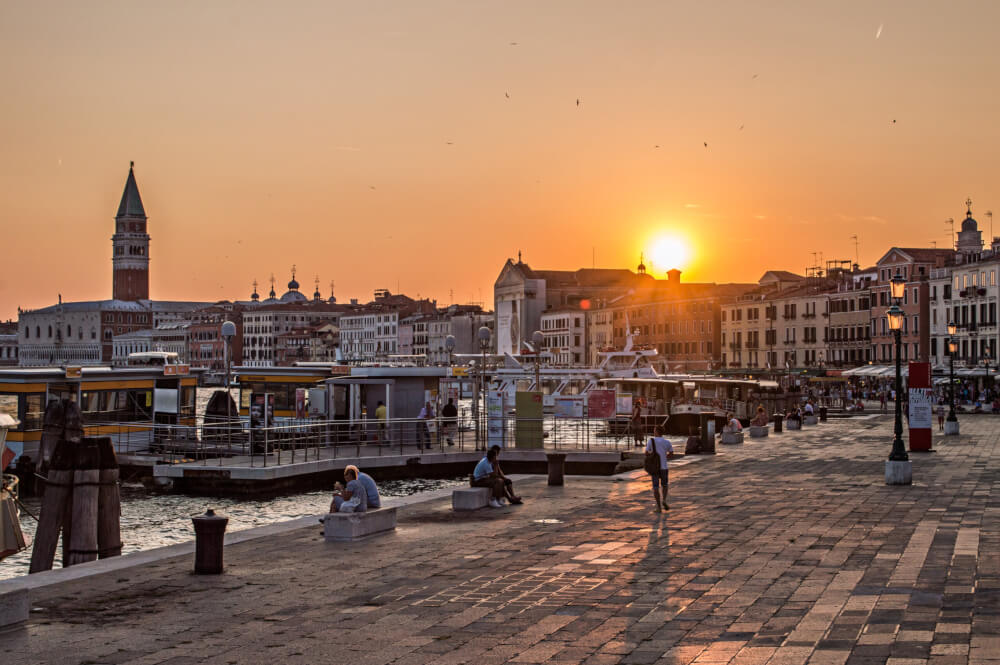
3. Stay overnight in Venice rather than do a day trip
Because of how pricey accommodation can be, many people opt to visit Venice as a day trip. 4 in 5 visitors in fact, according to some sources .
And if you’re considering that as an option, please picture me with a pouty face, stomping around and insisting you don’t.
Truthfully, 2-3 nights minimum is needed to get a feel for all that Venice has to offer, plus (even more crucially) staying in Venice overnight allows you to soak in the sights both early in the morning and late at night when crowds are at their lowest. In a city as busy as Venice, this bonus is invaluable!
Plus as of spring 2024, Venice will begin a trial of their controversial €5 entry fee for day trippers. So, save your money and your sanity – stay overnight! I promise it’s worth every penny.

4. Avoid visiting Venice during peak periods
Now, In terms of when to visit, the bad news is Venice doesn’t really have much of a quiet season at all.
That said, there are definitely aggressive peak seasons that I’d advise you avoid – namely summer, Easter & Carnival… unless your idea of a good time is waddling through narrow streets with a mosh pit of tourist-strangers .
Winter (outside of Carnival) is generally when you’ll find the least crowds in Venice.
Unfortunately though, this season brings more potential for rain, gloom, and floods, so to be safe, Spring and Fall are probably better times to go.
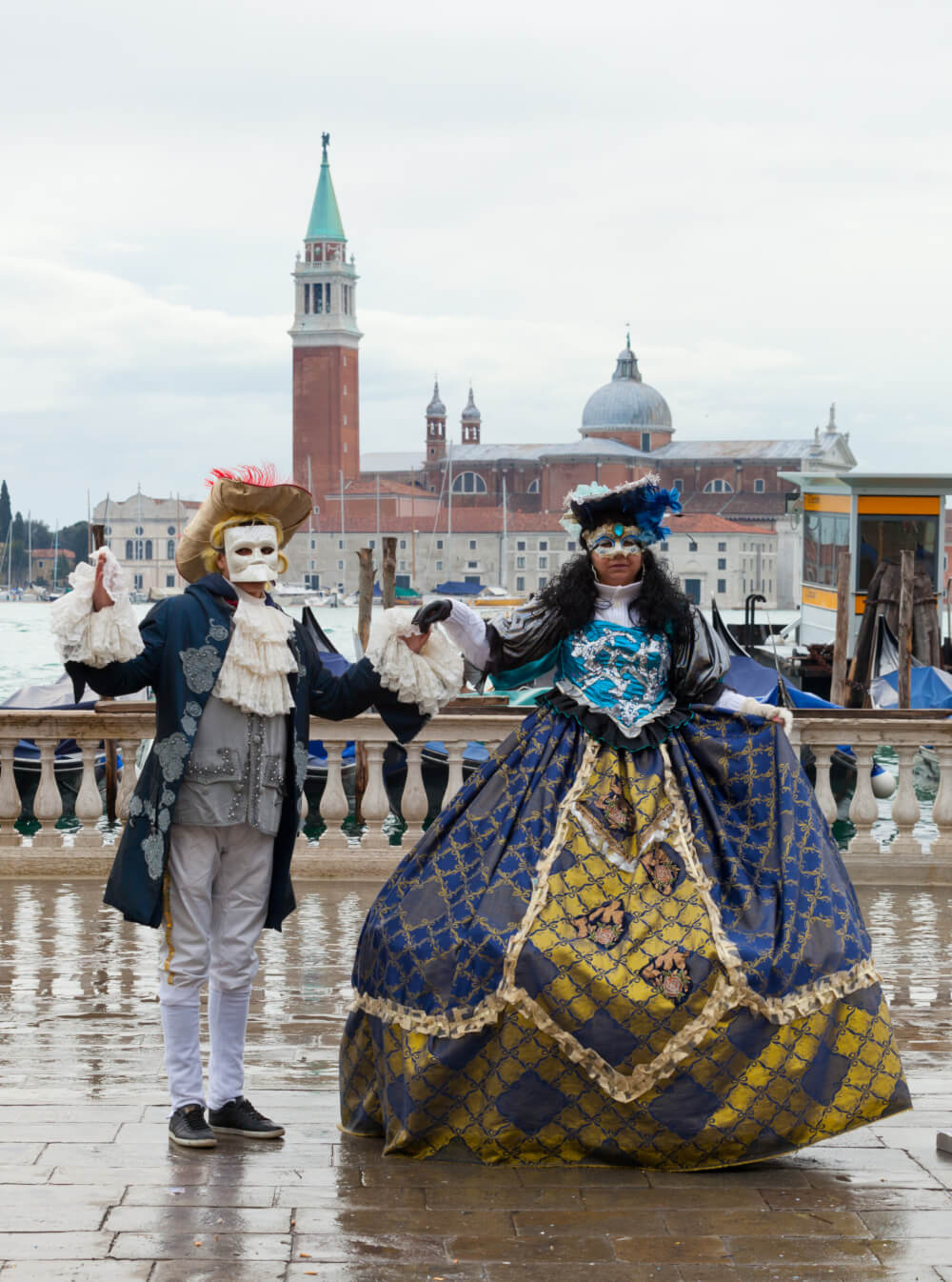
5. There are two airports close to Venice you can fly into
In terms of arriving in Venice, there is of course the Venice Marco Polo Airport which less than 5 miles away from the city centre, but there’s also the much smaller Treviso Airport which is about 25 miles away, and services budget airlines like Ryanair and Wizz Air.
For that reason, you can often find cheap flights that fly into this airport from other European countries, so it may be worth looking into if you’re visiting multiple countries on your trip.
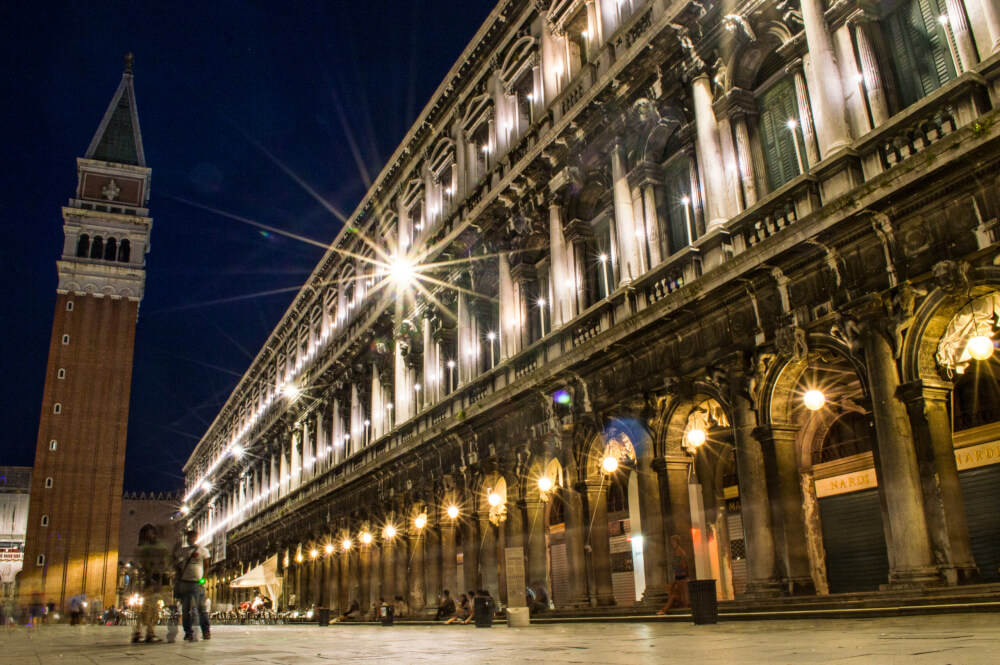
6. Know that there’s many options for getting to Venice from Marco Polo Airport
From Marco Polo Airport, the quickest way to get into central Venice is booking a private water taxi, which comes at a hefty price tag starting at 120 euro minimum. For larger groups though, this might be worth it, especially because it only takes 30 minutes to get into the historic centre.
NOTE: If you want the airport water taxi experience for a cheaper price, you can also book individual slots here on a water taxi that you’ll then share with others.
Another much cheaper but slower option is to take the Alilaguna water bus, or vaporetto which has three potential routes that go to central Venice for only 15 euro… but takes over an hour.
And the final option is to take either a bus or a taxi which is slightly cheaper. It’s important to note though that the closest you can get to the historic centre on wheels is Piazzale Roma , and from there you’ll either need to finish the journey on foot or hop on a water bus or taxi anyway, so it’s probably not the best option unless you’re staying super close to there.
In any case, I would ask your accommodation the best way to get there and they’ll be able to advise.
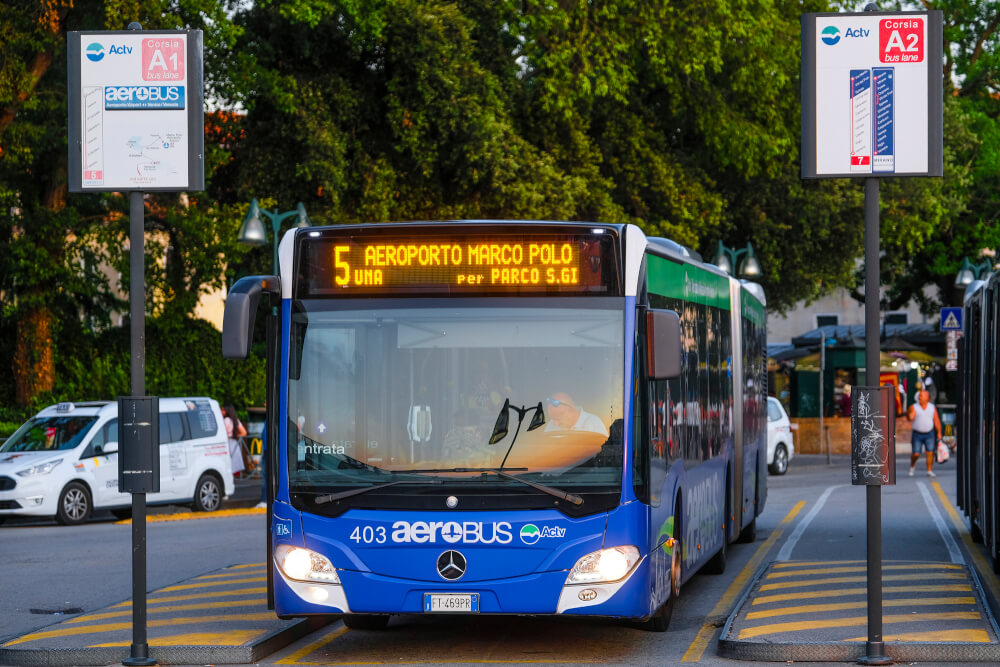
7. Know there’s many options for getting to Venice from Treviso Airport
From Treviso Airport, while there are some buses and shuttles you can book, again the closest you can get to the historic centre will be Piazzale Roma. So, bear in mind you’ll need a plan to get from there to your accommodation!
In any case, if you don’t mind transferring, the cheapest option from Treviso is actually a combination of a bus and then train into Venice.
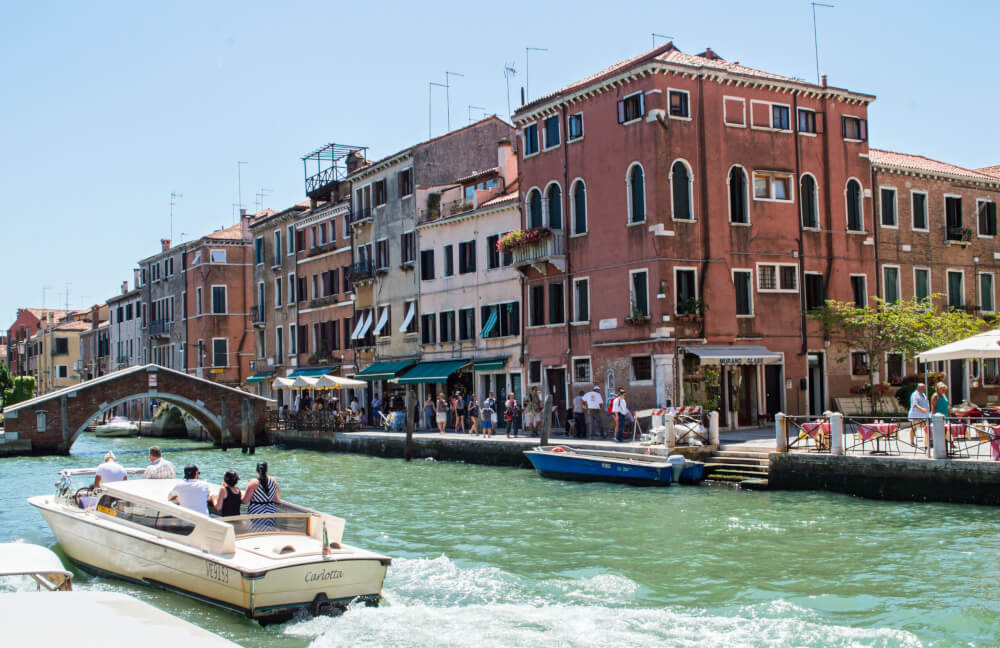
8. Beware of the two ‘Venezia’ train stations
On that note, apart from flying, an easy way to arrive in Venice is by taking the train. Venice is superbly well connected to the rest of Bella Italia through the Italian rail network which has an impressive 2000+ stations to choose from.
If you do take the train though, beware of a common tourist mistake that many first time visitors fall into: there are actually two stations that begin with Venezia – Venezia Santa Lucia and Venezia Mestre.
Venezia Santa Lucia is the central train station in Venice’s historic centre, right by the Grand Canal. In most cases, this is the one you’ll want to go to.
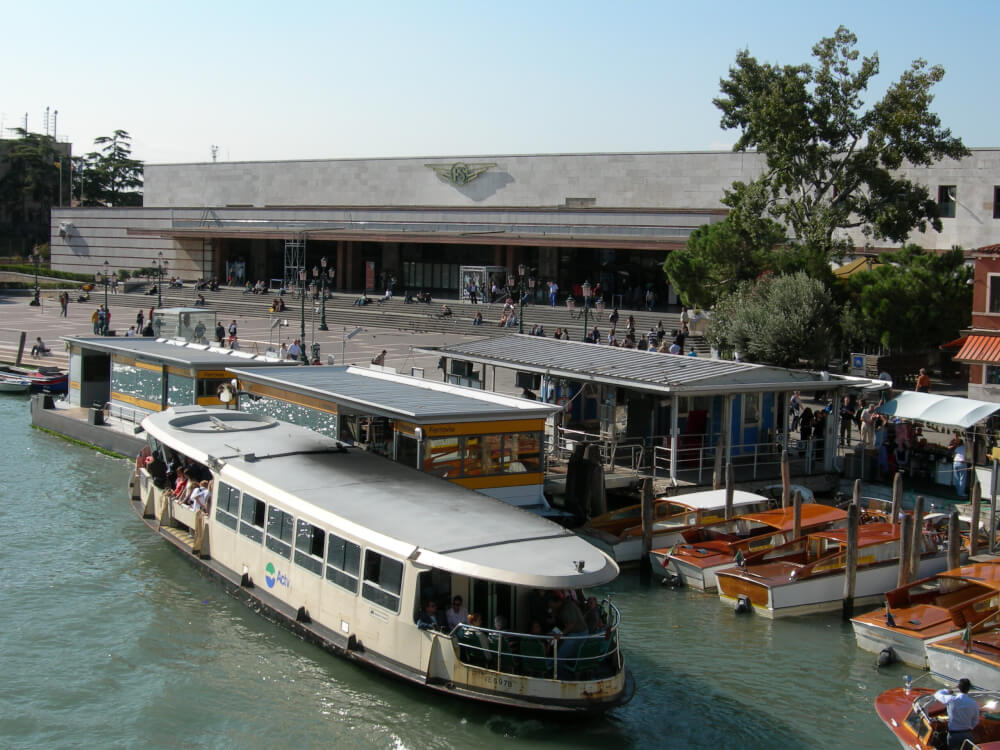
Venezia Mestre on the other hand is located on the mainland and is where you’ll find a lot of admin buildings… but also locals, because (surprise!) it’s much cheaper to live there.
Odds are, unless you’re staying in Mestre, you won’t have much reason to disembark at Venezia Mestre Station , so make sure you’re looking out for Venezia Santa Lucia Station, and you don’t accidentally get off early.
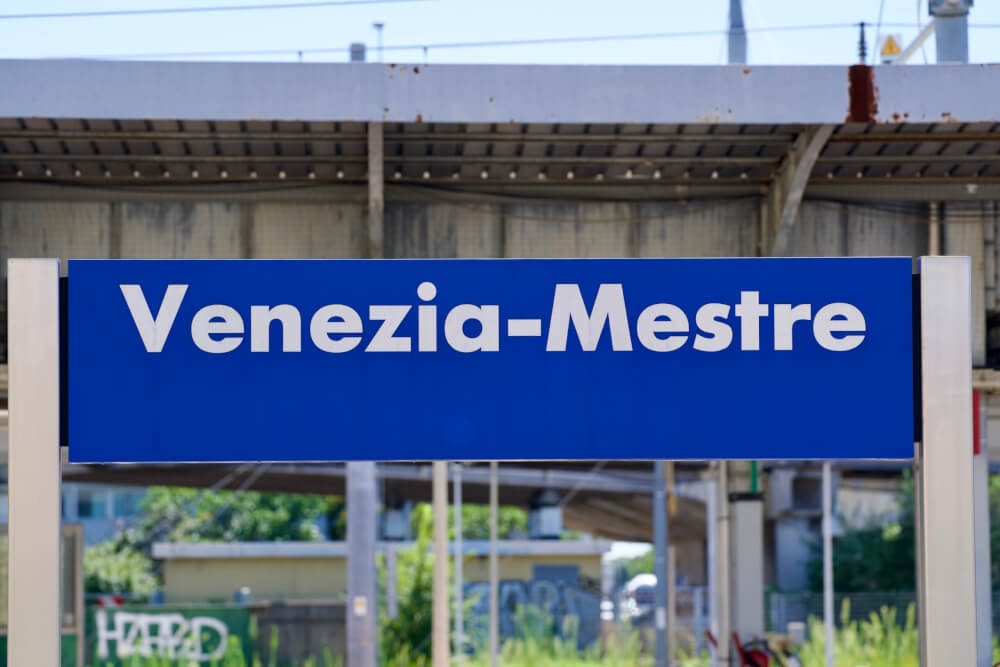
9. Remember you can’t drive in Venice
Now, the last option for arriving in Venice is by car but again, remember: no cars are allowed in Venice’s historic centre. It’s part of what makes this city so aggressively charming.
SO, if you drive to Venice, you will need to leave the vehicle at a pricey parking lot on the outskirts of the city during your stay. So, it’s not really an option I’d recommend unless Venice is just part of a big road trip you’re doing that includes other destinations.
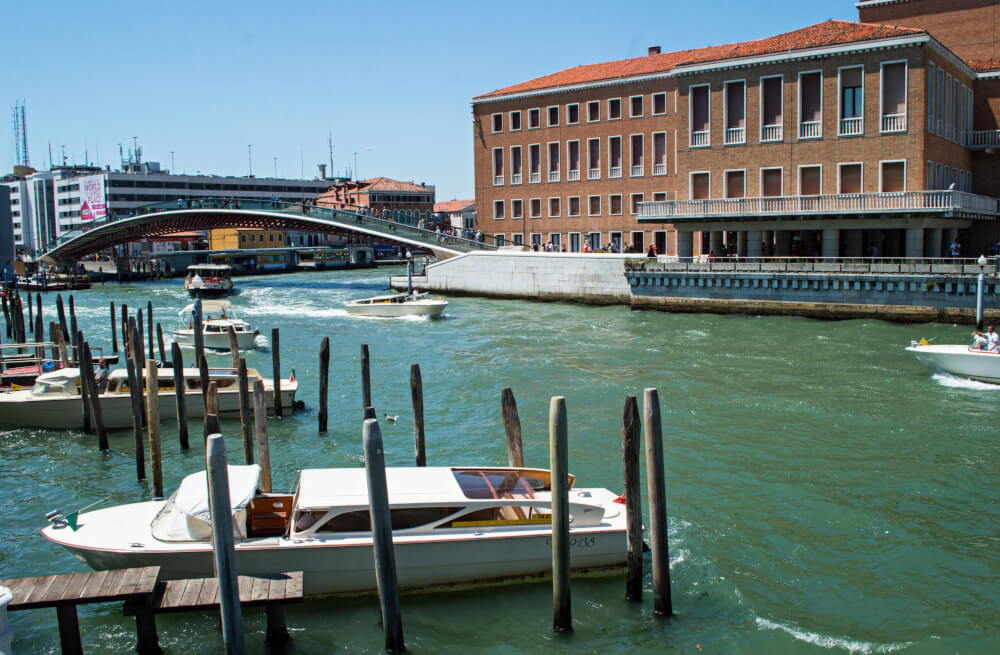
10. Know the pros and cons of staying in historic Venice vs. on the mainland
Now let’s chat about where to stay.
When choosing accommodation, the two main areas to consider in Venice proper are either the historic centre or Mestre (the mainland bit where options tend to be cheaper).
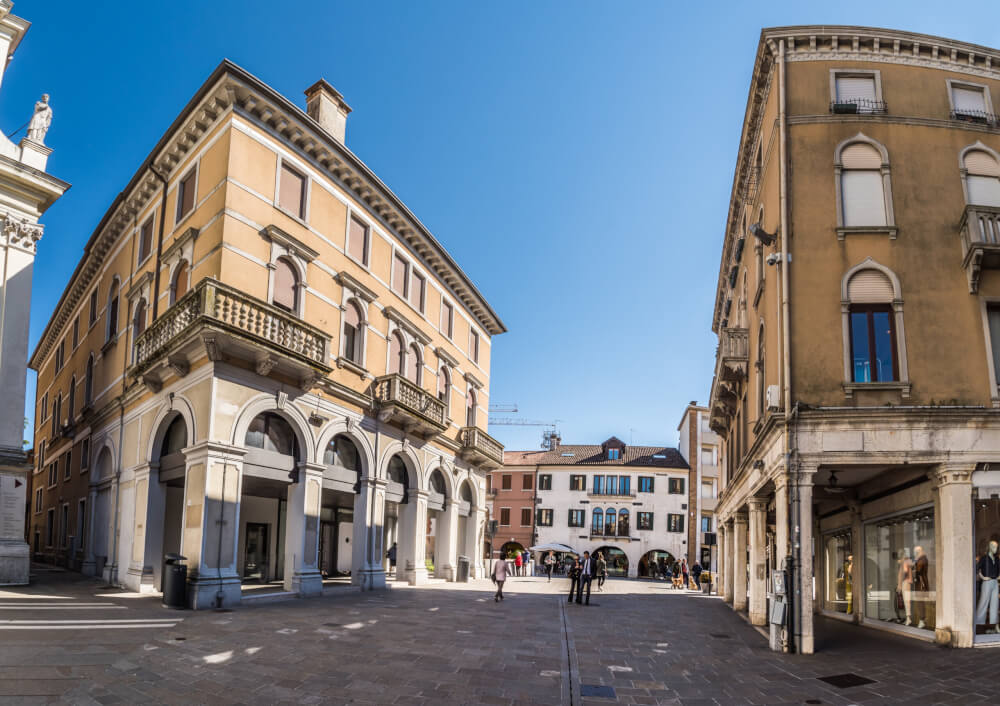
If budget allows, staying in the historic centre is ideal because then you can easily explore Venice before and after the day trip crowds. It’s also much dreamier to be staying in the city, and is the option I’d recommend to any first timer.
… If you really can’t resist a hotel deal in Mestre though, don’t fret – you’re only a short train/boat ride away from Venice proper.

11. Understand the pros and cons of Venice’s different neighbourhoods
Alright – now it’s time to get our bearings with Venice’s historic centre, which is actually more fun than in most cities, because this magical city happens to be shaped like an actual fish.
… Oh yes. What a plaice.
Anyways, this historic centre of Venice is divided into six districts known as sestieri , arranged fishily like so:
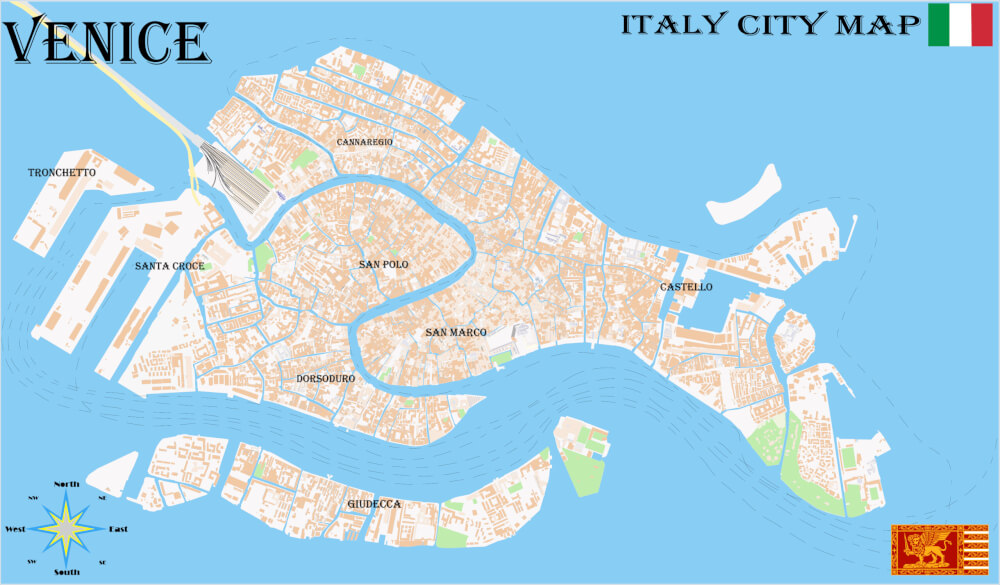
If money is no object, staying in the belly of the fish is going to put you in close proximity to most major sights, with San Polo and San Marco being the priciest and busiest neighbourhoods.
Dorsoduro (bottom belly, I guess) is also a great choice, with some more affordable options and some quieter pockets as well.
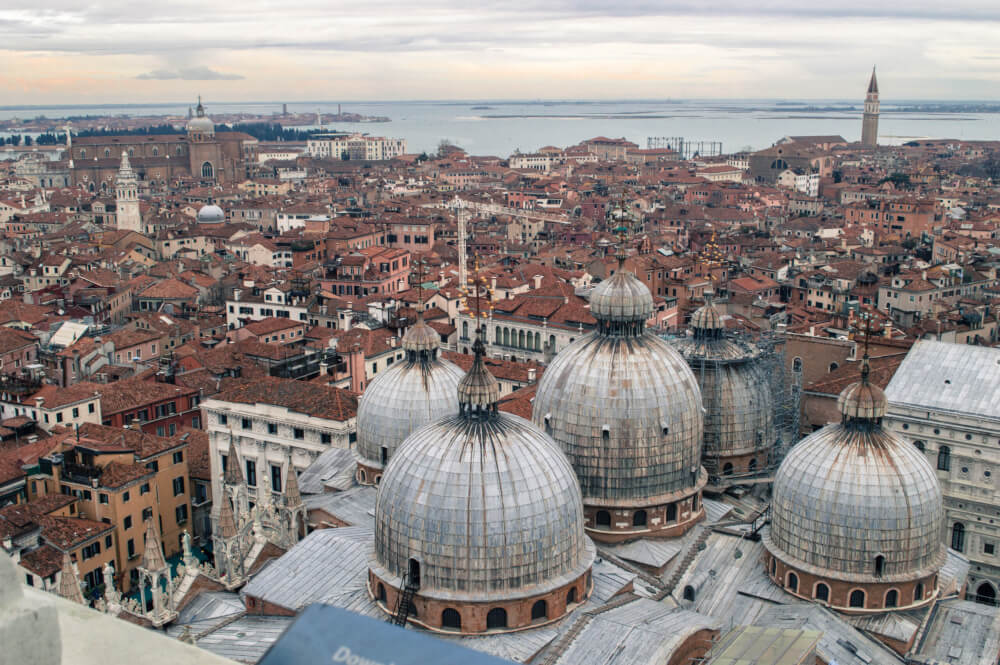
If your goal is avoiding crowds though, the tail of the fish, Castello , is the largest of the sestieri and also the quietest, relatively speaking.
And in terms of transport links, the most convenient areas are Cannaregio , the head of the fish which is home to Santa Lucia train station and Santa Croce, the fish nostrils, which is home to the transport hub Piazzale Roma… but of course, the vibes here may not feel as classic historic Venice as many visitors want.
NOTE: Some visitors may choose to stay at another island in the Venetian lagoon for a quieter and more affordable experience, but again, I’d really recommend staying in historic Venice for your first trip just to make the most of your time there.
Overall, there are lots of pros and cons to all these sestieri . If you’re stuck on finding the best place for you, check out my guide to finding the best accommodation every time to help narrow down your choices.
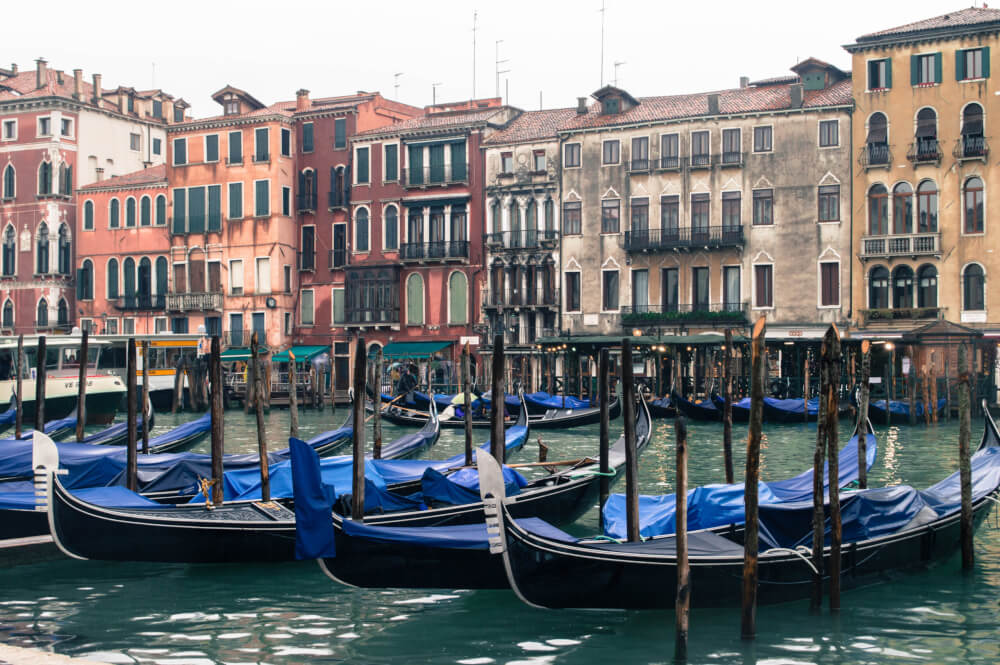
12. Pack light
Out of all the Venice travel tips I’m sharing in this post, packing light is possibly the most important.
I get it – maybe you want to bring a bunch of ballgowns for the most epic photoshoot of your life… or maybe you need space to hoard magnets. Either way, you might need to rethink how much you bring.
Not only do water taxis and boats have restrictions on how much luggage you can bring on board, you’re almost always guaranteed to end up carrying your bags on your own at some point, whether to get up on a bridge, on or off boats, etc.
So, don’t bring any bags you can’t reasonably carry yourself.
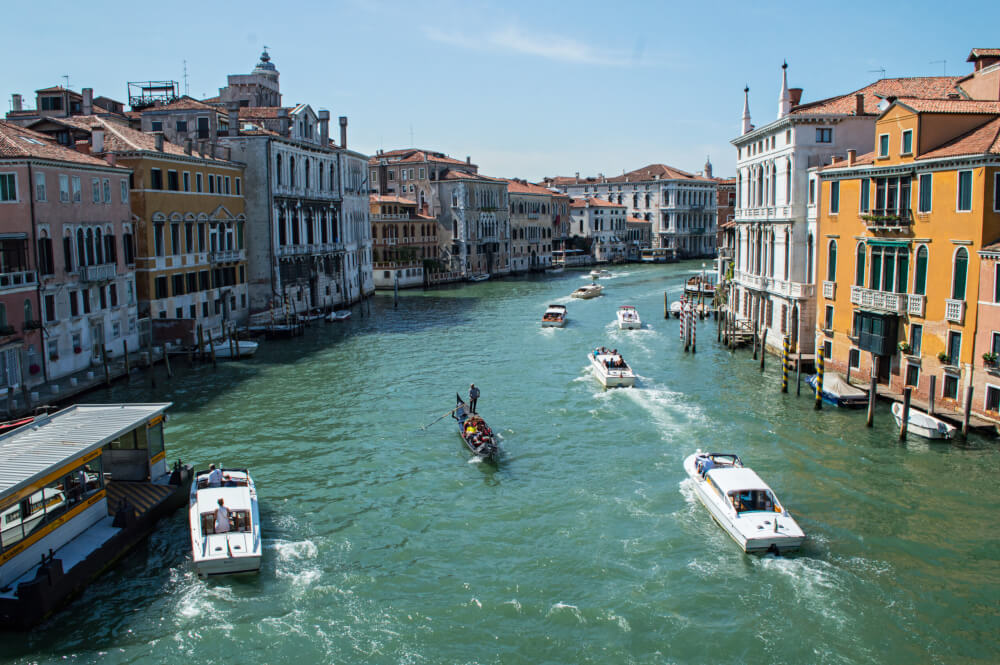
13. There are many options for navigating Venice via boat
By now, you should realize there’s only two ways to really get around Venice: on foot or on water.
In terms of water transportation, the cheapest option is to go by Vaporetto , which are like public water buses. One way tickets are quite steep at €9.50, so I’d advise buying a TravelCard that includes unlimited travel for set time periods like 24h, 48h, 72h or a week.
You can also book a Motoscafo or private water taxi that will cost significantly more, with trips within the city often going for 70 euro or more.
Of course there’s the world famous gondolas too, but do note that these are more for sightseeing than actual transportation, so we’ll discuss them later.
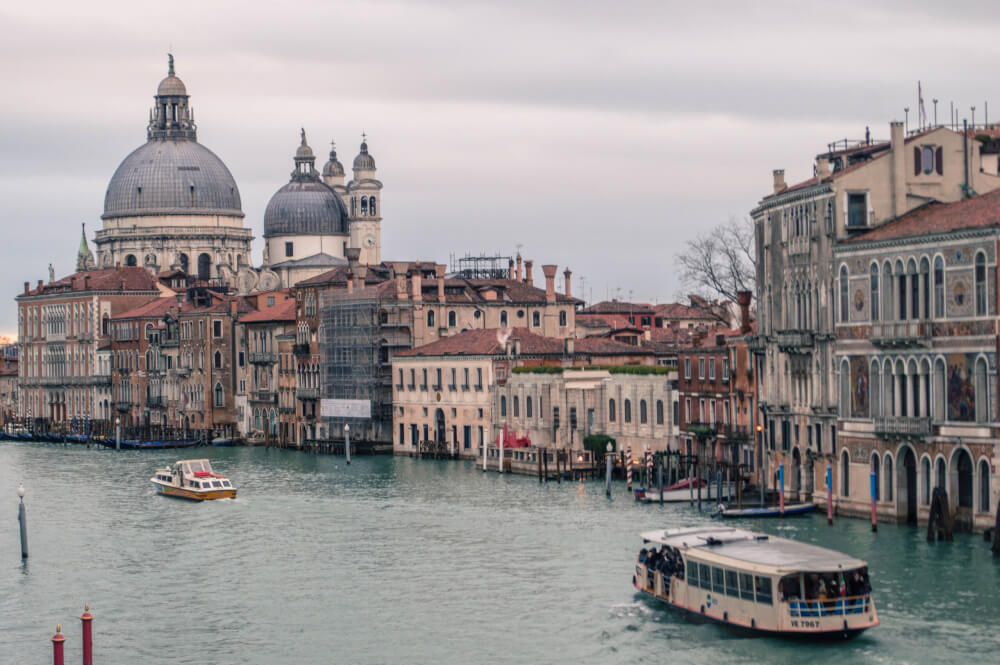
14. Don’t be too reliant on GPS in Venice
For shorter distances, the better way to get around Venice is (in my opinion) on foot.
One important thing to note however is that GPS services like Google Maps don’t work very well in Venice, with the blue dot often very confused as to where you really are amidst the city’s sea of centuries-old buildings.
So, if you’re highly Google Maps-dependent like me, it’s time to practice some old school navigation skills. Plan your route with landmarks and street names! Take note of your route as you go! Leave a trail of breadcrumbs! (But don’t.. because Venetian pigeons are scary)
In any case, remember to not rely on Google Maps, and plan your routes accordingly. Having a backup offline map downloaded or a paper map is also probably a good idea.

15. Add additional time buffers and assume you’ll get lost
Another silly but helpful Venice navigation tip?
Just assume you’ll get lost. Honestly. Because you will!
And if you assume it’ll happen, then you’ll ensure you have extra time buffers between booked activities, thereby minimizing stress and saving the family vacation. Yay!

16. Get your bearings by using Venice’s unique street signs
When trying to find your way around, your best friend in Venice (besides me, of course) will be the city’s unique street signs, known as nizioleti , which are beautifully painted on the walls of buildings.
… The trouble? Nizioleti can be deceptively confusing, because Venice has many unique terms for streets and places that aren’t familiar to most visitors.
So, here’s a quick crash course!
The most common word you’ll see is Calle which refers to a typical street. Some variations of this you might see include:
- Calle Larga , which means wide street and
- Calleta, which means a narrow street
In any case, this term generally applies to streets that have buildings on both sides.
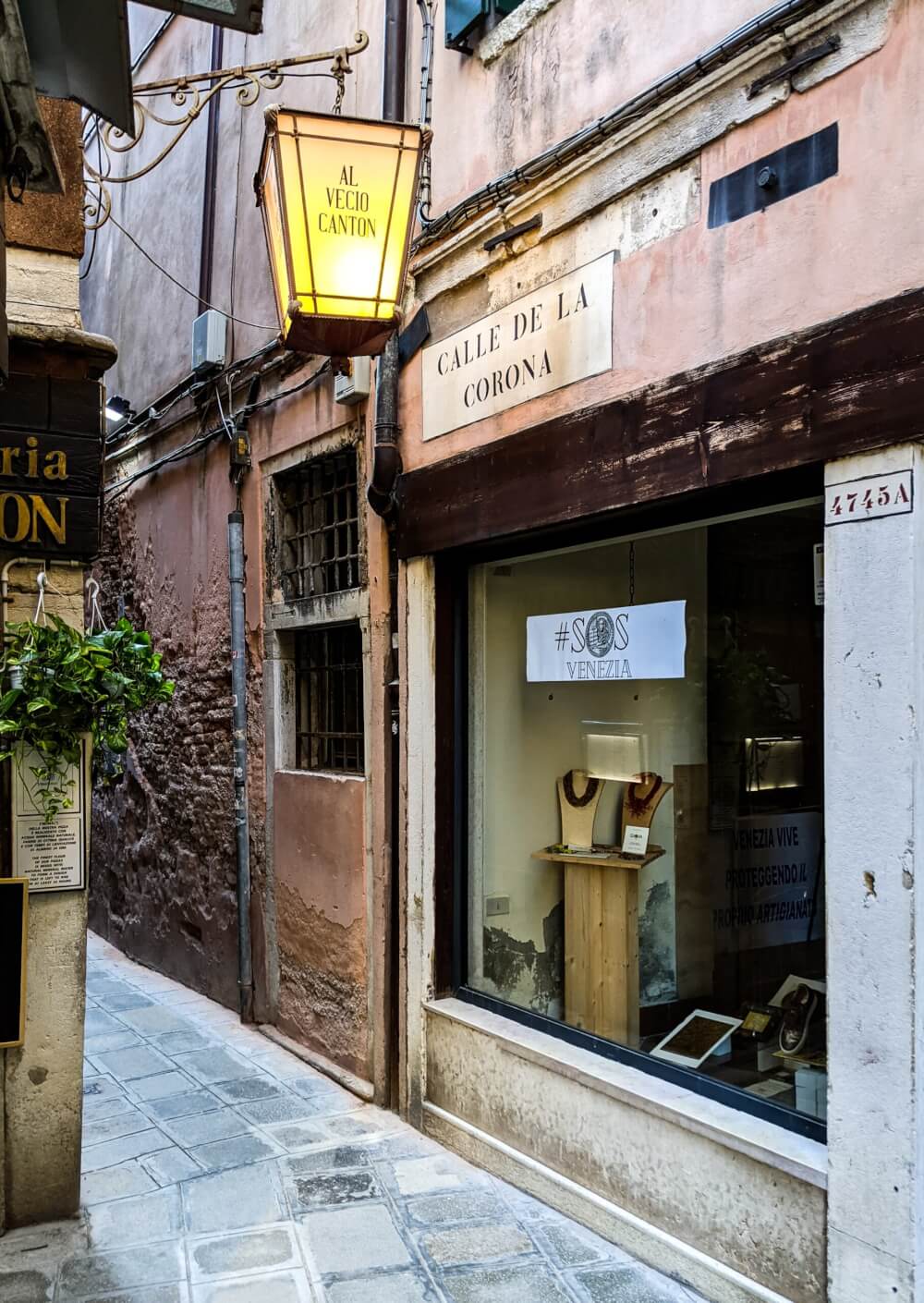
This is in contrast to a Fondamenta which is a canalside street that has a building on one side and a canal on the other.
Similarly, a Riva is a street that has buildings on one side and then a larger expanse of water on the other side.
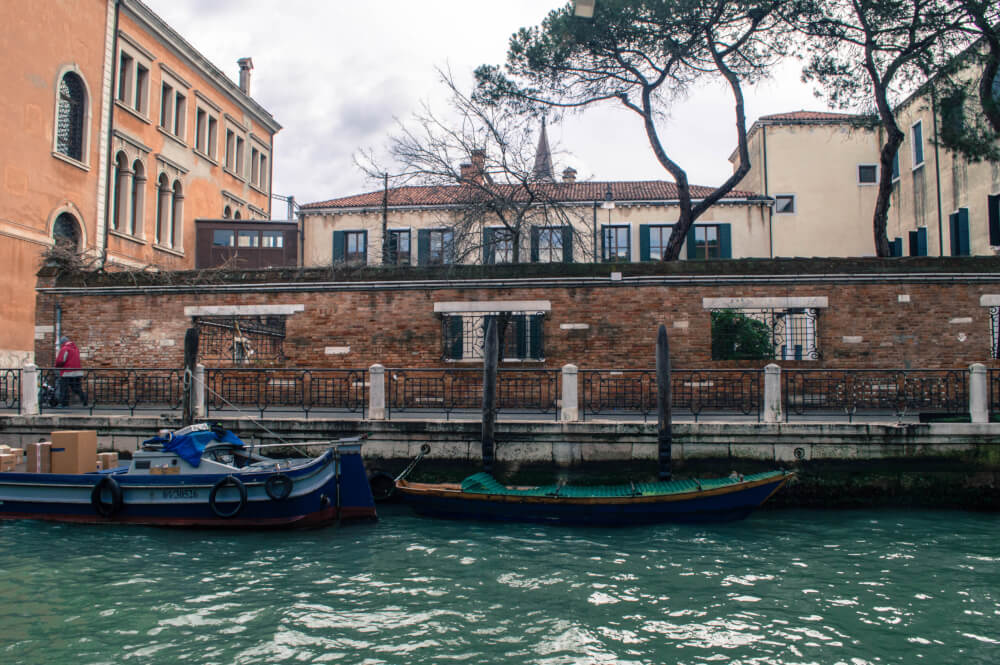
Ramo is a small side street that often leads to a dead end and Sotoportego are unique passageways that go under buildings.
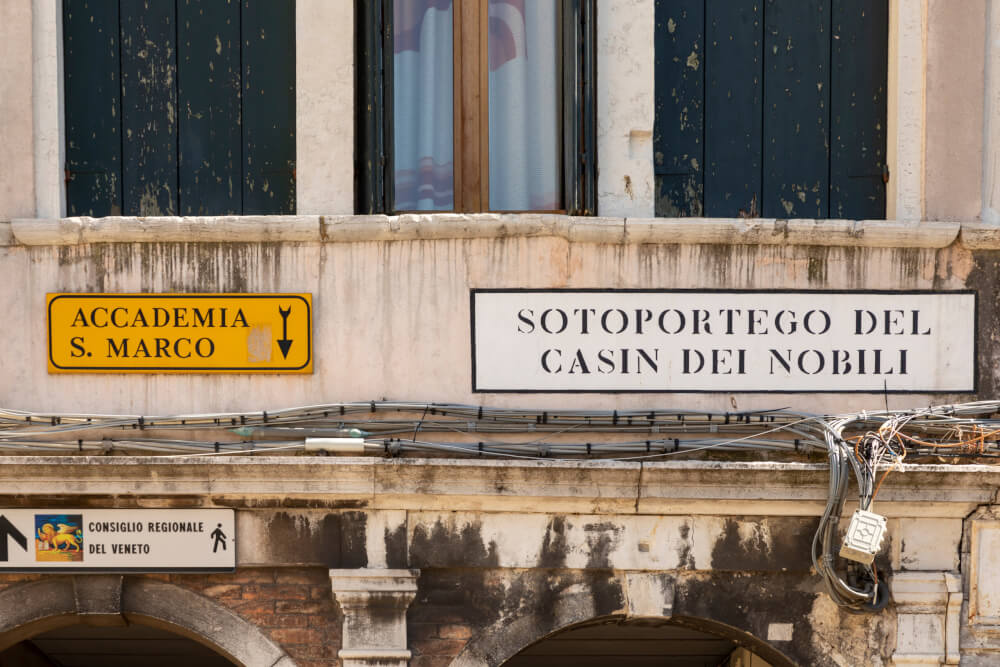
And you’ll also see other terms used for street that don’t really have as much to do with the physical properties of the street itself, but rather makes reference to its history, like…
- Salizada for instance is a word used for some of the city’s most historically important streets, and therefore the ones that were paved with cobblestones first
- Rio Tera refer to streets that used to be canals before they were filled to make streets, and
- Ruga are streets that used to be filled with compacted soil so your shoes wouldn’t get dirty

There’s also Campo which refers to a typical Venetian square. Unlike other places in Italy where the word piazza tends to be used for Square, Venice has only one Piazza, Piazza San Marco or Saint Mark’s Square.

The word Ponte means bridge, and you’ll see this one a lot because Venice has hundreds.
And lastly, the word used for most Venetian waterways is actually Rio, whereas Canal is reserved only for the big ones like the Grand Canal.
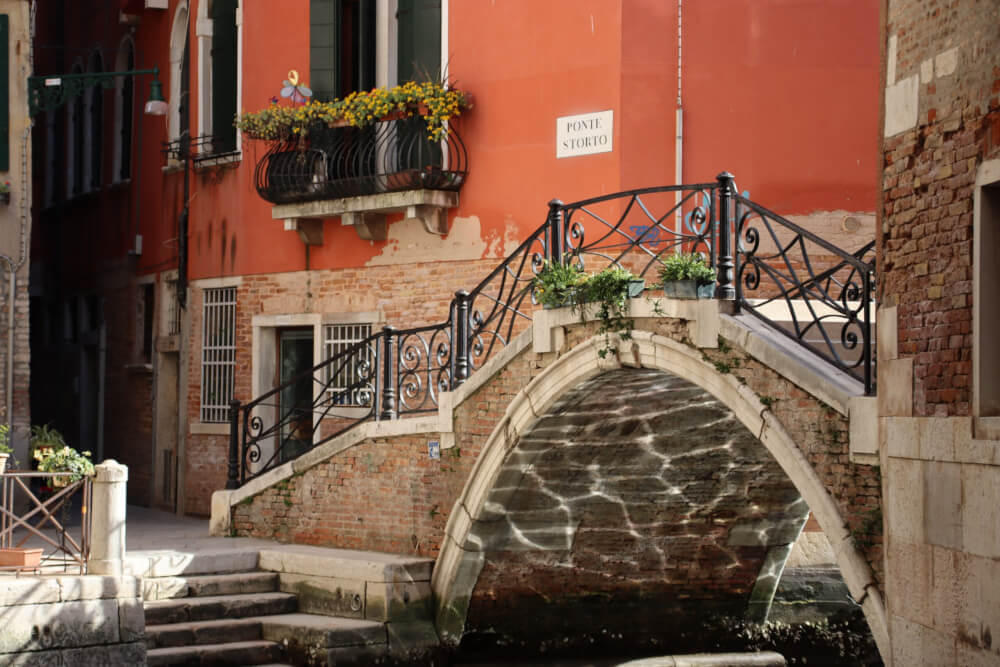
To get your bearings, you can look for signs with a red frame and lettering, which usually have an arrow pointing you in the general direction of famous landmarks. There are also some special yellow ones as well that do the same job.
The word “per” in these cases translates to “for” so, this way FOR Rialto Bridge.
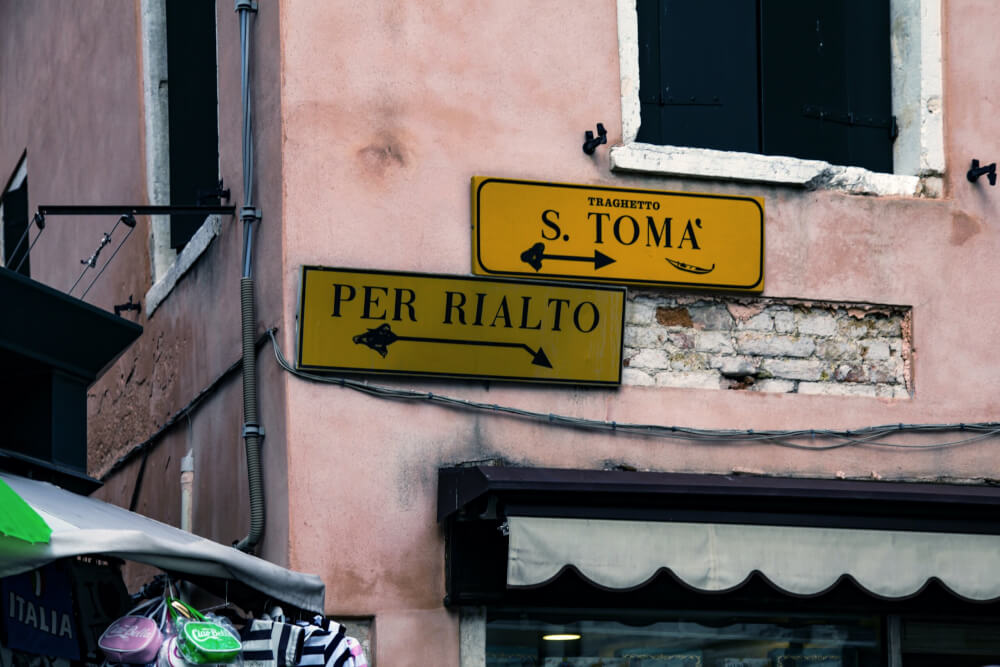
17. Book big must-do attractions in advance
Now, let’s move onto Venice attraction tips!
As I mentioned before, no matter when you go to Venice, it’ll be busy, so if you have your heart set on any attractions, pre-booking is essential. You can do so online at a variety of places, like here:
- (Recommended!) Venice Passes & Bundles
- Doge’s Palace
- St Mark’s Basilica
- St Mark’s Bell Tower
- Classic Gondola Ride
For timed attractions, I would advise booking either the first possible time slot or the final one if your goal is to minimize crowds.
For untimed attractions, I would aim to either be there when it opens or just before it closes, because the middle of the day is almost always going to be the busiest time.

18. Book a sunrise tour
If your goal is to experience Venice like you own the place, walking around at sunrise is pretty much the only way to do it.
I booked a summer sunrise tour of Venice years ago and still think it’s one of the best things I ever did in the city. Getting to see all of Venice’s main squares and canals void of people was absolutely priceless.
And while sadly, the tour I took doesn’t seem to be offered anymore, there’s still a few alternatives, like this one that that includes breakfast.
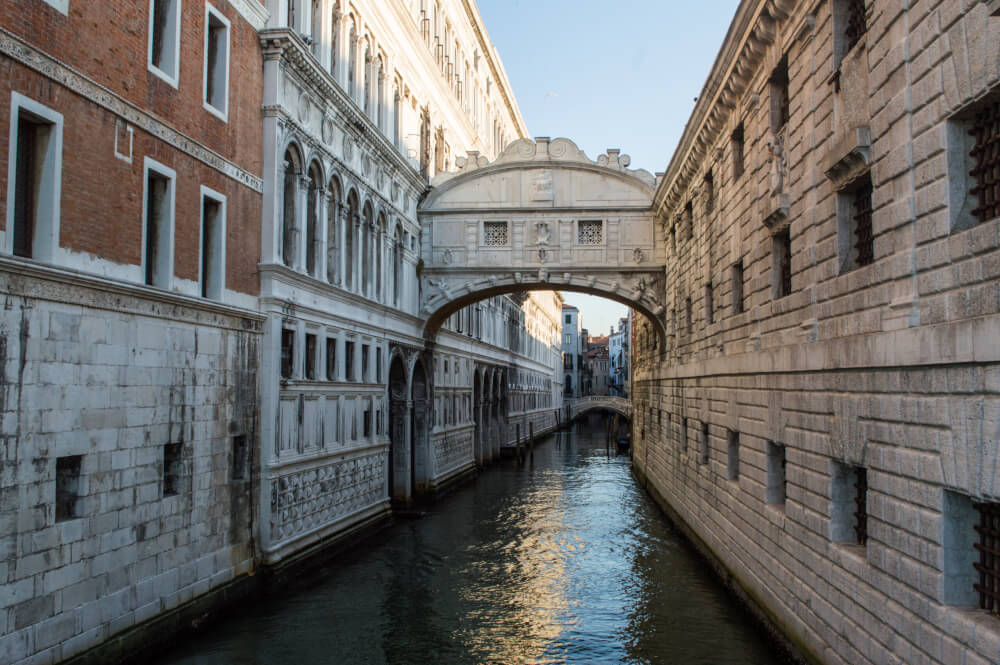
19. Or book an after-hours tour
On the other hand, if you’re more of a night owl than an early bird, you can also look into after hour tours for certain attractions which get you entry after they close to the general public.
Here’s one for instance that gets you into St Mark’s Basilica after hours.

20. Choose the right sightseeing pass for Venice
Now if you’re hoping to save money during your visit in Venice, one thing to consider is getting a sightseeing pass ( you can browse some options here ).
Confusingly, Venice has several and the best choice for you will depend on which specific attractions you’ll see and how long you’re going to be in the city.
Here’s a quick breakdown of the most popular options:
- Venice Pass : Probably the best deal for most 1st timers because it includes a lot of attractions like St Mark’s Basilica, Doges’ Palace and also a gondola ride, plus many other attractions.
- Venice Discovery Pass : Includes key attractions plus public transport on Vaporetto boats, including to and from the airport.
- Venezia Unica City Pass: Includes Doge’s Palace, Bridge of Sighs and Armory, plus extra churches and museums
Overall, if you plan to do a lot of sightseeing, one of these passes would probably be worth it.
To choose which one, I would write down my top must-do activities and the duration of my stay, then see which pass fits those needs best.
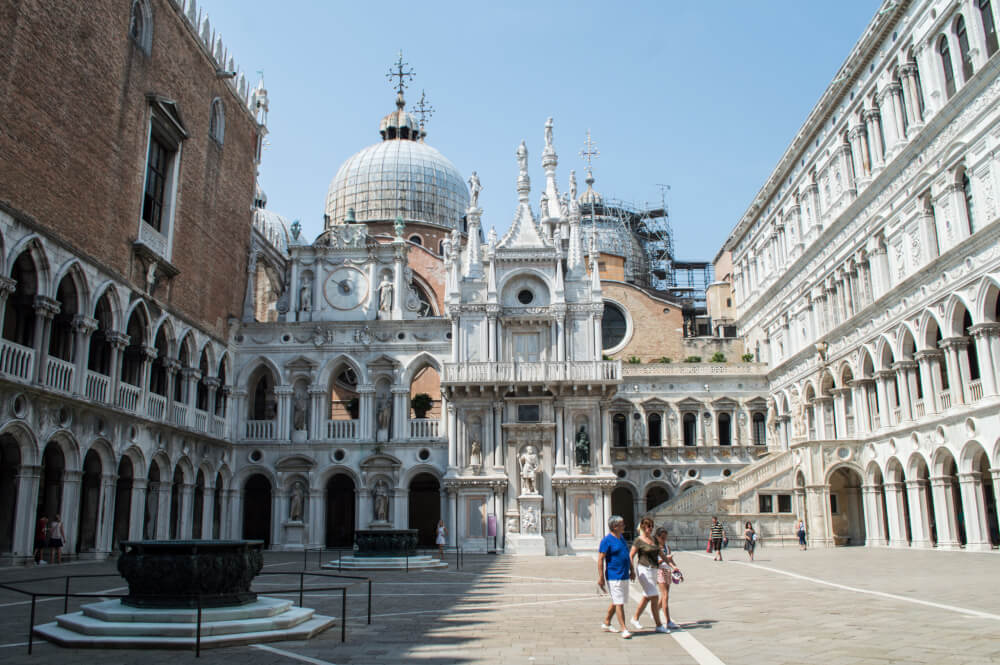
21. Go beyond the main popular attractions in Venice
Of course, like in many major cities, some of the most charming parts of Venice can be found beyond the most famous sights.
In Venice, some wonderful gems to explore include…
- Liberia Acqua Alta : One of the world’s most beautiful bookstores which has a really cool section in the back with displays made of ruined books. This isn’t so much a secret anymore but it’s still very cool!
- Free rooftop terrace at Fondaco dei Tedeschi : Beautiful and free views that you have to book in advance here
… As well as plenty of museums that many visitors miss, so be sure to do a bit of extra research to find cool hidden gems!
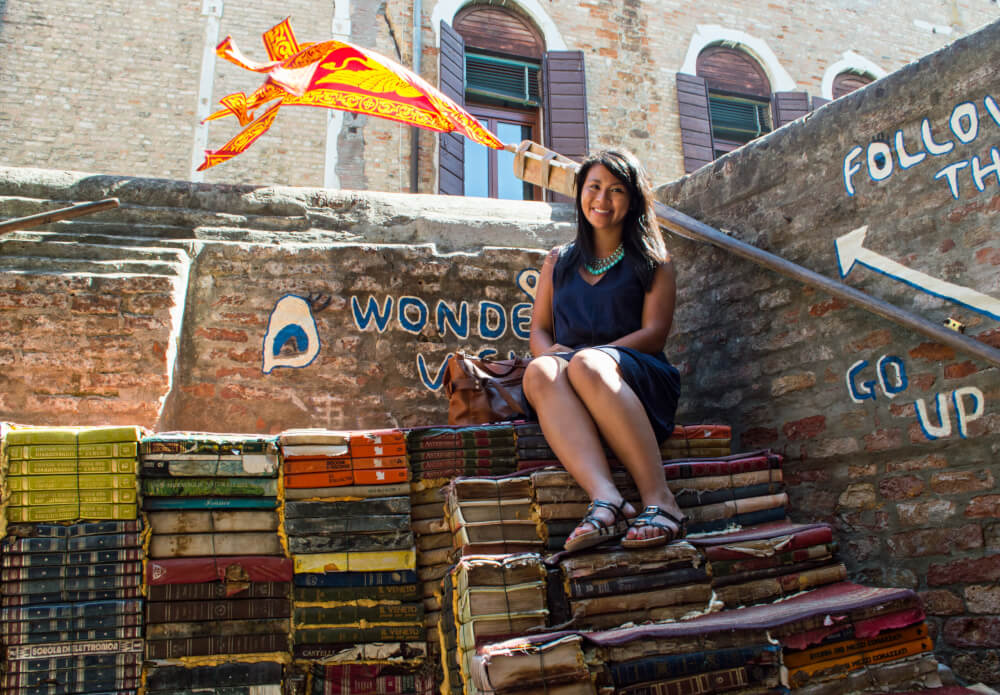
22. Remember: Gondola prices are fixed
Now, let’s move onto gondola tips for Venice. The first thing to keep in mind is that prices for gondolas are actually fixed, so there’s no room for negotiation.
According to the official City of Venice regulations, gondolas can fit up to 5 adults at once and as of October 2023 cost a fixed rate of €80 for a 30 minute ride during the day, and €100 at night.
NOTE: If you don’t mind sharing with strangers, a more budget-friendly way to get a gondola ride may be booking a seat for yourself like through here .
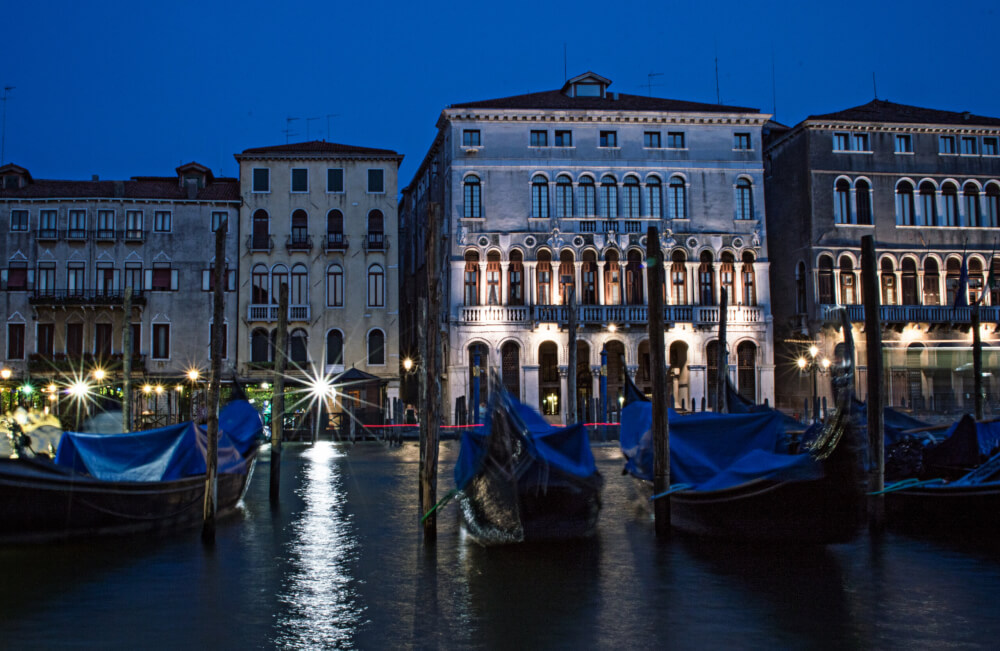
23. Gondolas take different routes so choose wisely
Now, while gondolas all cost the same, it’s important to note that they don’t take the exact same routes, so be sure to ask the gondolier beforehand where they go, and try to make sure it’s a combination of both smaller canals and also the big iconic must-sees.
BONUS TIP: Be sure to also vet the vibe of your gondolier, because that can make a huge difference in your experience. The last thing you want is a grumpy gondolier that seems to despise everything about you…
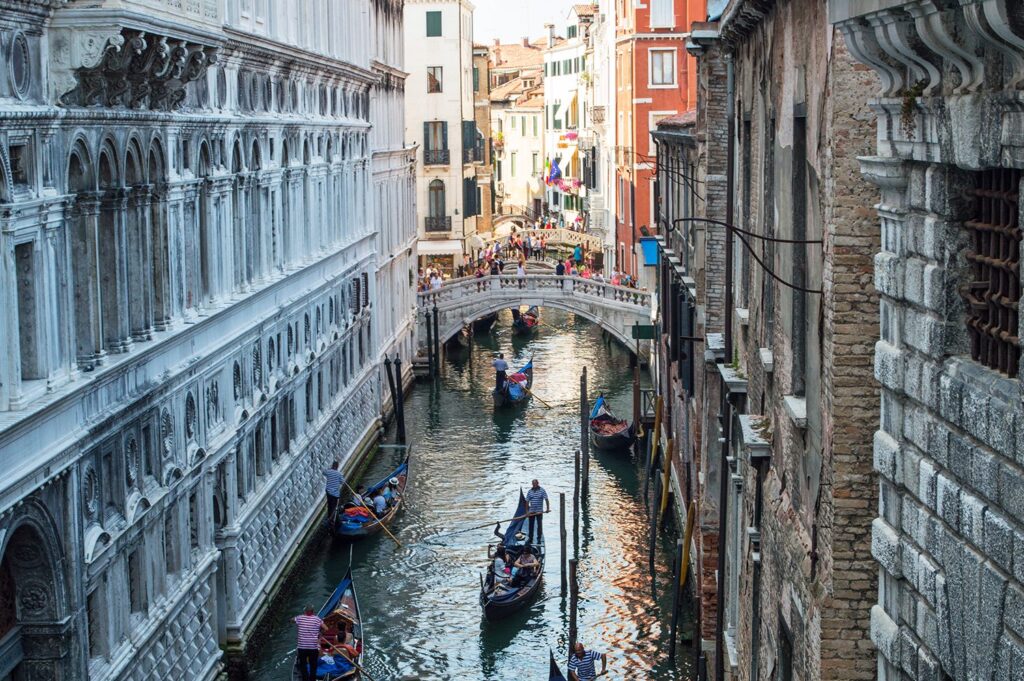
24. Try to time your gondola ride for the morning
Especially if you’re visiting in the summer, I would time your gondola ride for the morning because…
- a) It’s the least busy time
- b) It’ll be less hot (there’s no shade on these gondolas!)
- c) Morning is when gondoliers will likely be in their best moods
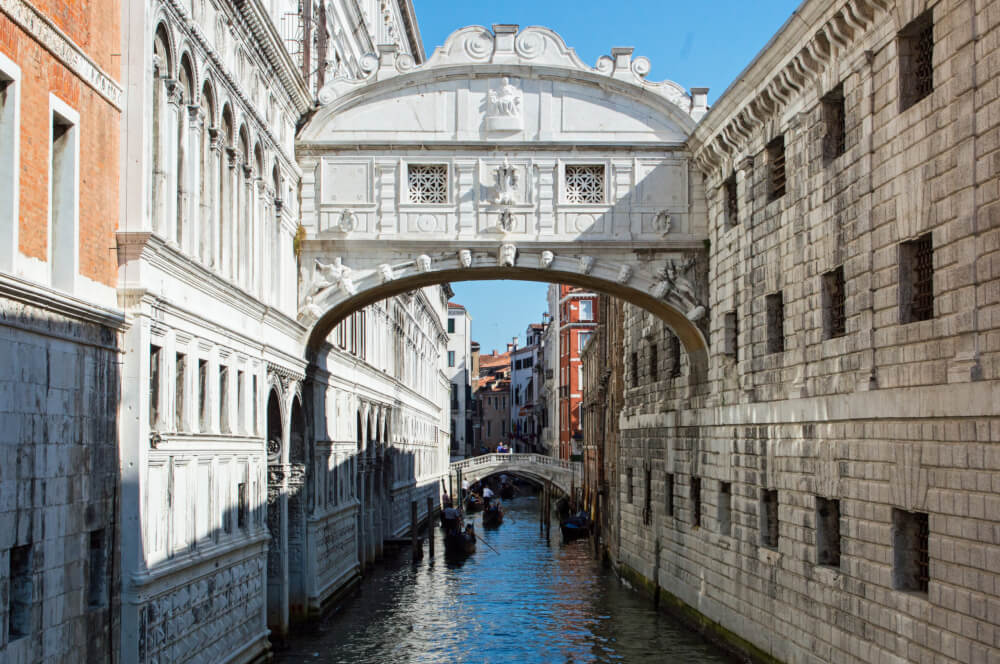
25. Consider boarding your gondola in a quieter part of town
Of course, you can expect that line-ups for gondolas around the Grand Canal area will be the worst, so if you don’t mind visiting quieter less “famous” canals, then I’d advise starting your gondola ride elsewhere for a more peaceful experience overall.

26. Board a Traghetto for a budget-friendly boat ride
Now, if gondolas feel overly pricey, then there’s still another way you can get a boat ride experience in Venice for a fraction of the cost.
Enter the almighty Traghetto!
These boats whisk locals and tourists alike across the Grand Canal for the low, low price of €2. That’s right, you could literally ride the Traghetto back and forth forty times for the price of one scenic gondola…
Now, is it the same experience? Obviously not. A Traghetto ride is fairly short, and involves a larger less opulent boat. But for the price of a bottle of water? It’s not a bad budget hack at all.

27. Consider booking a rowing lesson instead of a gondola ride
Lastly on the boat front (because wow, I didn’t realize I had this many boat-related Venice tips), consider booking a lesson with Row Venice if you’re hoping to get out on the water in a non-touristy fashion.
This unique (non-profit) company offers rowing lessons and tours that allow you to traverse Venice’s iconic waterways in a way that most tourists never get to experience – with you in control!
The cost is on par with a regular day time gondola ride, except the lessons last 90 minutes so you’re on the water for the triple the time. Definitely worth looking into if you’re looking for unique things to do in Venice.
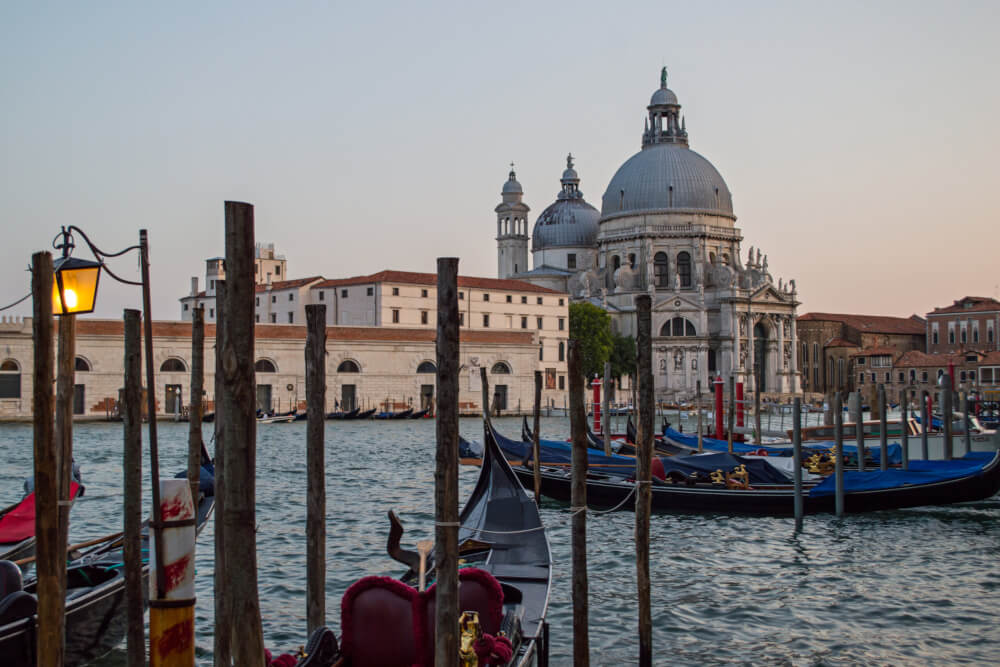
28. Avoid dining in St Mark’s Square
Alright, now it’s time to tackle Venice food tips!
First off – as enticing as they look, do avoid the fancy restaurants in St Mark’s Square.
While the views and vibes are immaculate (with someone playing the Godfather theme on the accordion at all times, it seems), the restaurants here are well known tourist traps with inflated prices and often poor food quality.
If you do want to enjoy the atmosphere though, maybe opt for a coffee or drink instead, then eat elsewhere.
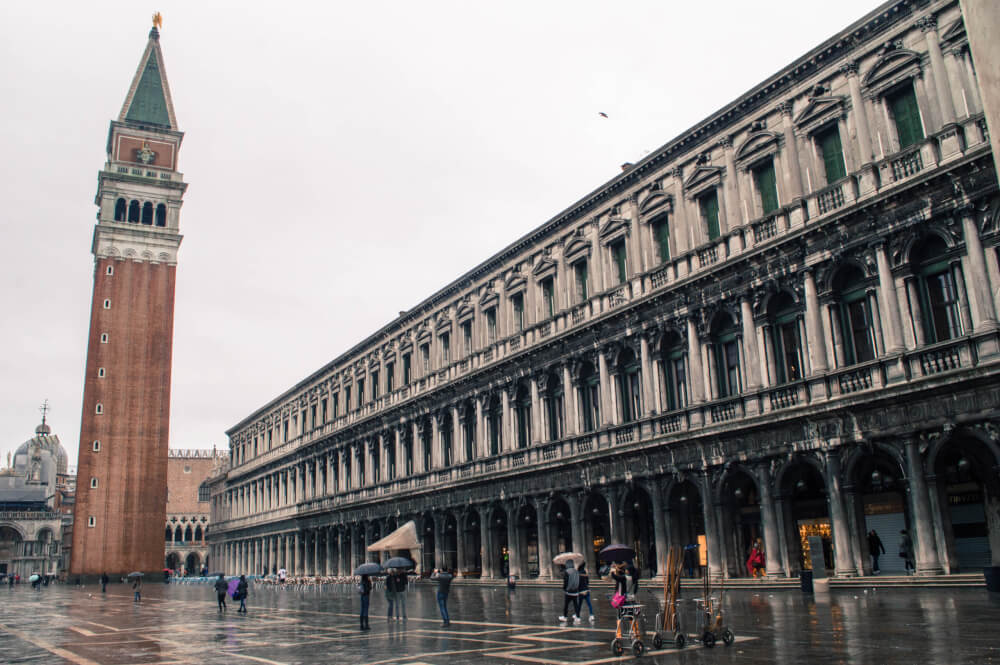
29. Dine far away from major tourist attractions
On a similar note, I would try to dine as far away as possible from major tourist attractions for the same reason.
Most of the time, these restaurants cater to tourists and don’t prioritize good service or quality since you probably won’t come back anyway.
I find that quality and prices tend to improve dramatically once you find yourself outside of the main tourist hotspots, so be sure to shop around and when in doubt, look at reviews.
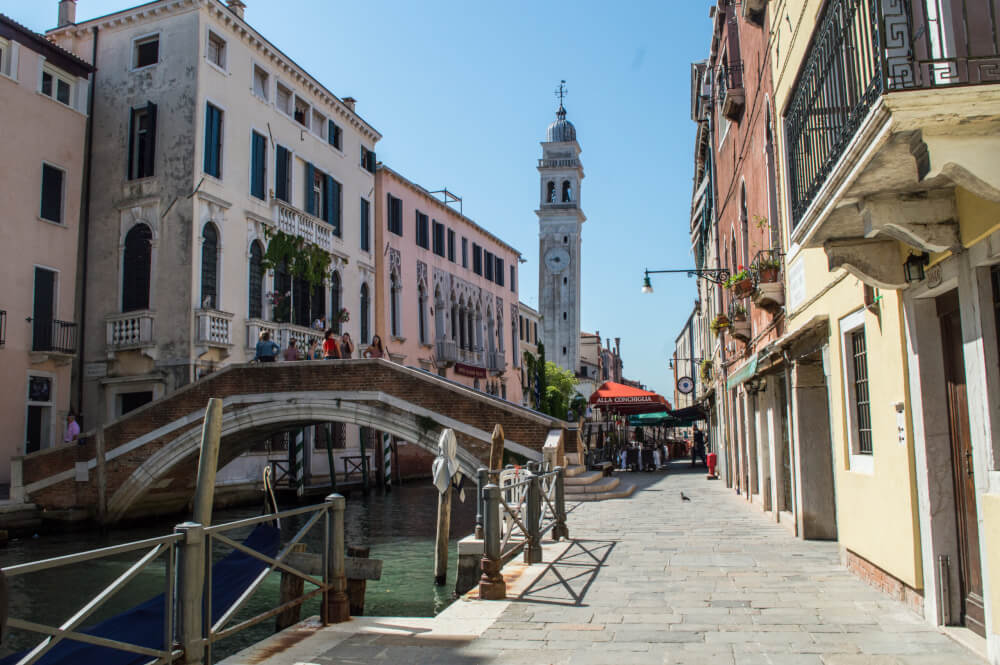
30. Only go to restaurants with prices
Another important Venice must-know? Always make sure prices are on clear display before you commit to a restaurant.
Over the years, there have been many headlines like this one about Venetian restaurants overcharging tourists for meals… and getting away with it. So don’t let that be you!
A common trick is they charge pricey items like seafood by weight, so pay special attention to that.

31. Look out for ‘Venezia Autentica’ restaurants/businesses
If you’re stuck and need a quick frame of reference, there’s an organization known as Venezia Autentica that aims to support and highlight authentic local businesses that are run responsibly.
So when in doubt, you can always look out for their stickers or browse their website for ideas.
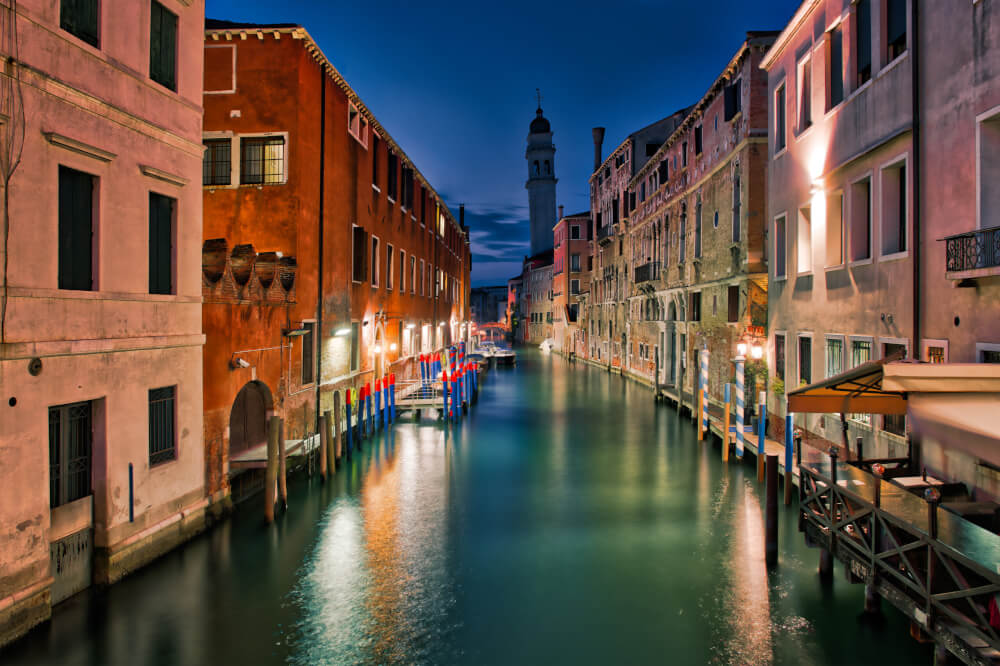
32. Try Venetian dishes while in Venice
Now another important Venice food tip is to try traditional Venetian cuisine over stereotypical “Italian foods” like pizza or pasta.
I know that sounds blasphemous, but hear me out: wood fire pizza ovens are for the most part banned in Venice, so good pizza is in pretty short supply… plus Venetian cuisine doesn’t tend to focus much on pasta.
Instead, try some local dishes, like for instance…
Cichetti: These are little bite-sized dishes you can eat with your hands or a toothpick, usually for €1-3 each. They come in a huge variety so they’re great for tasting lots of local flavours in one go and are common when you go to a Bacaro which are cozy traditional Venetian taverns.
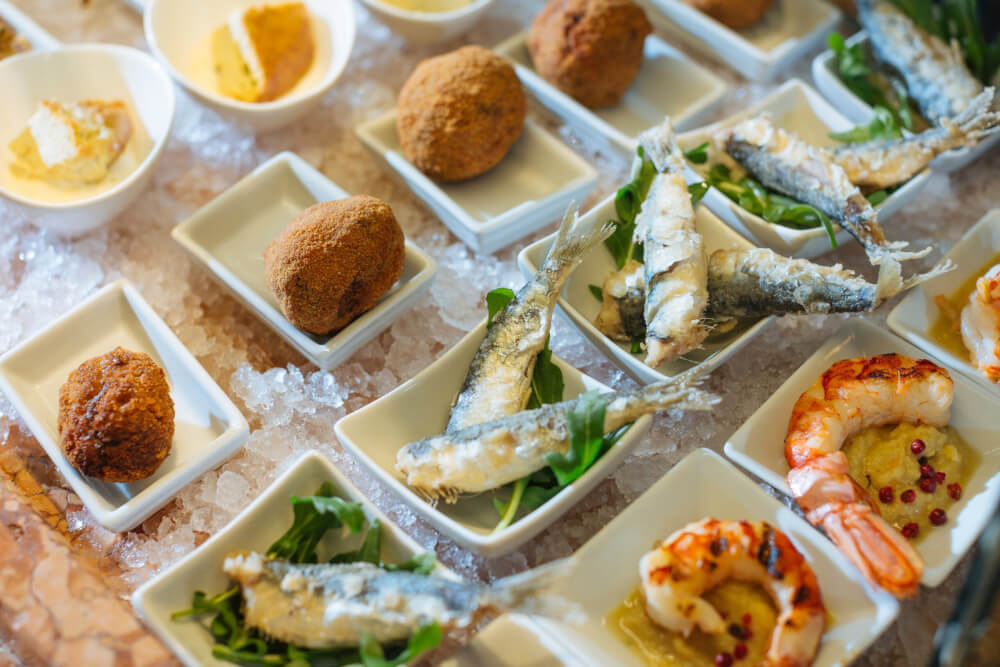
A popular dish commonly seen at a Bacaro is Sarde in Saor (Sardayn Sour) which are fried sardines served with vinegar and onion.

Venetians are also big on risotto, with a soupier iteration known as Risi e bisi which is rice and peas, that is very popular.
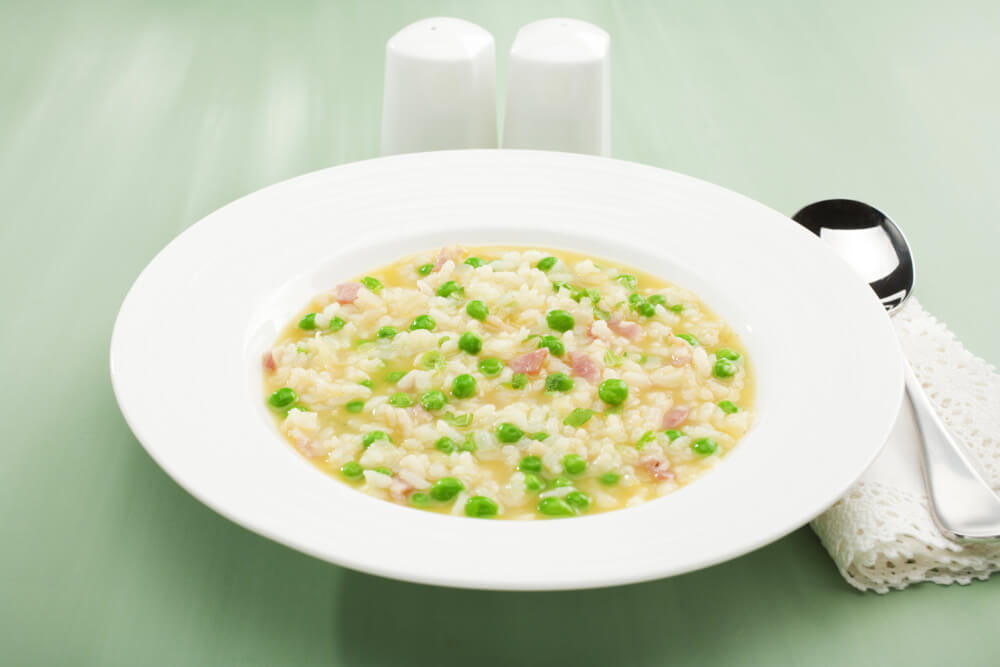
… Also very popular is polenta, which is paired with a variety of dishes like small lagoon shrimp (like in Polenta e shcie ) and liver (like in Fegato alla veneziana ).
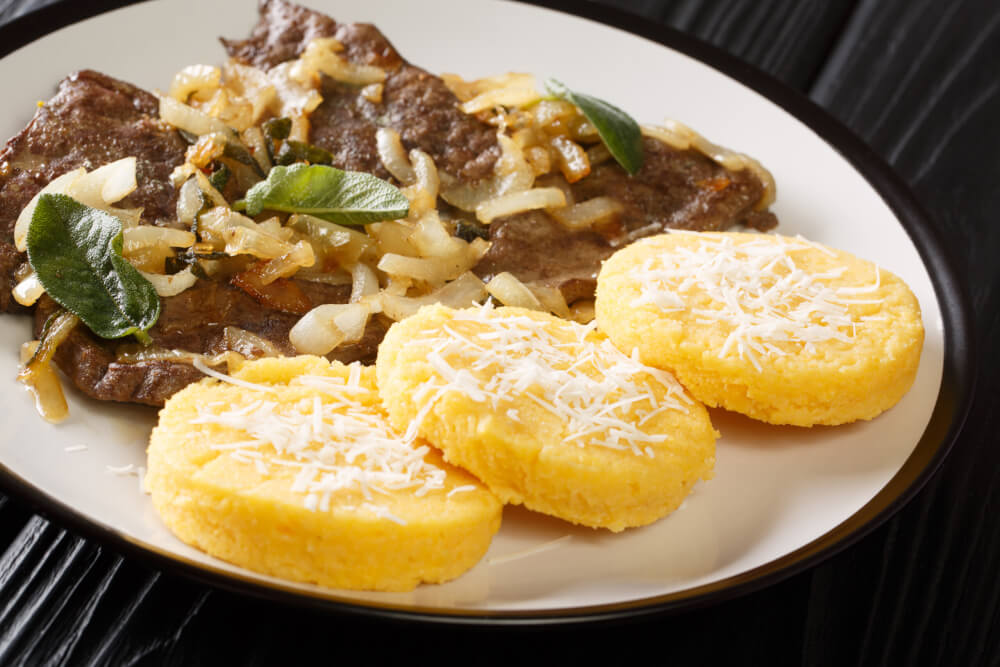
And if you feel you may combust without pasta on this trip (no judgement), try Bigoli which is a classic Venetian pasta that’s like thick spaghetti, often served as Bigoli in salsa which means with an onion and fish sauce.
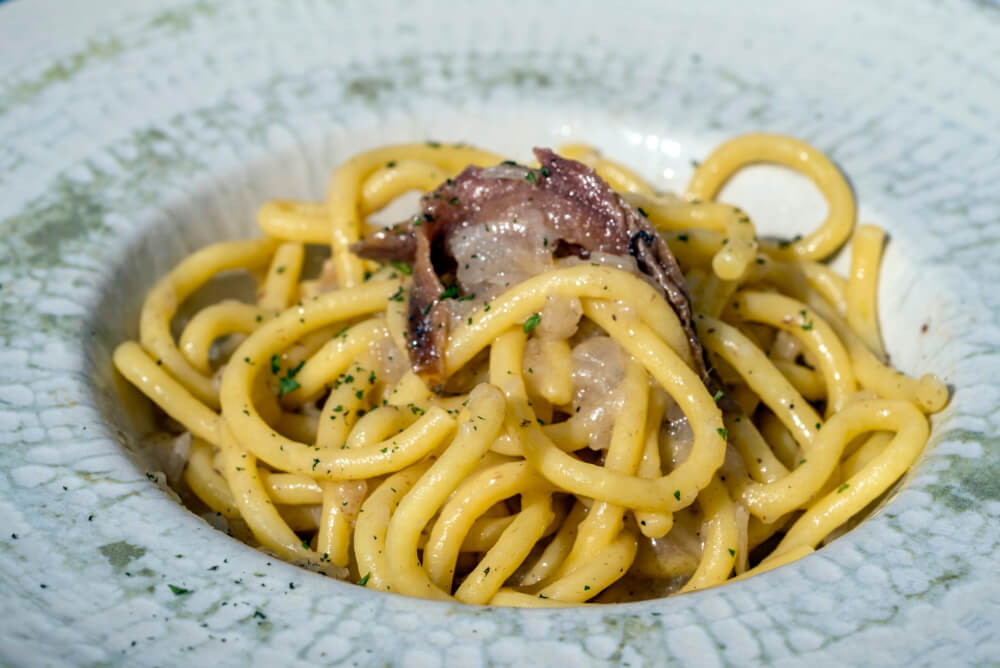
33. Bring a refillable bottle because there’s free water fountains
If you have a free second between inhaling all those delicious Venetian classics, another important must-know is to stay hydrated.
Luckily, staying hydrated in Venice is free!
All over the city, you’ll find many free drinking fountains offering clean and drinkable water, so bring a refillable bottle and take advantage.

34. Read up on more general Italy food and drink tips
There are many more general food tips I could tell you about Italy, but then we’d be here forever.
SO I’d recommend reading my full Italy travel tips post for more info on things like coffee etiquette, the structure of a typical Italian menu, and many more delicious secrets.
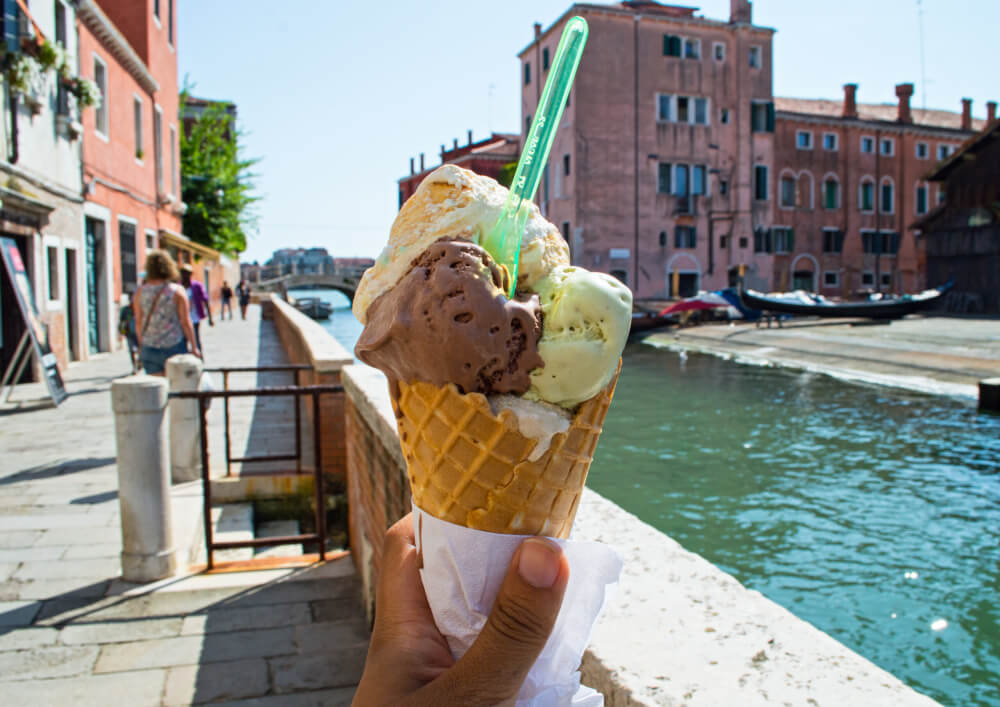
35. Take note of English/Italian names of landmarks and places
Now once you arrive in Venice, there are a few things you must know.
Firstly – keep in mind that the Italian and English names of places are often used interchangeably, so it’s helpful to remember that these are indeed the same places, for instance…
- Piazza San Marco = St Mark’s Square
- Palazzo Ducale = Doge’s Palace
- Ponte di Rialto = Rialto Bridge

36. Be prepared to pay for public toilets
Public toilets in Venice can often cost as much as €1.50, so if you’re a total cheapskate like me, remember to use the toilet whenever you have an opportunity to so like at the hotel, at a restaurant or at museums.
Also be sure to keep coins on you so you can pay for these public toilets when needed.

37. Beware of pickpockets
Unfortunately, Venice is a very popular city with many potential easy targets for pickpockets, so you’ll encounter a fair few in busy areas.
So, be vigilant and make sure you keep a hand and eye on your belongings.
… And read my full guide on how to avoid pickpockets in Europe for more guidance!
38. Don’t feed the pigeons
Besides selfie sticks and sunburns, the most common thing you’ll see in St Mark’s Square is pigeons. And lots of ’em.
More than likely, you may also witness a tourist feeding and taking photos with said pigeons. Please refrain from doing this as it’s a banned and fineable offense … which also happens to be fairly gross.
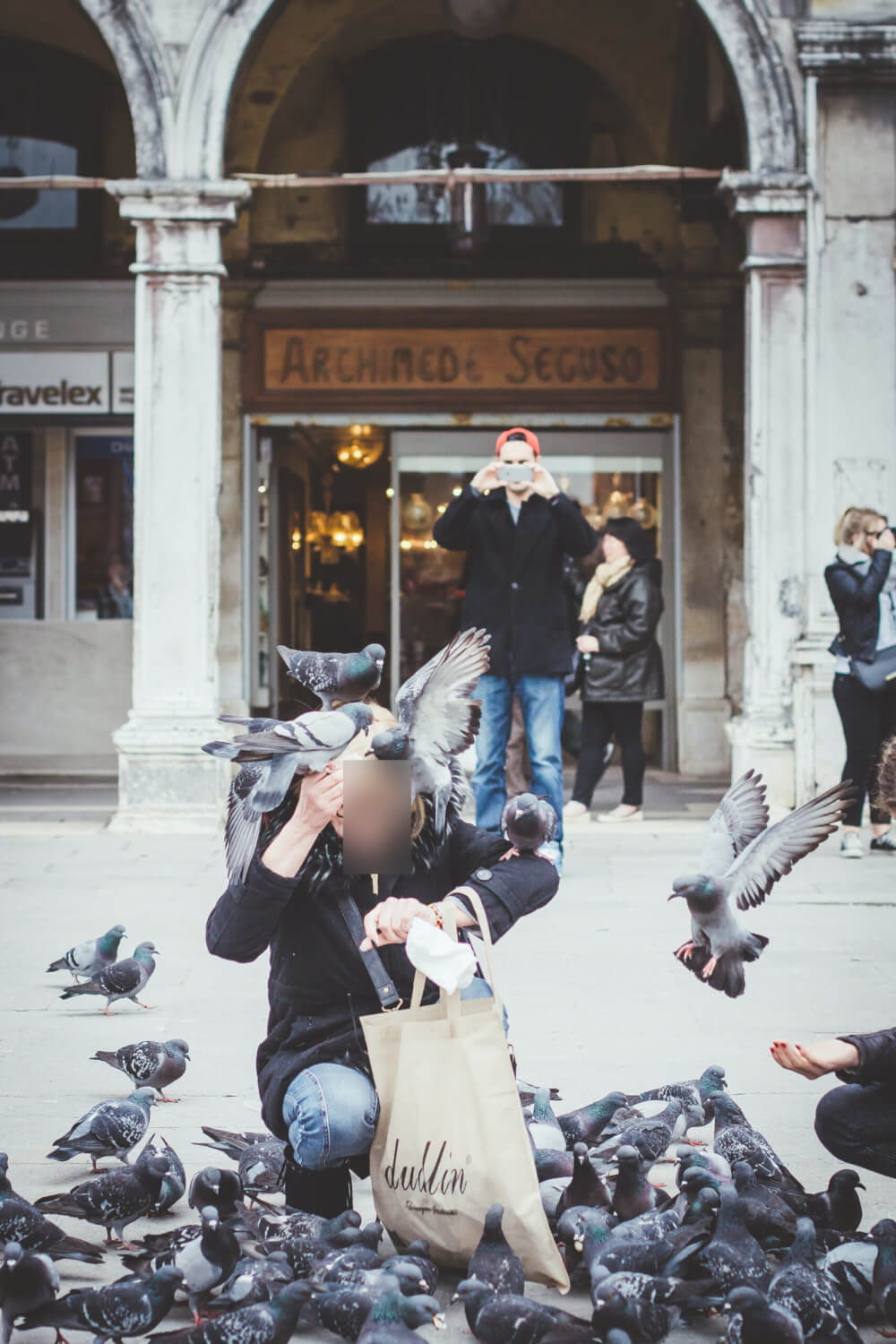
39. Don’t swim in or touch canal water
Speaking of gross, another Venice must know is that you should never under any circumstance touch the canal water or try to swim in it.
Not only is the water really dirty and often laced with sewage, it’s (also) a fineable offense of a few hundred euro.

40. Look for artisan shops to support
Another important Venice tip? When shopping for souvenirs, do go to small artisan shops rather than buy cheap copies from typical souvenir stalls.
Anywhere really close to big touristy squares or attractions are likely to have mass produced goods that aren’t of great quality. So, make sure you shop around for goods that are handmade – they’ll definitely last longer!
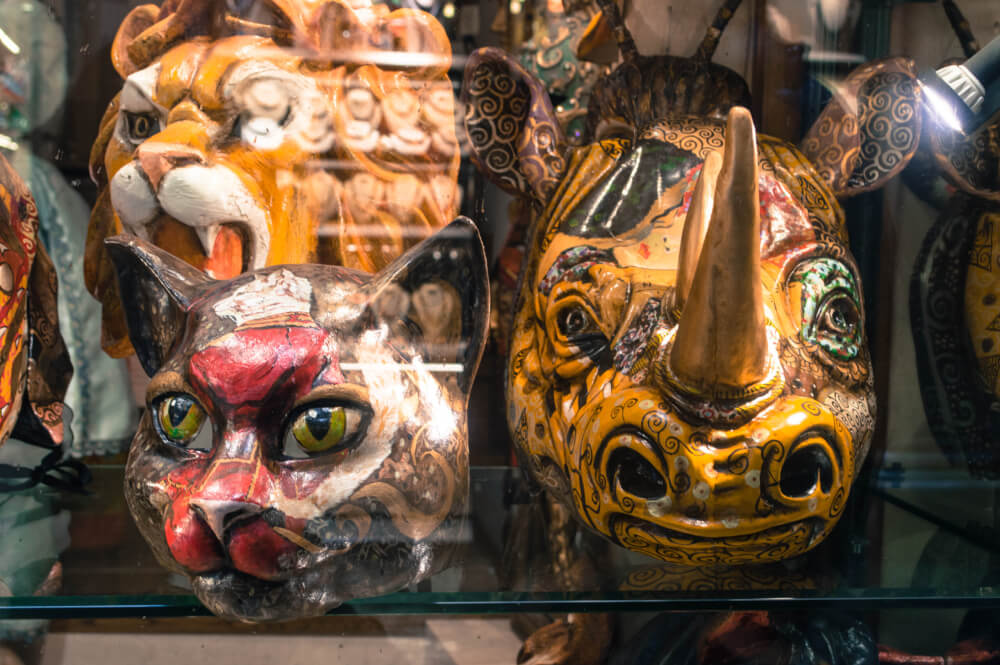
41. Don’t be tempted by the fake designer goods
On a similar note, you may see some people in Venice selling fake designer bags on the street.
Not only are these (of course) low quality copies, it’s also illegal in Italy to buy counterfeit goods, so beware of that.
NOTE: These salespeople can be very persistent, so the best course of action is to simply not engage at all.
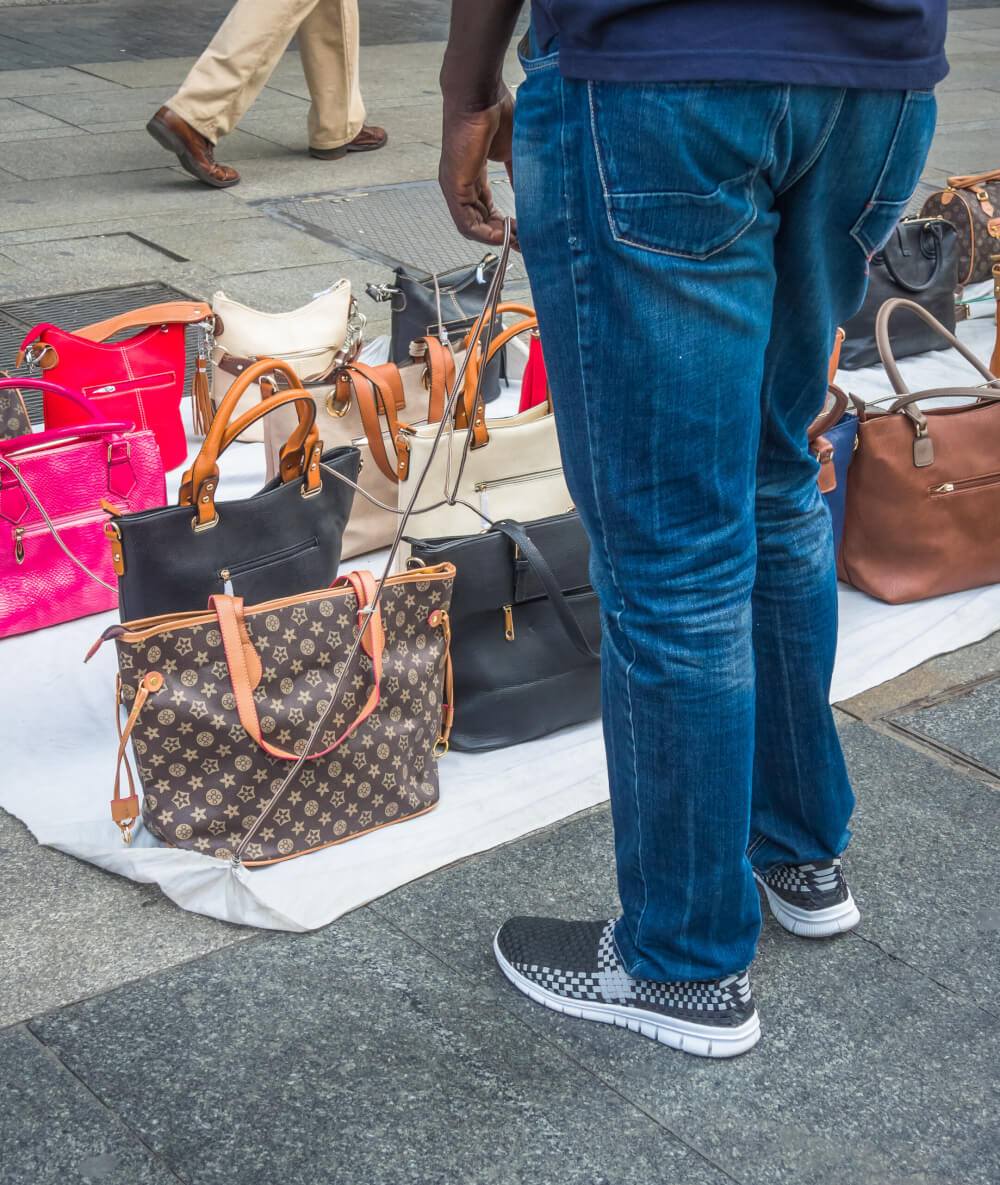
42. Don’t randomly stop to take photos and block the way
This can be very frustrating for everyone involved, so just be mindful that you’re not the only person in Venice and you should get out of the way if you want to stop for photos.

43. Do a day trip to the nearby islands in the Venetian lagoon
Lastly, if you have time, make sure you explore more of the Venetian Lagoon besides just Venice!
Burano for instance is this gorgeous rainbow island that is honestly one of the prettiest places I’ve ever been to. You can learn more about the best things to do in Burano in my full guide, or read my Venice to Burano guide for guidance.
There’s also the similarly named Murano, which is well known for its artisan glass production, as well as several more islands with their own draws, so be sure to leave some room in your itinerary for exploring further!
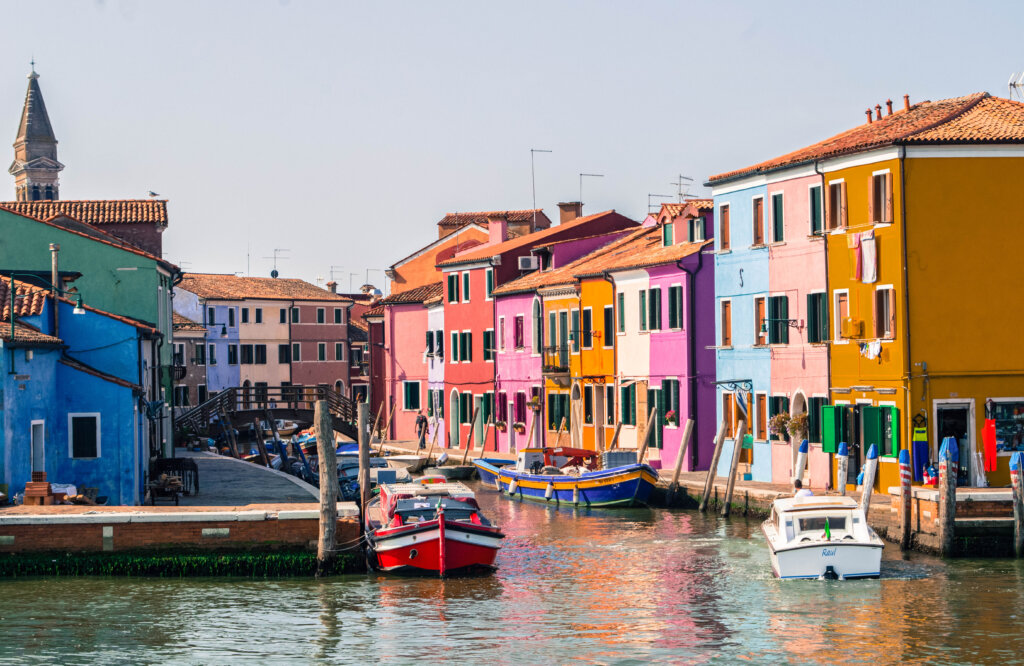
I hope you enjoyed those Venice travel tips!
Let me know in the comments if you have any more Venice must-knows to add. Safe and happy travels! 🙂
My Go-To Travel Favourites:
🧳 Eagle Creek: My favourite packing cubes
💳 Wise: For FREE travel friendly credit cards
🍯 Airalo: My go-to eSIM
🏨 Booking.com: For searching hotels
📷 Sony A7IV: My (amazing) camera
✈️ Google Flights : For finding flight deals
🌎 WorldNomads: For travel insurance
🎉 GetYourGuide: For booking activities
1 thought on “40+ Venice Travel Tips for First Timers & Must Knows Before You Go”
I’ve never been to Venice before, but it’s on my list for next year so I’ve been searching for first timers guides! Some super handy tips in here 🙂
C x Lux Life London
Leave a Comment Cancel reply
By using this form you agree with the storage and handling of your data by this website. *
Wanderlust Adventure

Best Time to Visit Venice: Unlocking the City’s Seasonal Charms
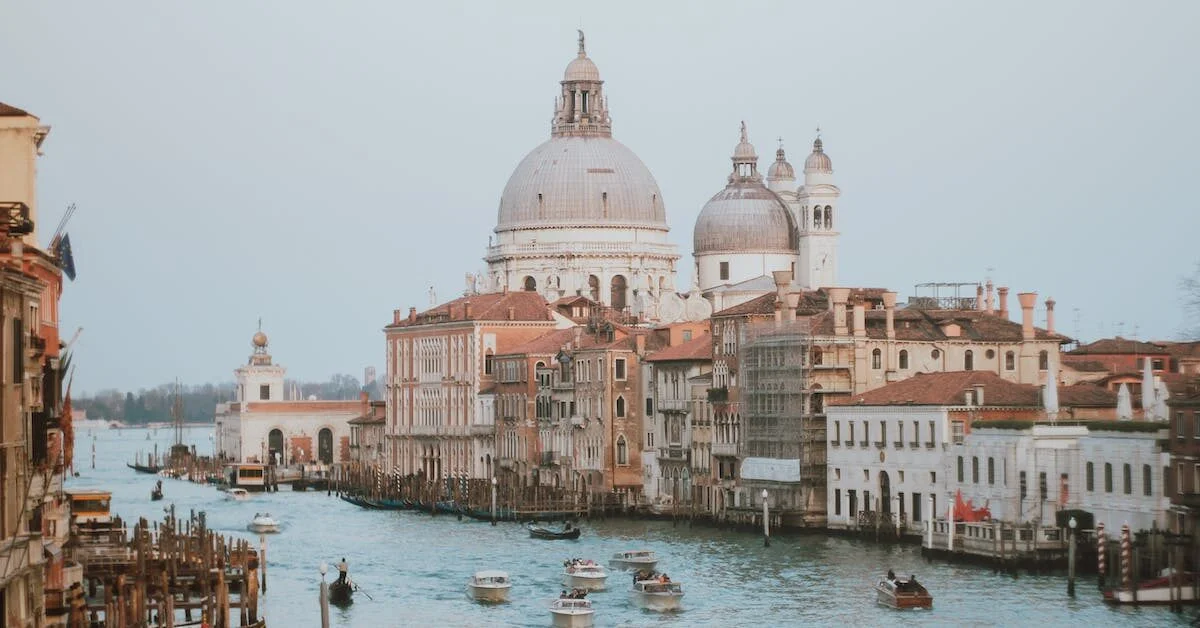
Venice, with its timeless allure as one of the most enchanting cities in the world, beckons travelers year-round. However, timing your visit can significantly impact your experience. This guide explores the best time to visit Venice, considering the city’s distinct seasons and the unique charm each one offers.
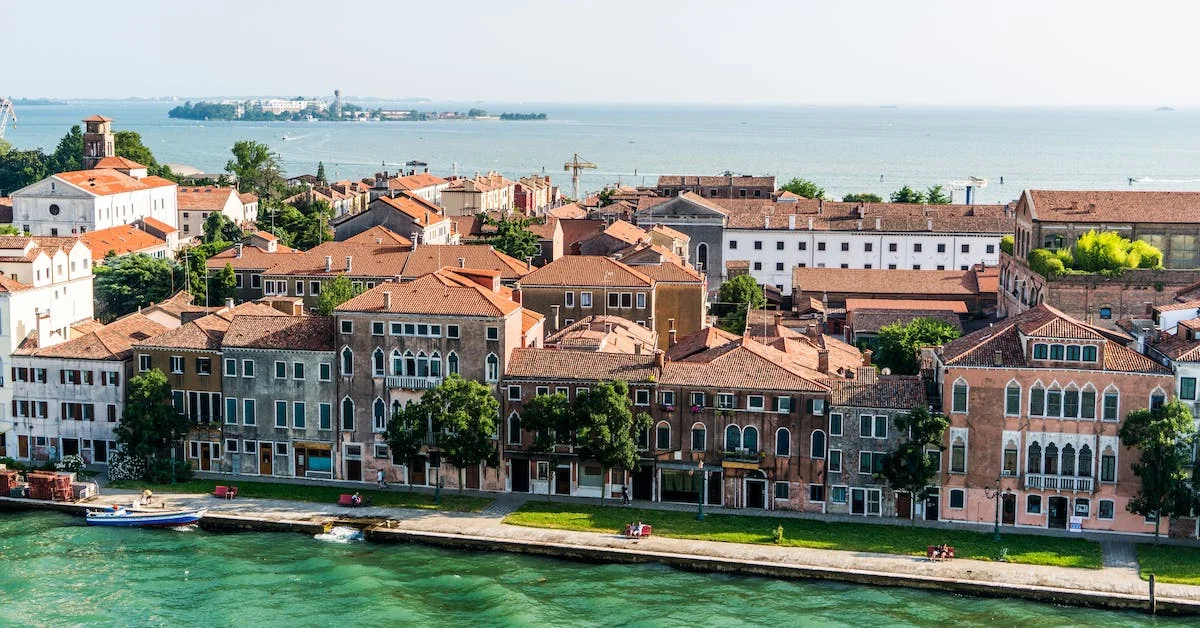
Seasons in Venice
Spring (march to may): .
Spring brings a delightful transformation to Venice. Temperatures are mild, ranging from 53°F to 75°F. While you’ll enjoy comfortable weather, be prepared for occasional rain showers. Spring is a time of renewal, with blossoming landscapes and fewer tourists. However, there’s a risk of flooding, known as “aqua alta.”
Summer (June to August):
Venice’s summer dazzles with its guaranteed sunshine, but it also sizzles with high temperatures, often soaring to 95°F. Swarms run to the city, transforming it into a clamoring center point of action. Cultural events and festivals, including the Carnival in February, lend a vibrant atmosphere to Venice.
Autumn (September to November):
Fall in Venice is a sweet spot between summer’s intensity and winter’s chill. The weather conditions stays charming with temperatures somewhere in the range of 59°F and 75°F, while the dampness melts away. Rainy days are frequent in the fall, but that’s a small trade-off for the local charm and fewer tourists.
Winter (December to February):
Winter bestows a unique and enchanting atmosphere on Venice. Expect cold temperatures averaging around 50°F, and don’t forget to pack your rain boots, as it’s the season of “acqua alta” or flooding. The city sees fewer tourists, lower hotel rates, and the chance to explore Venice like a local.
Best Months to Visit Venice
- The Ideal Months for Good Weather: April, May, June, July, August, September, and October are the best for good weather.
- The Warmest Months in Venice: June, July, and August, with temperatures reaching 95°F.
- The Coldest Month in Venice: January, where the average temperature drops to 33°F.
- Rainiest Months: May, June, and November, so be prepared for occasional downpours.
- Best Months for Swimming: June, July, August, and September offer pleasant sea temperatures.
Annual Weather and Climate Overview
Venice’s summer is hot and humid, with July and August often reaching temperatures around 95°F. The high humidity can make the atmosphere stifling, prompting locals to escape the city.
Fall is a pleasant season in Venice, with comfortable temperatures ranging from 59°F to 75°F. While occasional rain showers are common, it’s a quieter and more authentic time to explore.
Venice’s winter is characterized by cold temperatures (50°F) and the “acqua alta” or flooding season. However, it’s also a season of fewer tourists, lower hotel rates, and a unique, atmospheric experience.
Spring offers mild temperatures (53°F to 75°F), blooming landscapes, and fewer tourists. Still, be cautious of potential flooding.
Tourist Seasons in Venice
Peak visitor numbers: .
The highest tourist influx is in April, May, June, September, and October when Venice experiences its high season.
Off-Peak Tourist Season:
On the flip side, January, February, March, November, and December mark the low tourist season.
Best Time for Low Prices:
December is the month with the lowest hotel prices in Venice, while May is statistically the most expensive month for accommodations. To save money on flights, visit in January, and for car rentals, February is the most cost-effective.
Activities, Things to Do, Events, and Places to Explore
Venice is not just about picturesque canals and historic architecture; it offers a rich tapestry of experiences throughout the year.
Spring (March to May):
- The Venice Carnival: While the main Carnival events occur in February, echoes of this extravagant celebration linger into March. Marvel at the elaborate masks, elegant costumes, and the magical ambiance.
- Giardini Pubblici: As spring blossoms, the Giardini Pubblici gardens burst into color. A peaceful stroll amidst flowers and sculptures offers a serene escape from the city’s hustle.
- Biennale of Architecture: This biennial event, happening in odd-numbered years, brings contemporary architectural masterpieces to Venice. Explore avant-garde designs from around the world.
Summer (June to August):
- Venice Film Festival: The world-renowned Venice Film Festival lights up the city at the end of August or early September. Spot international stars and experience the glamour of the silver screen.
- Beach Time: Escape the city heat by heading to Venice Lido’s beaches. Partake in the sun, ocean, and sand, and cool off in the completely clear waters of the Adriatic.
- Acqua Alta Bookshop: Visit this unique bookstore in an old Venetian gondola. It’s an extraordinary place to pick up a book and witness the charm of Venice’s underwater culture.
Autumn (September to November):
- Festa del Redentore: The third weekend of July is when Venetians throw a massive party. Join in the festivities, watch fireworks, and celebrate with the locals.
- Enjoy Venetian Cuisine: Savor delicious autumn dishes, including squid ink risotto and Venetian tapas, cicchetti, in the city’s many bacari (wine bars).
- Art Biennale:In odd-numbered years, Venice has the renowned Workmanship Biennale, a global contemporary craftsmanship show that runs from early June to November.
Winter (December to February):
- Teatro La Fenice: Attend a world-class opera or ballet performance at Teatro La Fenice, a beautiful opera house steeped in history and elegance.
- Christmas Markets: Experience the magic of Venetian Christmas markets. Shop for unique gifts and try traditional festive treats.
- Explore the Jewish Ghetto: Venice’s Jewish Ghetto is a fascinating neighborhood to explore. Visit its historic synagogues, and enjoy traditional Jewish cuisine like pastries and kosher wines.
General Activities for All Seasons:
- Gondola Rides: No trip to Venice is complete without a gondola ride. Drift through serene canals and discover hidden corners of the city.
- Visit St. Mark’s Square: Marvel at the grandeur of St. Mark’s Square, home to St. Mark’s Basilica and the Doge’s Palace. It’s especially enchanting in the evening.
- Rialto Bridge: Cross the famous Rialto Scaffold and investigate the energetic Rialto Market, where you can buy new produce, Venetian luxuries, and gifts.
- Murano and Burano Islands: Take a vaporetto (water bus) to the nearby islands of Murano and Burano, known for their glassmaking and colorful houses, respectively.
Venice offers a different scope of exercises, occasions, and places to investigate consistently, guaranteeing that your visit is loaded up with extraordinary encounters.
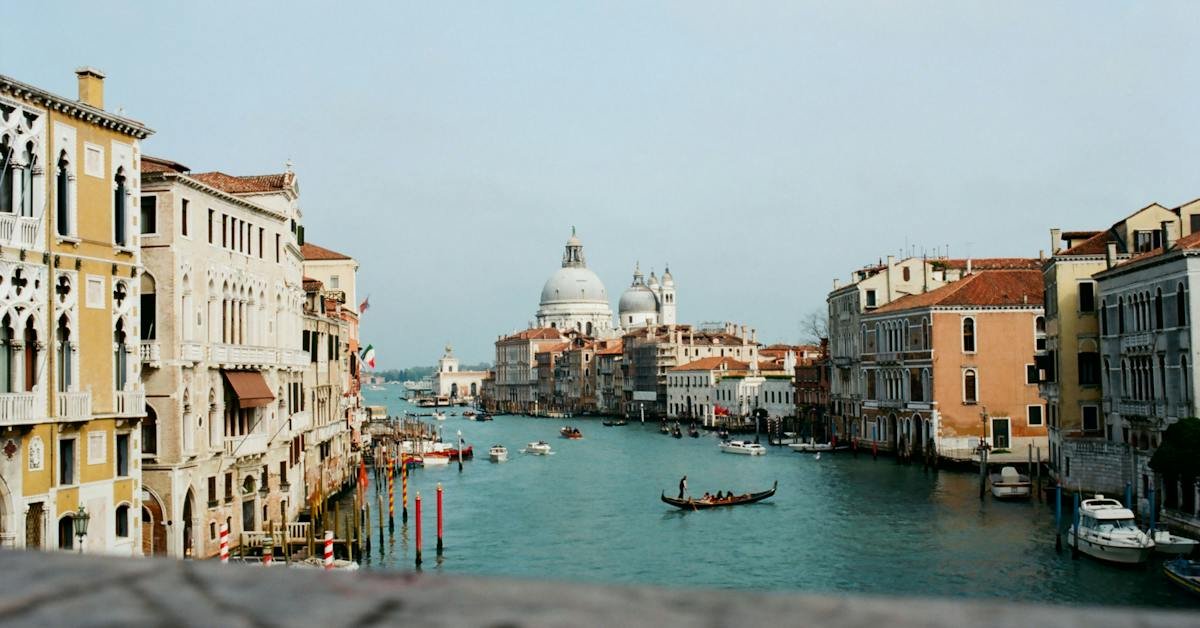
Monthly Breakdown: When to Visit Venice
Visiting Venice can be a unique experience depending on the month you choose. Here’s a month-by-month breakdown to help you plan your trip.
- Weather: January is the coldest month in Venice. Expect temperatures to hover around 42°F (6°C) during the day and 30°F (-1°C) at night.
- Tourist Volume: Venice experiences low tourist numbers in January, making it a tranquil time to explore the city.
- Events: You can enjoy the festive spirit lingering from the holiday season, and Venice’s churches host Epiphany processions and concerts.
- Activities: Wrap up warmly and explore the city’s historic sites and museums, such as St. Mark’s Basilica and the Doge’s Palace.
- Weather: February continues to be chilly with temperatures averaging around 46°F (8°C) during the day and 33°F (1°C) at night.
- Tourist Volume: Venice sees a slight increase in tourists due to the Carnival. It’s a vibrant and busy time to visit.
- Events: Venice Carnival (Carnevale di Venezia) is the highlight of the month with elaborate masquerade balls, grand parades, and festivities.
- Activities: Immerse yourself in the Carnival spirit, attend masked balls, and take part in this extravagant celebration.
- Weather: Spring begins, bringing milder weather. Expect daytime temperatures around 53°F (12°C) and nighttime temperatures around 48°F (9°C).
- Tourist Volume: Venice becomes quieter in March as Carnival festivities subside.
- Events: While no major events are held in March, it’s a perfect time to explore Venice without the crowds.
- Activities: Visit Giardini Pubblici, take peaceful gondola rides, and enjoy early springtime in Venice.
- Weather: April is delightful with daytime temperatures averaging 61°F (16°C) and nighttime temperatures around 46°F (8°C).
- Tourist Volume: Venice starts to welcome more visitors, but it’s not as crowded as the summer months.
- Events: The city enjoys a sense of renewal as flowers bloom. Easter events are celebrated with processions and church services.
- Activities: Explore Venice’s gardens, including the Biennale Gardens, and savor the blooming beauty of the city.
- Weather: May brings even warmer weather with daytime temperatures around 70°F (21°C) and nighttime temperatures near 54°F (12°C).
- Tourist Volume: Tourist numbers begin to rise in May, but it’s still a pleasant time to visit Venice.
- Events: Venice hosts the Feast of the Ascension (Festa della Sensa) in May, featuring a symbolic marriage of Venice to the sea.
- Activities: Enjoy pleasant weather for outdoor activities, and take boat rides to explore the surrounding islands.
- Weather: June marks the onset of summer with daytime temperatures around 76°F (24°C) and nighttime temperatures near 60°F (16°C).
- Tourist Volume: Venice sees a steady increase in tourists, especially as summer approaches.
- Events: Odd-numbered years feature the Venice Art Biennale, showcasing contemporary art from around the world.
- Activities: Explore art exhibitions, attend local festivals, and enjoy the beginning of summer in Venice.
- Weather: July is warm and sunny, with daytime temperatures averaging 81°F (27°C) and nighttime temperatures around 64°F (18°C).
- Tourist Volume: July is the start of the summer season, and Venice experiences a high influx of tourists.
- Events: Venice hosts the Festa del Redentore in mid-July, with fireworks and celebrations. The Venice Film Festival typically begins in late August or early September.
- Weather: August continues to be hot, with daytime temperatures around 80°F (27°C) and nighttime temperatures near 63°F (17°C).
- Tourist Volume: August is a peak tourist month, with many Europeans on summer holidays. It can get crowded.
- Weather: September offers a comfortable climate, with daytime temperatures around 74°F (23°C) and nighttime temperatures near 57°F (14°C).
- Tourist Volume: Tourist numbers start to taper off as summer winds down, making September an excellent time to visit.
- Events: The Venice Film Festival takes place at the end of August or early September.
- Weather: October is a transitional month with daytime temperatures averaging 64°F (18°C) and nighttime temperatures around 48°F (9°C).
- Tourist Volume: Tourist numbers continue to decline, offering a more serene experience.
- Events: Some restaurants and shops may close for a brief holiday, but it’s generally a quieter time for tourism.
- Activities: Enjoy the fall season, explore local markets, and witness the city’s transition to autumn.
- Weather: November is cooler, with daytime temperatures around 53°F (12°C) and nighttime temperatures near 44°F (7°C).
- Tourist Volume: Venice remains less crowded in November, making it an ideal time for a peaceful visit.
- Events: On November 21st, Venice celebrates the Festa della Salute with a temporary bridge over the Grand Canal leading to the Salute church.
- Activities: Take part in the local festival, explore Venice’s museums, and enjoy the fall ambiance.
- Weather: December can be cold, with daytime temperatures around 44°F (7°C) and nighttime temperatures near 32°F (0°C).
- Tourist Volume: While some tourists come to Venice to enjoy the festive atmosphere, it’s generally a quieter month for the city.
- Events: Venice is beautifully decorated for Christmas, with holiday markets and seasonal festivities.
- Activities: Embrace the Christmassy spirit in Venice, explore its stunning architecture, and enjoy cozy cafes.
This monthly breakdown provides a detailed guide for choosing the best time to visit Venice based on your preferences, whether you seek a bustling Carnival, a serene autumn, or a quiet winter retreat. Remember that Venice’s exceptional appeal can be appreciated all year, and each season offers something uniquely great to investigate.
Conclusion:
Timing your visit to Venice is crucial for experiencing the city’s distinct seasonal charms. The best time varies depending on your preferences, whether it’s embracing the summer bustle or savoring the tranquility of winter. Careful planning ensures an unforgettable Venetian adventure.
Read More : The Best Time to Visit Italy: Unveiling the Perfect Season to Explore La Dolce Vita
Venice is least crowded in January, making it an ideal time for a more peaceful visit with fewer tourists.
A 2-3 roadtrip is typically adequate to investigate the fundamental attractions in Venice. Nonetheless, on the off chance that you believe an all the more relaxed insight and wish should investigate the islands and unlikely treasures, a 4-multi day visit is suggested.
Venice can be enjoyable year-round, but it depends on your preferences. Summer offers warm weather and vibrant festivals but comes with more crowds. Winter provides a quieter experience with a festive atmosphere but cooler temperatures.
The most sweltering a very long time in Venice are June, July, and August, with normal temperatures stretching around 80-90°F (27-32°C).
Share your love
Related posts, discover the ideal seasons: best time to visit albania.
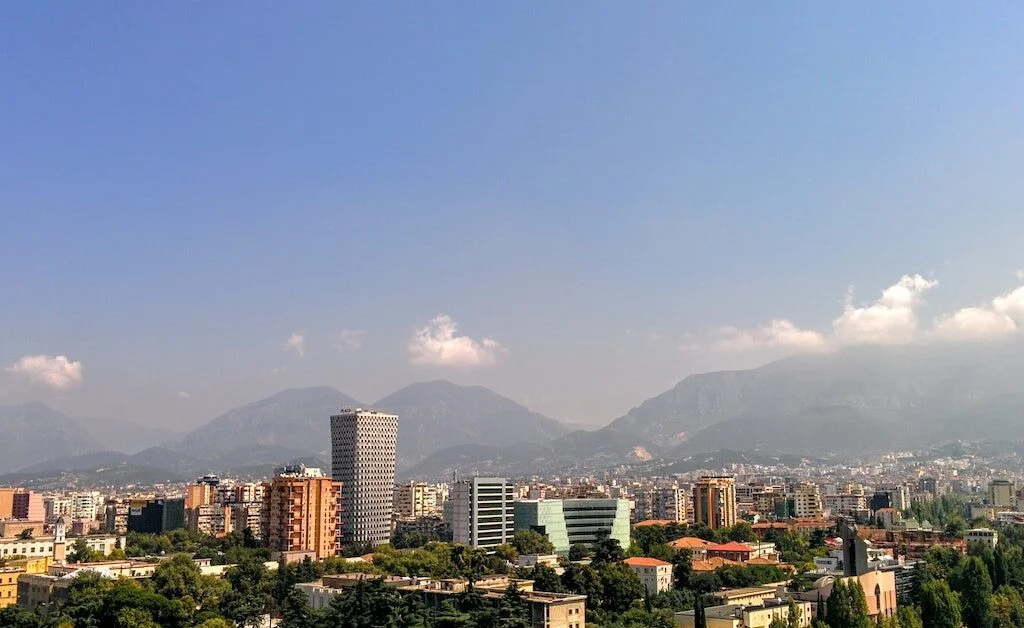
The best time to visit Spain: A Comprehensive Guide

Best Time to Visit Greece : A Comprehensive Guide
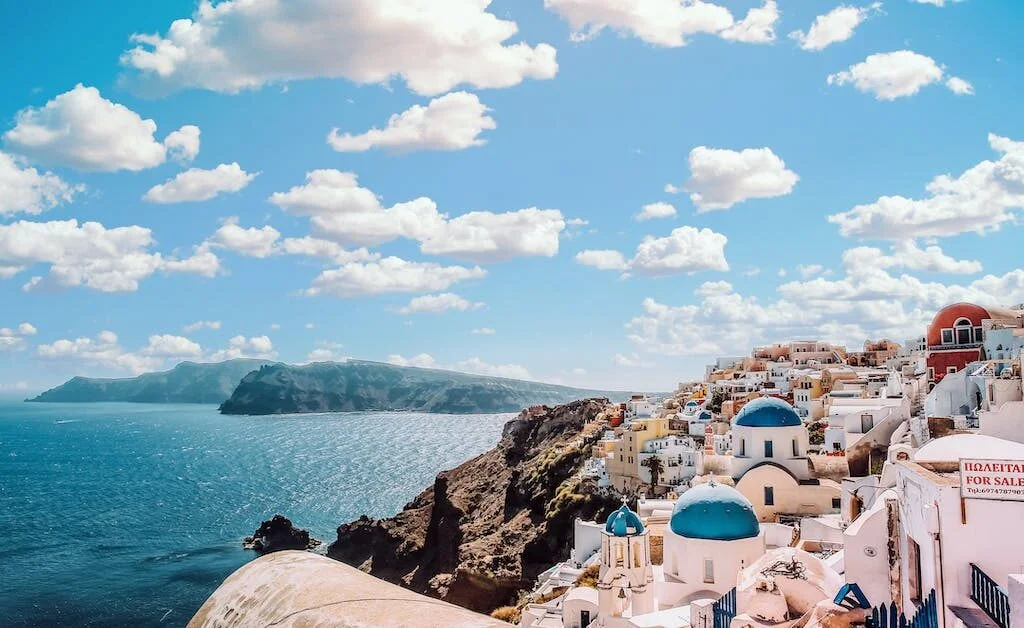
The Best Time to Visit Italy: Unveiling the Perfect Season to Explore La Dolce Vita
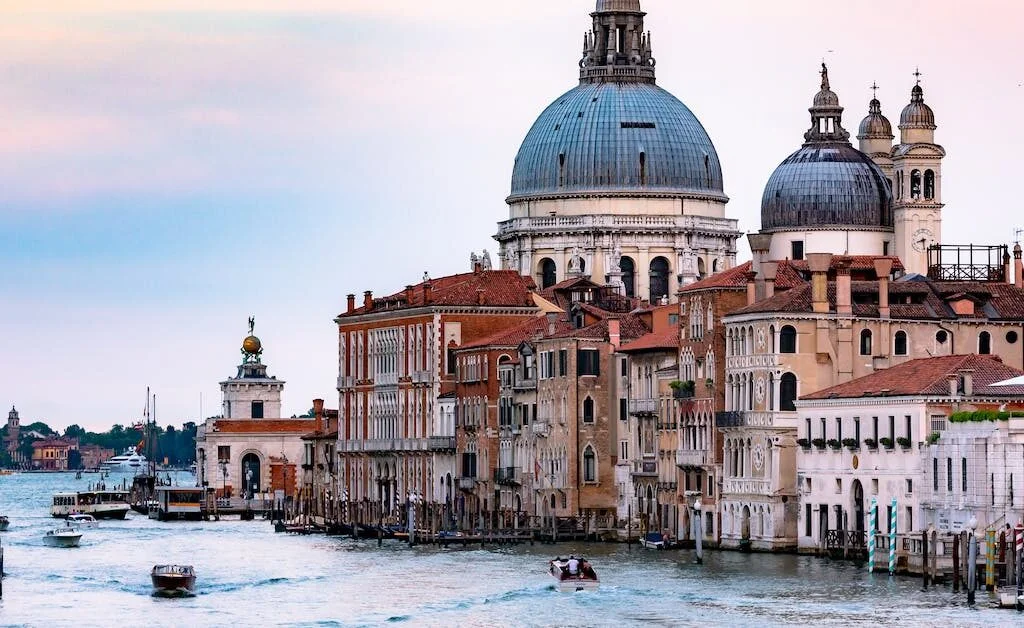
When to Visit Ibiza : Ideal Seasons

Best Time to Visit Lisbon, Portugal: Embracing the Seasonal Charms of the European Capital
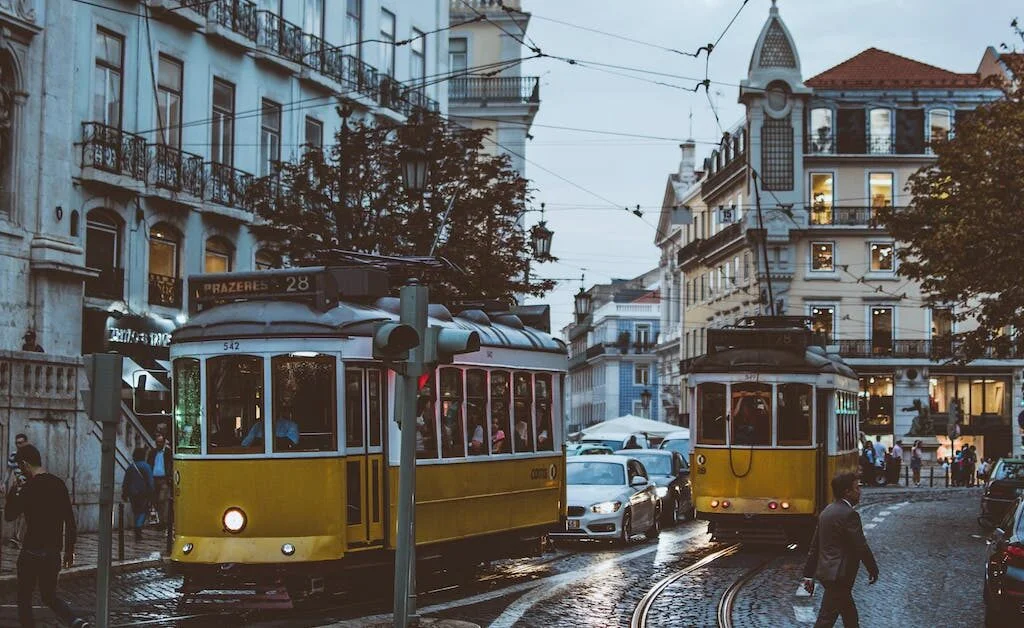
The Best Time to Visit Rome: Unlocking the Secrets
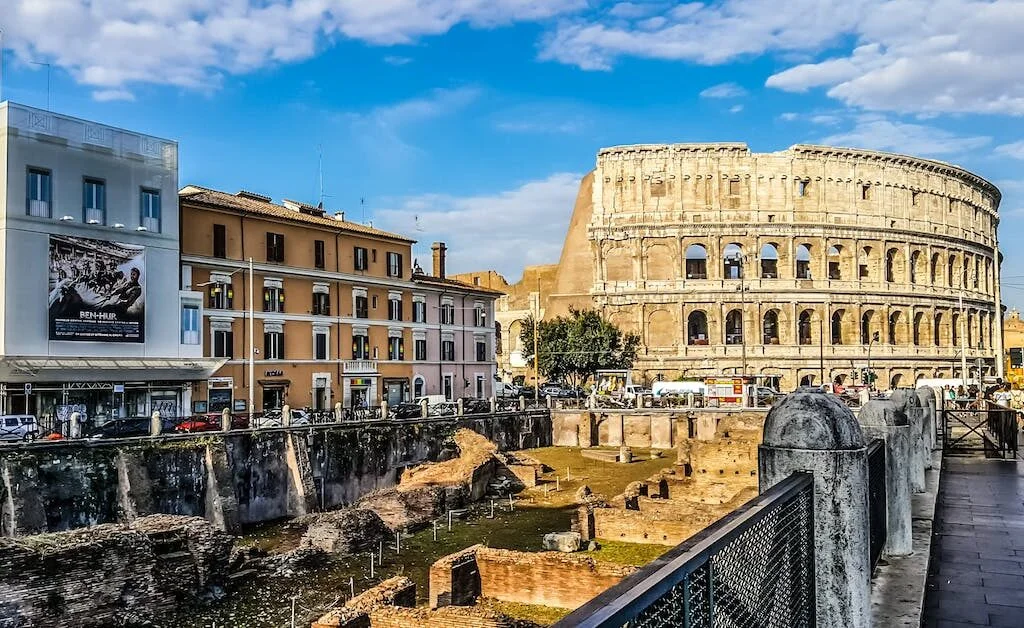
- Search Please fill out this field.
- Manage Your Subscription
- Give a Gift Subscription
- Newsletters
- Sweepstakes
- Travel Tips
The Best and Worst Times to Visit Italy
These are the best times to visit Italy for fewer crowds, travel deals, and more.
Rocky Casale is a freelance journalist with more than a decade of experience covering travel. His work has appeared in The New York Times , Vogue , The Wall Street Journal , Travel + Leisure , Condé Nast Traveler , Fodor's Travel , Afar , and more.
Elizabeth Rhodes is a special projects editor at Travel + Leisure , covering everything from luxury hotels to theme parks to must-pack travel products. Originally from South Carolina, Elizabeth moved to New York City from London, where she started her career as a travel blogger and writer.
:max_bytes(150000):strip_icc():format(webp)/elizabeth-rhodes-25083778bc654f69b30ce8417affc82c.jpg)
When you think of an Italian vacation, what comes to mind? Perhaps you picture Rome's historic attractions or Tuscany's vineyards — or maybe you prefer the picture-perfect Amalfi Coast or the iconic Venetian canals. No matter what part of Italy you want to visit, though, you'll need to know the best time to do it. Weather, crowd size, cost, and other factors can all influence your decision, but here's a basic breakdown of the Italian tourist seasons.
- High Season: May to September
- Shoulder Seasons: March to April and October to November
- Low Season: December to February
Below, we'll walk through the best (and worst) times to visit Italy for every type of vacation so you can start planning your next Italian getaway.
Best Times to Visit Italy for Smaller Crowds
Not too long ago, the busy season in Italy was confined to June, July, and August. Travelers flocked to the country during their summer holidays to enjoy good weather and a hearty dose of culture, and for the rest of the year, traffic would slow. Today, though, Italy is such an in-demand destination that its "high season" stretches all the way from May to September — and it seems to be getting longer every year.
Because of this, winter is the best time to avoid crowds. Many visitors to Italy are seeking a warm, sunny Mediterranean vacation, and the country's winter climate — with temperatures in the 40s and 50s in the south and snowy conditions in the north — isn't conducive to those plans. Unless you're headed to an Alpine ski town like Cortina D'Ampezzo, a winter trip to Italy will likely mean uncrowded hotels and piazzas with plenty of elbow room.
Chelsea Exton/Travel + Leisure
Best Times to Visit Italy for Good Weather
"Good weather" in Italy is another concept that's evolved in recent years. Certainly, sun-seeking travelers will still find plenty to enjoy in Italy's warm, largely rain-free summers — but soaring temperatures can make July and August uncomfortable in some regions. Temperatures above 100 degrees are increasingly frequent in southern cities like Rome and Naples, so heat-sensitive travelers may want to avoid the peak of summer in these areas.
For sunny skies and balmy beaches without sky-high heat indices, the best times to visit Italy are the late spring and early fall. Months like May and September offer temperatures in the 70s and 80s through much of the country's south, making conditions ideal for sunbathing, swimming, and taking walking tours through historic towns and cities.
In northern Italy, conditions typically remain pleasant for the duration of the summer, particularly if you're near water or at a high elevation. A getaway to Venice or Lake Como, for instance, can see temperatures in the 60s and 70s even during June, July, and August.
Michela Sieman/Travel + Leisure
Best Times to Visit Italy by Region
Best times to visit the italian coast.
Spring, summer, and autumn are often heralded as the best times to visit Italy, particularly in temperate coastal towns where extreme weather isn't a concern. The problem with late spring and summer, though, is that everyone has the same idea (including Italians with second homes by the sea). Umbrella and beach chair rental prices are exorbitant, and the beaches can get crowded and noisy. Look instead to smaller villages near the sea, like Terlizzi in Puglia, where the water remains warm through late October and nearby beaches are quiet.
Best Times to Visit Italy's Wine Country
Early spring and early fall can be ideal times to visit Italy if you hope to explore wine regions like Tuscany. The grape harvest occurs each September and October (exact dates vary from year to year), so this can be a fun time for wine lovers.
Best Times to Visit the Dolomites
If you dream of seeing the stunning Dolomites in northeastern Italy, we have good news. The destination is worth visiting year-round, depending on your interests. Hit the ski slopes in winter, or spend spring and summer days hiking and taking in the mountain views.
Best Times to Visit Italy for Lower Prices
Prices in Italy tend to move in tandem with the seasons: when there are lots of visitors, prices are high, and when tourist numbers taper off, so do the costs of airfare and accommodations. If you hope to score a deal on flights or hotel rooms, aim for the off-season of October to April. This is especially true in popular cities like Rome and Florence. While these metro areas can be pricey and packed at any time, things do slow down in winter.
Of course, there are other ways to save money on your Italian vacation besides just aiming for the off-season. Keep an eye out for flight deals, or check out cruise packages that can help you avoid expensive hotels and flights. Finally, consider traveling off the beaten path to the small towns and quaint villages that most tourists skip — even during busy periods, these can make for affordable vacations.
Worst Times to Visit Italy
Italy is a beautiful destination year-round, but if you want to avoid packed tour buses, long museum lines, and extreme heat, you probably don't want to plan a summer getaway to Rome, Venice, or Florence. Carnival season — typically February and March — is another less than ideal time in Venice if you aren't a fan of crowds. Hotels are at a premium, and the city's bridges, boats, and attractions may lose their charm as they fill with thousands of mask-wearing revelers. For a calmer version of Venice, the northern lagoon in November is sublime.
Tuscany can also be a tricky region for solitude-seeking travelers, given its mass popularity. Cities like Siena and medieval hilltop towns like San Gimignano can be full of tourists in the summer and autumn, so try planning your trip for the winter or spring to see slightly smaller crowds.
No matter where you're going, be sure to take note of any major local holidays planned during the dates of your visit. For example, Christmas is a beautiful time to explore Italy thanks to charming holiday markets and festive decor, but some shops and attractions will be closed or have restricted hours around the holiday. Easter pilgrimages, meanwhile, are beloved among Catholic travelers wanting to see the Vatican — but their popularity also means that prices will be higher and crowds larger during Holy Week than during the rest of the spring.
Related Articles
Pay to enter: Venice becomes the first city to implement a tourist ticket system
Venice became the first city in the world on Thursday to introduce a payment system for visitors in an experiment aimed at dissuading tourists from arriving during peak periods.
However, it isn't the only place in Italy that has recently introduced new measures aimed at slowing tourist flows.
Here are some of the initiatives currently in force.
Venice tourist tax
The lagoon city has introduced 5 euros (about $5.35) tickets for day trippers, valid from 8:30 a.m. to 4 p.m. The experiment came into force on April 25, a national holiday in Italy. Tickets will be needed for the following 10 days and thereafter for most weekends until mid-July.
Venice residents, students, workers, and homeowners are exempt from paying or booking a slot. Visitors aged under 14 and tourists with hotel reservations will need to register, but access for them will be free of charge.
Other cities, such as Como, have said they are considering introducing a similar measure but are waiting to see how the Venice initiative works before deciding.
In addition, Venice has said that from June, it will limit the size of tourist groups to 25 people and ban the use of loudspeakers by tour guides.
Florence tourist measure
Florence announced in October that it was banning new short-term residential lets on platforms such as Airbnb in its historic center. It also offered three years of tax breaks to landlords of short-term holiday lets who start offering ordinary leases for residents.
The city's famous museum, the Uffizi, offers discounts to people who arrive before 8.55 a.m. and lower prices off-season. To spread out crowds, it also closes at 10 p.m. once a week.
Cinque Terrer overtourism
The five villages that make up the Cinque Terre on the Italian Riviera regularly get swamped with visitors.
To try to reduce the overcrowding at peak periods, the authority which oversees the area said this week it would charge visitors 15 euros (about $16) to walk the most celebrated coastal path. In addition, the path can only be walked in one direction.
Capri tourism measure
The picturesque small island that lies across the bay from the southern city of Naples has doubled its entry fee, which is automatically added to ferry tickets, to 5 euros. The fee will be charged from April 1 to October 1.
Capri, Ischia, Procida, Lampedusa and Linosa changes
These islands have introduced limits, or outright bans, on cars for non-residents during the main tourist season.
- International edition
- Australia edition
- Europe edition
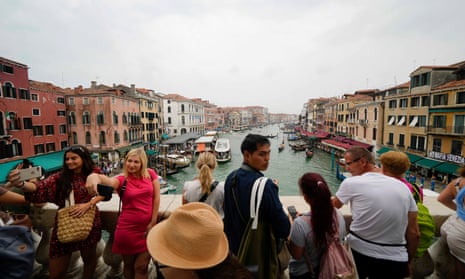
Venice access fee: what is it and how much does it cost?
The Italian Unesco site is hoping to reduce over-tourism with the charge – the first of its kind in a major city
After years in the making, Venice will on Thursday begin charging day trippers to enter the city in an effort to protect the Unesco world heritage site from the effects of over-tourism.
While the measure has ignited criticism and derision from some, who argue it is unconstitutional and restrictive of freedom of movement – the Venice mayor, Luigi Brugnaro, has compared his “bravery” in enacting the charge to that of the Venetian explorer Marco Polo, in daring to go where others have feared to tread.
In some ways this is true: Venice will become the first major city in the world to adopt such an initiative, and others grappling with the impact of mass tourism are keenly observing.
However, will this bold experiment work in practice? Will it help save Venice, a uniquely beautiful city that campaigners have warned for decades is in peril? And – most importantly, perhaps, for anyone looking to book their trip – how do you buy your tickets?
Why is this being introduced?
According to Simone Venturini, the city’s councillor for tourism, Venice “affixed itself” to mass tourism in the 1960s and since then visitor numbers have surged to the point that during the busiest periods of the year it attracts an average of 40,000 people a day.
That number has put pressure on the fragile lagoon, while pushing residents away from the main island. Brugnaro said he wanted to make Venice “livable” again.
However, the final push to enact the measure came after Unesco threatened last year to put Venice on its list of heritage sites in danger, citing mass tourism and rising water levels attributed to climate change.
While Venice has moved to counter mass tourism in recent years by banning huge cruise ships from chugging through its centre, the city only escaped the potential shame of losing its Unesco status after the access charge was agreed.
How much is the charge and who has to pay?
The “Venice access fee” costs €5 (£4.30). It could be worse – when the idea was first suggested it was €10. Only day trippers have to pay. Residents, commuters, students and children under 14 are exempt, as are tourists who stay overnight. Critics of the scheme say the €5 is unlikely to deter many people.
How do I buy a ticket, and on which dates is one required?
The tickets are bookable online and apply on 29 peak dates between 25 April and 14 July. The dates are listed on the site. You will be provided with a QR code on your phone – guard it as this is the proof that you have paid the fee.
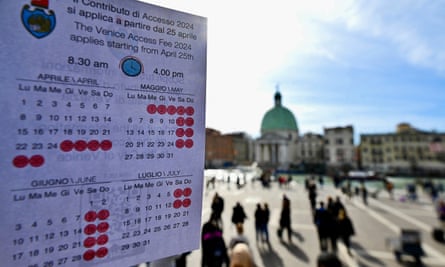
Hang on, Venice is a massive place with dozens of islands. Where exactly does it apply?
The charge applies only to those entering the historic centre of Venice between 8.30am and 4pm on any of the peak dates. That includes the Rialto Bridge, St Mark’s Square, La Fenice opera house and many other top-drawer tourist attractions, as well as quieter neighbourhoods such as the island of Giudecca.
What if I arrive in Venice without the QR code or I don’t have access to a mobile phone?
Fear not. When you arrive in Venice, says the council, be it by train, bus, or boat, stewards wearing white bibs featuring the city’s logo will guide you through buying the ticket online and downloading the QR code.
Those without a phone can pay at water taxi stations or in tabacchi shops, Venturini says.
The five key entrance points are Venezia Santa Lucia train station, bus terminals at Piazzale Roma and Tronchetto, and vaporetti (water bus) stops at Zattere and the Riva degli Schiavoni, the waterfront that covers the entrance to St Mark’s Square.
How will the measure be implemented?
Brugnaro has promised the system will be imposed with “very soft controls” and “without queues”, rejecting speculation the city would be installing barriers or turnstiles in the streets.
In effect, the authorities hope the measure will be implemented by means of a fleet of 180 personnel, made up of volunteer stewards, council staff and public officials. Those wearing white bibs are there to inform, while those wearing yellow bibs are there to do random checks and have the power to issue fines for those without a QR code.
Venturini said that if you arrived without one and did not approach someone in a white bib for information, and you were then spot-checked by someone in a yellow bib, you would risk being fined.
And how bad are the penalties?
Fines range from €50 to €300. “Don’t worry, nobody will be arrested for not having paid the fee,” said a council spokesperson.
- Climate crisis
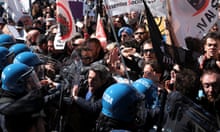
‘Recipe for disaster’: Venice entry fee sparks confusion and protest on day one

‘Are we joking?’: Venice residents protest as city starts charging visitors to enter

Europe: Venice residents protest as city begins visitor charging scheme – as it happened
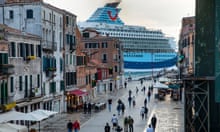
Venice mayor says he is brave like Marco Polo in charging day-trippers €5

Venice to limit tourist group size to 25 to protect historic city

Venice gondola capsizes after tourists refuse to sit down and stop taking selfies

Venice to trial €5 ticketing system for day visitors from 2024

I took my mum to Venice – it was instantly special
Most viewed.
- Skip to main content
- Keyboard shortcuts for audio player
Venice tests a 5-euro fee for day-trippers as the city grapples with overtourism
The Associated Press

Stewards check tourists' QR code access outside the main train station in Venice, Italy, on Thursday. Luca Bruno/AP hide caption
Stewards check tourists' QR code access outside the main train station in Venice, Italy, on Thursday.
VENICE, Italy — Under the gaze of the world's media, the fragile lagoon city of Venice launched a pilot program Thursday to charge day-trippers a 5-euro (around $5.35) entry fee that authorities hope will discourage visitors from arriving on peak days and make the city more livable for its dwindling residents.
Visitors arriving at Venice's main train station were greeted with large signs listing the 29 dates through July of the plan's test phase that also designated separate entrances for tourists, and residents, students and workers.

Venice will limit tour groups to 25 people and ban loudspeakers to control tourism
"We need to find a new balance between the tourists and residents,'' said Simone Venturini, the city's top tourism official. "We need to safeguard the spaces of the residents, of course, and we need to discourage the arrival of day-trippers on some particular days."
Not all residents, however, are persuaded of the efficacy of the new system in dissuading mass tourism , insisting that only a resurgence in the population will restore balance to a city where narrow alleyways and water buses are often clogged with tourists.
Hundreds of Venetians protested against the program, marching festively though the city's main bus terminal behind banners reading "No to Tickets, Yes to Services and Housing." Protesters scuffled briefly with police with riot gear who blocked them from entering the city, before changing course and entering over another bridge escorted by plainclothes police. The demonstration wrapped up peacefully in a piazza.

Citizens and activists stage a protest against Venice Tax Fee in Venice on Thursday. Luca Bruno/AP hide caption
Citizens and activists stage a protest against Venice Tax Fee in Venice on Thursday.
Tourists arriving at the main station encountered almost as many journalists as stewards on hand to politely guide anyone unaware of the new requirements through the process of downloading the QR code to pay the fee.
Arianna Cecilia, a tourist from Rome visiting Venice for the first time, said she thought it was "strange" to have to pay to enter a city in her native country, and be funneled through separate entrance ways for tourists. She and her boyfriend were staying in nearby Treviso, and so downloaded the QR code as required, but she was still caught off-guard while soaking in her first view ever of Venice's canals by the sight of the entrance signs and her boyfriend telling her to get out the ticket.
On the other side of the entrance ways, workers in yellow vests carried out random checks at the train station. Transgressors faces fines of 50 to 300 euros ($53 to $320), but officials said "common sense" was being applied for the launch.

With Waters Rising And Its Population Falling, What Is Venice's Future?
The requirement applies only for people arriving between 8:30 a.m. and 4 p.m. Outside of those hours, access is free and unchecked.
Venice has long suffered under the pressure of overtourism, and officials hope that the pilot project can help provide more exact figures to better manage the phenomenon.
The city can track the number of hotel visitors, which last year numbered 4.6 million and is down 16% from pre-pandemic highs. But the number of day visitors, which make up the majority of the crowds in Venice, could only be estimated until recently.

Stewards check a tourist's QR code access outside the main train station in Venice. Luca Bruno/AP hide caption
Stewards check a tourist's QR code access outside the main train station in Venice.
A Smart Control Room set up during the pandemic has been tracking arrivals from cellphone data, roughly confirming pre-pandemic estimates of 25 million to 30 million arrivals a year, said Michele Zuin, the city's top economic official. That includes both day-trippers and overnight guests.
But Zuin said the data is incomplete.
"It's clear we will get more reliable data from the contribution" being paid by day-trippers, he said.
Venturini said the city is strained when the number of day-trippers reaches 30,000 to 40,000. On peak days, local police set up one-way traffic for pedestrians to keep the crowds moving.
Residents opposing the day-tripper tax insist that the solution to Venice's woes are to boost the resident population and the services they need, limiting short-term rentals to make available more housing and attract families back from the mainland.
Last year, Venice passed a telling milestone when the number of tourist beds exceeded for the first time the number of official residents, which is now below 50,000 in the historic center with its picturesque canals.

Venice mayor calls out 'imbeciles' surfing Italian city's historic canals
"Putting a ticket to enter a city will not decrease not even by one single unit the number of visitors that are coming,'' said Tommaso Cacciari, an activist who organized a protest Thursday against the measure.
"You pay a ticket to take the metro, to go to a museum, an amusement park. You don't pay a ticket to enter a city. This is the last symbolic step of a project of an idea of this municipal administration to kick residents out of Venice," he said.
Venice officials expected paid day-tripper arrivals Thursday to reach about 10,000. More than 70,000 others had downloaded a QR code denoting an exemption, including to work in Venice or as a resident of the Veneto region. Hotels in Venice, including in mainland districts like Marghera or Mestre, should provide a QR code attesting to their stay, which includes a hotel tax.
Venturini, the tourist official, said that interest in Venice's pilot program has been keen from other places suffering from mass tourism, including other Italian art cities, and municipalities abroad such as Barcelona, Spain, and Amsterdam.
But Marina Rodino, who has lived in Venice for 30 years, doesn't see the fee as the cure-all. Neighboring apartments in her residential building near the famed Rialto Bridge once inhabited by families are now short-term apartment rentals.
The corner butcher shop closed. Yet she noted that the new entrance fee requirement will still allow young people to flood the city in the evening for the traditional aperitivo, which can grow rowdy.
She was passing out mock European Union passports for "Venice, Open City," underlining the irony of the new system, and challenging its legal standing with citations from the Italian Constitution guaranteeing its citizens the right to "move or reside freely in any part of the national territory."
"This is not a natural oasis. This is not a museum. It is not Pompeii. It is a city, where we need to fight so the houses are inhabited by families, and stores reopen. That is what would counter this wild tourism,'' Rodino said.
- Share full article
Advertisement
Supported by
What to Know About Venice’s Fees for Day Trips
Venice is trying to mitigate overtourism with a small fee on busy days. City leaders hope it will make visitors more aware of the city’s fragility.

By Elisabetta Povoledo
Reporting from Rome
After years of debate , Venice on Thursday began charging day visitors five euros to visit its fragile historic center on peak days, making it the first city in the world to adopt such a measure to counter overtourism.
Critics question whether a nominal fee will put people off from visiting one of the world’s most desired destinations. But officials hope that it might encourage some to rethink their plans and decide to come on weekdays or in the off-season.
That might help mitigate the impact of the estimated 20 million visitors who descended last year on the city’s beleaguered residents, who number fewer than 50,000, according to municipal statistics . About half of those visitors came only for the day, city officials said. Overnight guests are exempt from the fee.
The spirit of the initiative, city officials have said, is to make people aware of the uniqueness — and fragility — of Venice. Overtourism is creating an economy solely based on tourism that risks killing the city by pushing its dwindling residents out, said Nicola Camatti, an economics professor and expert in tourism at Ca’ Foscari University of Venice.
When will Venice start charging?
The fee went into effect on Thursday, a holiday in Italy. For 2024, city officials have singled out 29 peak days when single-day travelers in Venice between 8:30 a.m. and 4 p.m. have to pay. The days run until mid-July and are mostly on national holidays and weekends. The access-fee website provides a list of the dates.
Who must pay?
While just about everyone visiting the city has to register to obtain a QR code, not all visitors have to pay the fee. Overnight guests at registered accommodations like hotels or Airbnbs are exempt, because they already pay a daily tourist tax, as are people who study or work in Venice and those visiting relatives. There are other exemptions as well.
Residents of Venice, those born there and minors under 14 are among those who do not have to register. But they must have documents that prove their status.
It is possible that different fees will apply next year on a sliding scale that will depend on how many people city officials expect on any one day. City officials said the fees could be as high as 10 euros per day.
How will the system work?
Before coming to Venice on peak days, visitors should use the website to register and get a QR code.
The code will be scanned at points where visitors enter, like the train station, the city parking lot, the airport and the sprawling waterfront along the San Marco basin where boats dock. The access points will have one line for tourists and another for residents and what officials call city users, who are coming into Venice for reasons other than sightseeing.
At least for now, those who do not register ahead of time can do so at some access points or on their cellphones, officials said. Assistants will be available.
Initially, the controls will be “very soft,” said Michele Zuin, the municipal councilor responsible for the city’s budget.
Speaking to reporters at the foreign press association in Rome this month, Mayor Luigi Brugnaro said the fee was not about cashing in on tourists. “The costs of the operation are higher than what we’re going to make,” he said.
Why is Venice doing this?
City officials hope to relieve some of the stress that tourists put on the city by encouraging them to come on less busy days. They also say that by knowing ahead of time how many visitors to expect, the city can better deploy services.
“We want to better manage the numbers of tourists and disincentivize mass tourism” that makes it difficult for residents and visitors to “live in this city,” Mr. Zuin said this month.
To track the flow of visitors, the city already monitors them via phone location data and surveillance cameras, a system some critics have likened to Big Brother .
Venice has also fallen under the scrutiny of the United Nations’ culture agency, UNESCO, whose experts are concerned that not enough is being done to protect the city. Last year, Venice risked being added to UNESCO’s list of Endangered World Heritage Sites after experts at the agency listed mass tourism , along with climate change and development, as a major threat to its future. It urged City Hall to take steps to ameliorate the damage.
The municipal council approved the access fee just days before UNESCO was to vote on its status, and Venice stayed off the “in danger” list . But UNESCO officials said in a statement that “further progress still needs to be made” to conserve Venice.
Critics of the access fee note that officials have not capped the number of visitors, and they say that the nominal fee is hardly a deterrent. As recently as Friday, city officials said that about 80,000 visitors swelled the city’s narrow calli, as the streets are known, and the gardens of the 2024 Venice Biennale , still the world’s principal place to discover new art .
How else is Venice trying to restrict visitors?
Venice also has taken other steps it hopes will reduce what city officials call “mordi e fuggi” tourism, or “eat and flee,” referring to those who seek the city’s greatest hits — the Rialto Bridge and St. Mark’s Square — and who bring packed lunches and dump their garbage, contributing little to the local economy.
After years of heated debate and protests by vocal Venetians, the city banned cruise ships from its inner canals in 2021 , though Mr. Camatti, the tourism expert, said the ban on the ships had not reduced the number of day visitors.
This year, the city imposed a limit of 25 people per tour group and also banned the use of megaphones.
Elisabetta Povoledo is a reporter based in Rome, covering Italy, the Vatican and the culture of the region. She has been a journalist for 35 years. More about Elisabetta Povoledo
Venice launches world first tourist entrance fee in bid to fight overcrowding
VENICE, Italy — Ancient and beautiful, this city is sometimes referred to as an open air museum — and now visitors to Venice will have to pay an entry fee after the tourist hub on Thursday became the first in the world to introduce a charging system for day-trippers.
In a bid to thin out the crowds that throng to see the canals, bridges and striking architecture during vacation season, day-trippers will have to pay 5 euros ($5.35) to enter the lagoon city on 29 peak days, mostly on weekends, as part of a trial phase until July 14.
Tourists who have booked at least one night at a hotel in the city will be exempt from the charge, as will residents, workers and students in the city. Visitors under age 14 will also be exempt. But like the day-trippers, they will also have to ensure they have registered online and received QR codes.
Those without smartphones will have to go to the city’s Santa Lucia train station to buy tickets.
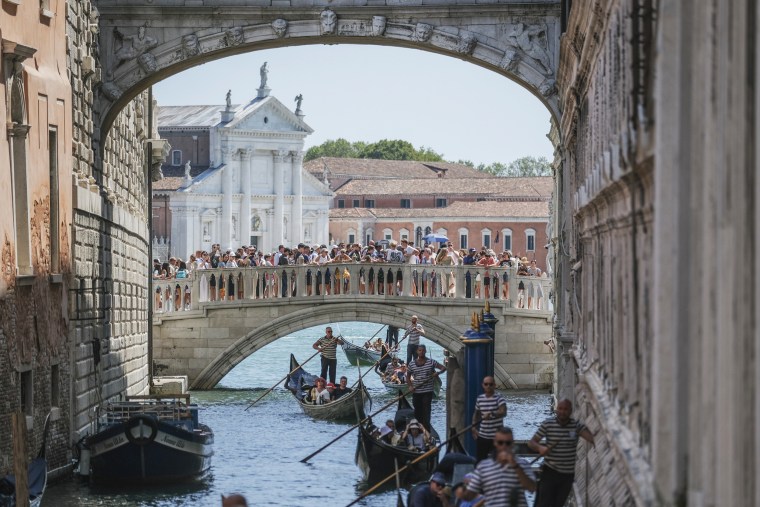
Among the thousands of people lining up at the station for a ticket Thursday was Donna Porter-Mutchler, a tourist from Tennessee, who told NBC News she thought the charge was “a wonderful idea.”
“Venice deserves to be taken care of,” she said. “I think it’s more than worth it. I come here often, and I’ll pay every time.”
While there will be no limits on the number of people who can register, officials hope the fee will put people off on days it applies.
“We are not looking to collect money, tax people or introduce a police state,” Simone Venturini, Venice’s tourism councilor, told NBC News. “We are being democratic about it, but the important message is: ‘Please, if you are a day-tripper, choose another day.’”
While there are no turnstiles at the city’s entrance points to make sure people have passes, inspectors will make random checks and issue fines of 50 to 300 euros to anyone who has failed to register.
Prominent signs across the city and a TV and newspaper advertising campaign have been launched in Italy and some other countries to let people know about it. And with the help of artificial intelligence , Mayor Luigi Brugnaro has also recorded a video message in several languages to inform tourists about the charge.
Officials in the city estimate an average of 50,000 people a day visit Venice, an influx that almost matches the resident population, some of whom are unhappy about the new charge.
“Venice has turned into Disneyland, where tourists are catered more than residents, and charging $5 is not going to stop anyone,” Federica Toninello of the Social Assembly for Housing and the Solidarity Network for Housing in Venice said Thursday. “It’s just propaganda.”
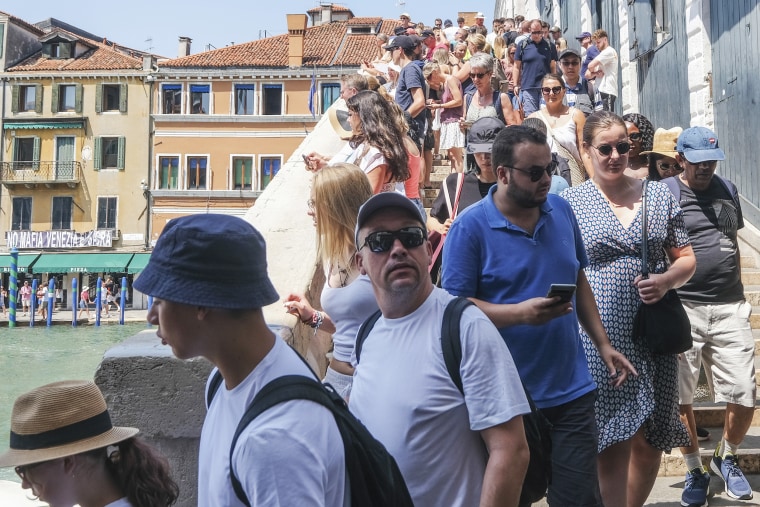
Others, like tourist guide Luisella Romeo, said they were concerned about the use of personal data collected by the new system. “That’s an invasion of privacy. Those details will remain in the system for five years and could be given to third parties, public and private,” she said.
But officials in the city, which narrowly escaped being placed on UNESCO’s “World Heritage in Danger” list last year, in part because the United Nations body decided that it was not addressing concerns that its delicate ecosystem risked being overwhelmed by mass tourism, have insisted that something needed to be done.
Three years ago, large cruise ships were banned from sailing into the Venetian lagoon , and the city has also announced limits on the sizes of tourist groups.
While the charge in Venice is still in its experimental stage, other popular Italian tourism destinations, like Lake Como, which has struggled with overcrowding for years, are watching closely.
Only time will tell whether it ends up dead in the water.
Claudio Lavanga is Rome-based foreign correspondent for NBC News.

IMAGES
VIDEO
COMMENTS
The best time to visit Venice is during the spring when the weather is beautiful but not too hot, and you can avoid the worst of the summer crowds. Two main factors affect trip planning to Venice—the weather and crowds. During peak season, the city can receive over 100,000 tourists per day. The city's climate calendar is also marked by extreme weather events, from hot, muggy summers to ...
The best time to visit Venice is from September to November when tourists desert the city. Although the temperatures - which range from the upper 30s to mid-70s - necessitate some layers, the ...
By Rick Steves and Gene Openshaw. Venice's best travel months (also its busiest and most expensive) are April, May, June, September, and October. Summer in Venice is more temperate (high 70s and 80s) than in Italy's scorching inland cities. Most Venetian hotels come with air-conditioning — important in the summer — but it's usually ...
November to February is the best time for budget travelers. With the exceptions of Christmas and New Year's Eve, the colder months are as empty as they can be in a city like Venice - with school and work in full swing, tourist numbers are much lower than they are in June and July. A lack of travelers doesn't mean the city is less lively.
Venice in May. Along with April, May is one of the best months weatherwise to visit Venice. Temperatures of around 21°C (70°F) are perfect for wandering about the city before the summer heat kicks in. This is also a good time to explore some other islands and cities in Veneto before they're completely overwhelmed.
Weather in Venice in May. Mayis probably one of the best times to visit Venice. The weather is warm but not yet hot, allowing you to explore the city's narrow streets and countless bridges for long periods. The city is alive with colour, from fresh greenery to clear blue skies, perfect for leisurely gondola rides.
The fall is a lovely time to visit Venice, but it is also when the acqua alta (flooding, or literally "high water") is more likely to occur. October through January is the typical high water season, though flooding can occur at any time during the year. Venice's location, in northern Italy on the Adriatic Sea, means that the city has colder ...
However, the best time to visit Venice can vary greatly depending on your preferences. Some prefer the bustling energy of the peak season, while others seek the tranquility of fewer crowds. Factors such as weather, hotel rates, and key events also play a significant role in determining the ideal time for your visit.
When to visit Venice if you are traveling on a budget. From November to January is the best time to visit Venice on a budget. Hotel rates are lower and the city is less crowded. Of course, you should avoid the last weeks of December for obvious reasons. Please explore our guide on how to stay in the city to save some money.
The Best Time to Visit Venice. Before we dive into the different traveling seasons of Venice, we thought it would be helpful to start this guide with the overall best time to visit. Spring and late summer are largely considered the best times to visit Venice. This is due to the pleasant weather and reduced number of tourists, which makes the ...
The best time to go to Venice is April, May, September, and October. Best Time for Sightseeing: Mid-spring, and particularly the first half of May, is the very best time to enjoy sightseeing in Venice. The cold of winter has lifted and the sun makes a daily appearance, while temperatures are comfortably warm.
Peak Season in Venice. (Late May-August) Peak season (or high season) in Venice runs from late May to August when the average temperature is warmest, and the city experiences the least rain. This is the most popular time to visit Venice, so expect high prices and large crowds. Book your hotel and flights well in advance if you plan a trip to ...
Additionally, workshops like the Enrica Rocca Cooking School and iconic sites such as the Doge's Palace offer immersive experiences. Spring truly is a delightful time of the year to experience the magic of Venice. Read Also: Top 20 Best Museums In Mexico City To Visit. Summer: The Vibrant Season in Venice
The best time to visit Venice is from September to November when tourists desert the city. Although the temperatures - which range from the upper 30s to mid-70s - necessitate some layers, the ...
The best time to visit Venice is during spring months. Spring offers favorable temperatures ideal for sightseeing, especially in May. In May, the cold of winter diminishes and days are comfortably warm. The Carnival of Venice is one of the biggest celebrations in Italy, occurring each year in February. Though February is a cooler month in ...
Best Time to Visit Venice by Month Venice in January. Weather: Max Temp: 7°C Min Temp: 0°C Rainy days: 10. January is the coldest month of the year in Venice and the perceived temperature can be considerably lower due to high humidity. Events in Venice in January: Jan 6th: Epiphany. The main event is the so-called "Befana Boat Race ...
What is the best time to visit Venice? April, May, September and October are the best months to visit Venice, with temperatures ranging between 10°C to 25°C. These months mark the peak of Spring and Fall, respectively. They are devoid of the winter cold and experience plenty of warm sunshine.
Venice, the city of canals makes for a great travel destination year round. Whether you're planning to make it in time for the Venice Carnival or you're looking to steer clear of the acqua alta, this guide will give you an idea of the best time to visit Venice.You can also glance through what happens in Venice every month of the year and what makes Venice a year-round delight.
Fall in Venice. Fall, from October to November, is a great time to visit Venice. The temperatures are pleasant, and there are fewer crowds. The average temperatures range from 50° F to 68°F (10°C to 20°C). You can also experience some rainfall during this season, but it's not as frequent as in the spring.
In Venice, the climate is very pleasant from April to October.Indeed, it is during this period that temperatures are the highest and the sun is most often shining. However, the best time to visit Venice is in the early autumn, during the months of September and October.After the summer, tourists leave the city and you can enjoy a gondola ride in a quieter atmosphere.
12. Pack light. Out of all the Venice travel tips I'm sharing in this post, packing light is possibly the most important. I get it - maybe you want to bring a bunch of ballgowns for the most epic photoshoot of your life… or maybe you need space to hoard magnets. Either way, you might need to rethink how much you bring.
This monthly breakdown provides a detailed guide for choosing the best time to visit Venice based on your preferences, whether you seek a bustling Carnival, a serene autumn, or a quiet winter retreat. Remember that Venice's exceptional appeal can be appreciated all year, and each season offers something uniquely great to investigate. ...
A getaway to Venice or Lake Como, for instance, can see temperatures in the 60s and 70s even during June, July, and August. ... The Best Time to Visit Colorado for Good Weather, Affordable Prices ...
Last November, Venice authorities unveiled a pilot program for their long-mooted plan to charge day-trippers to visit the city. Today (25 April) the pilot programme has finally come into force.
Venice tourist tax. The lagoon city has introduced 5 euros (about $5.35) tickets for day trippers, valid from 8:30 a.m. to 4 p.m. The experiment came into force on April 25, a national holiday in ...
The "Venice access fee" costs €5 (£4.30). It could be worse - when the idea was first suggested it was €10. Only day trippers have to pay. Residents, commuters, students and children ...
VENICE, Italy — Under the gaze of the world's media, the fragile lagoon city of Venice launched a pilot program Thursday to charge day-trippers a 5-euro (around $5.35) entry fee that authorities ...
Venice Access Fee. By the way, if you are planning a trip to Venice during May, June and July, you may have to pay to enter Venice. On April 25th, the city of Venice initiated the Venice Access ...
For 2024, city officials have singled out 29 peak days when single-day travelers in Venice between 8:30 a.m. and 4 p.m. have to pay. The days run until mid-July and are mostly on national holidays ...
Venice launches world first tourist entrance fee in bid to fight overcrowding. Day-trippers will have to pay 5 euros ($5.35) to enter the lagoon city on 29 peak days, mostly on weekends, until ...